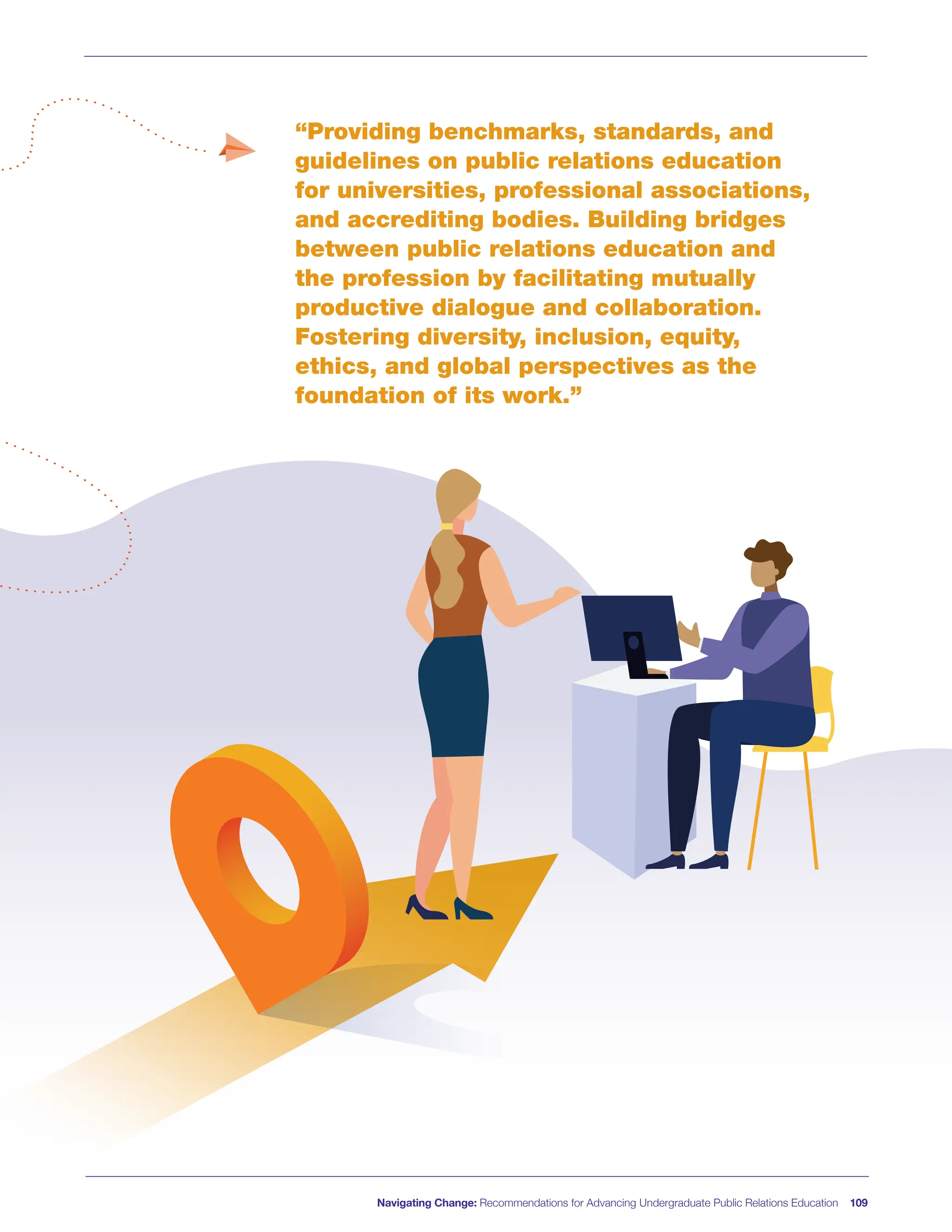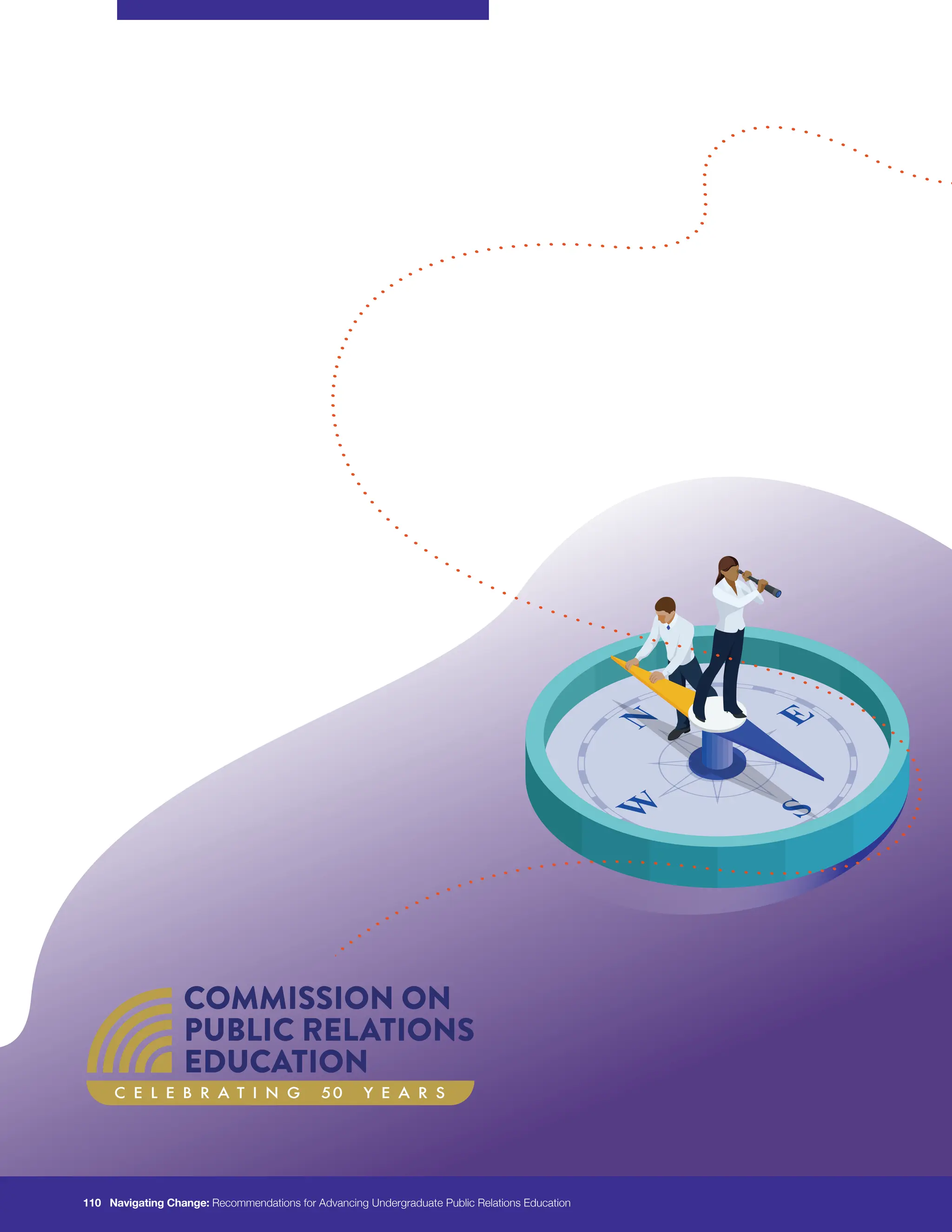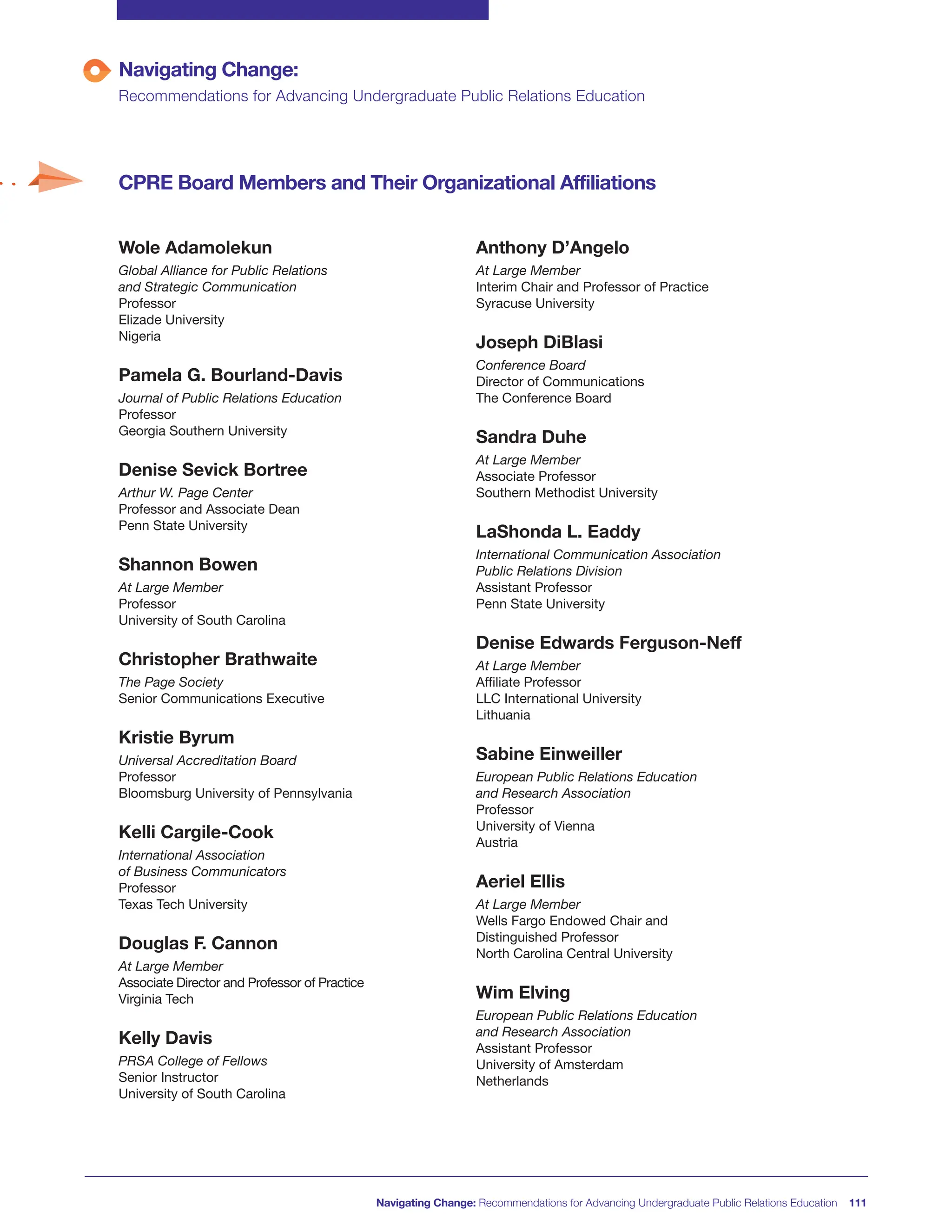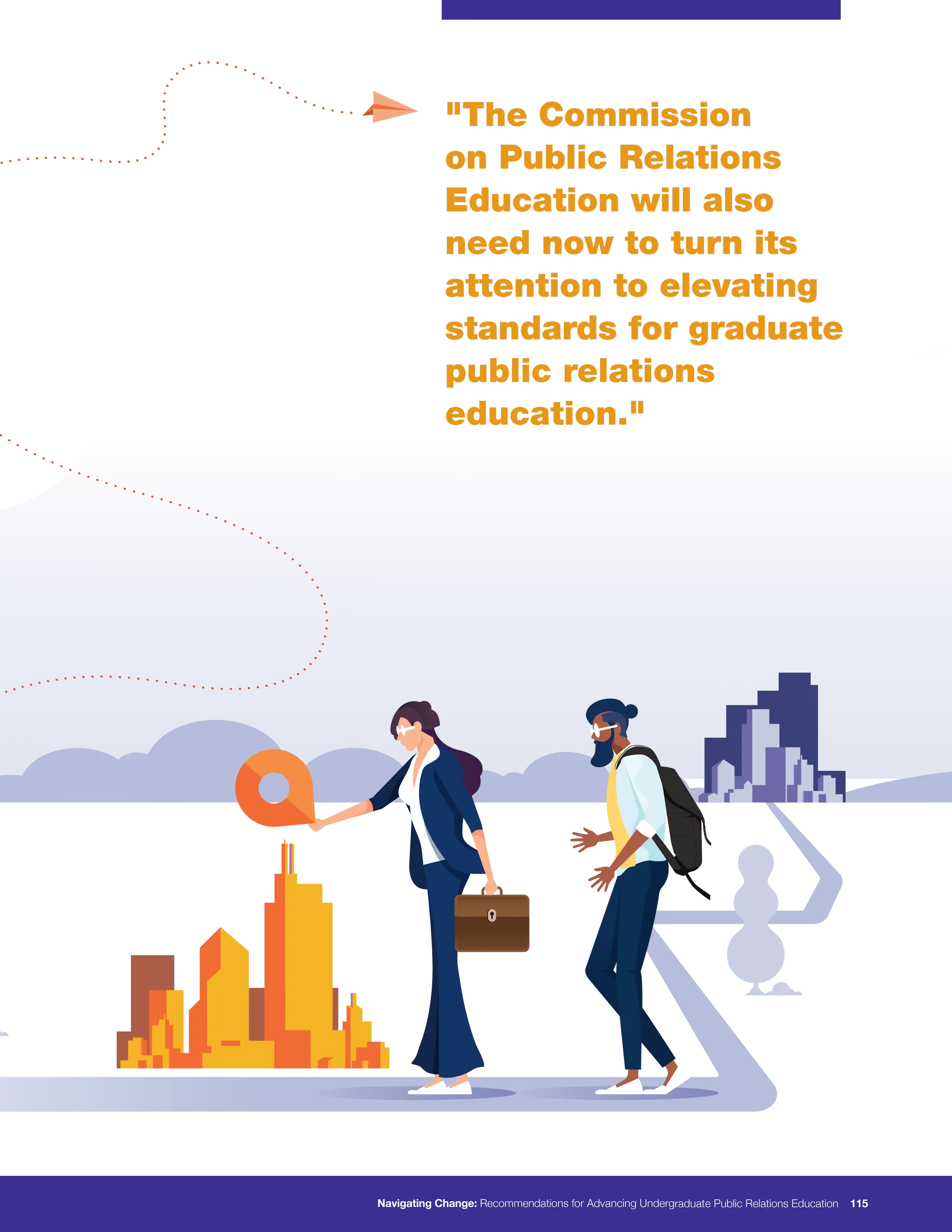This document is the 50th anniversary report from the Commission on Public Relations Education (CPRE). It provides recommendations for advancing undergraduate public relations education based on research including surveys of educators and practitioners. The report finds the field faces challenges from changes in the workplace like hybrid environments and mental health issues, as well as needs for diversity, data strategy skills, and driving social change. It makes recommendations in these areas to help curriculum keep up with industry needs and prepare students for future careers. The report was funded by the Weiss Family Trust and involved extensive input from public relations leaders and organizations.


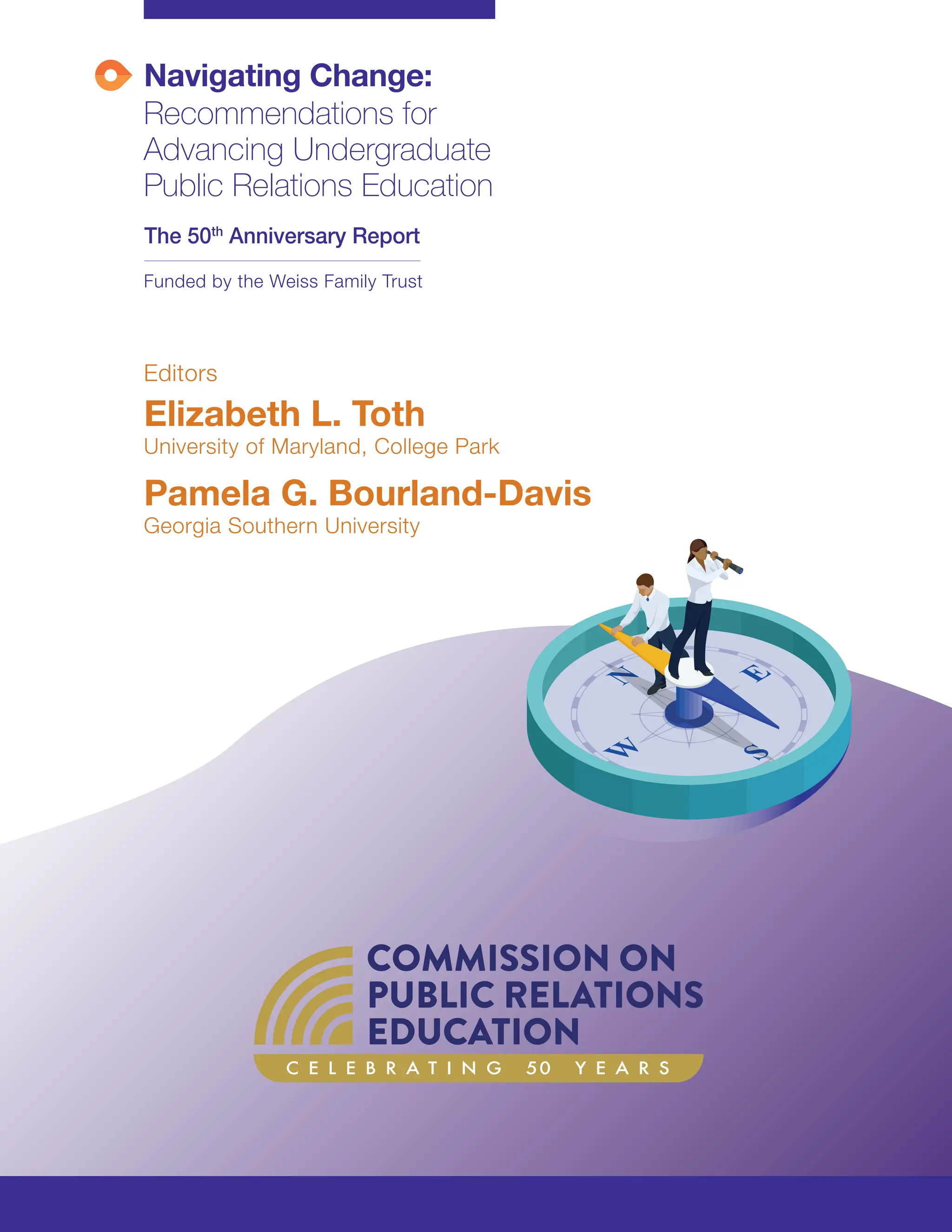
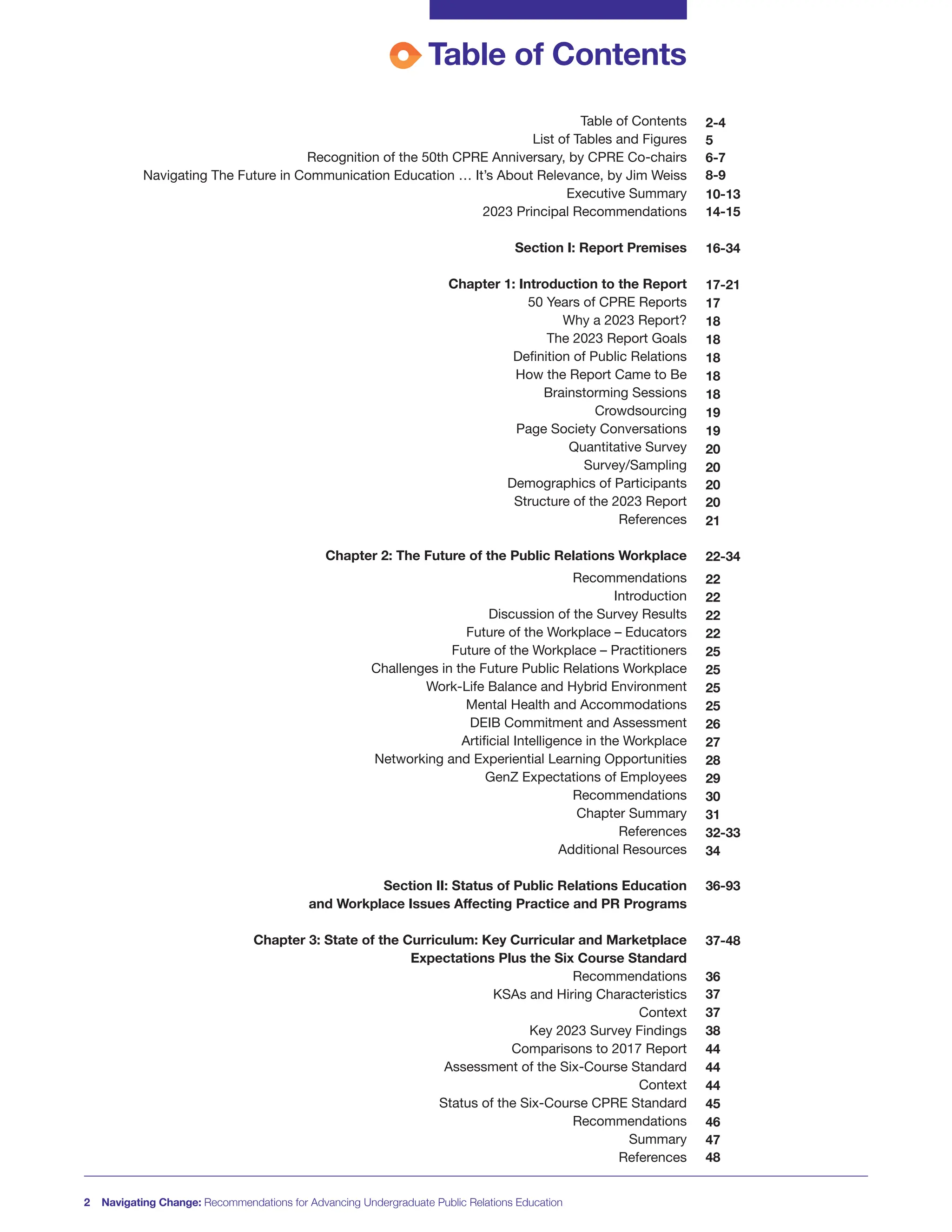
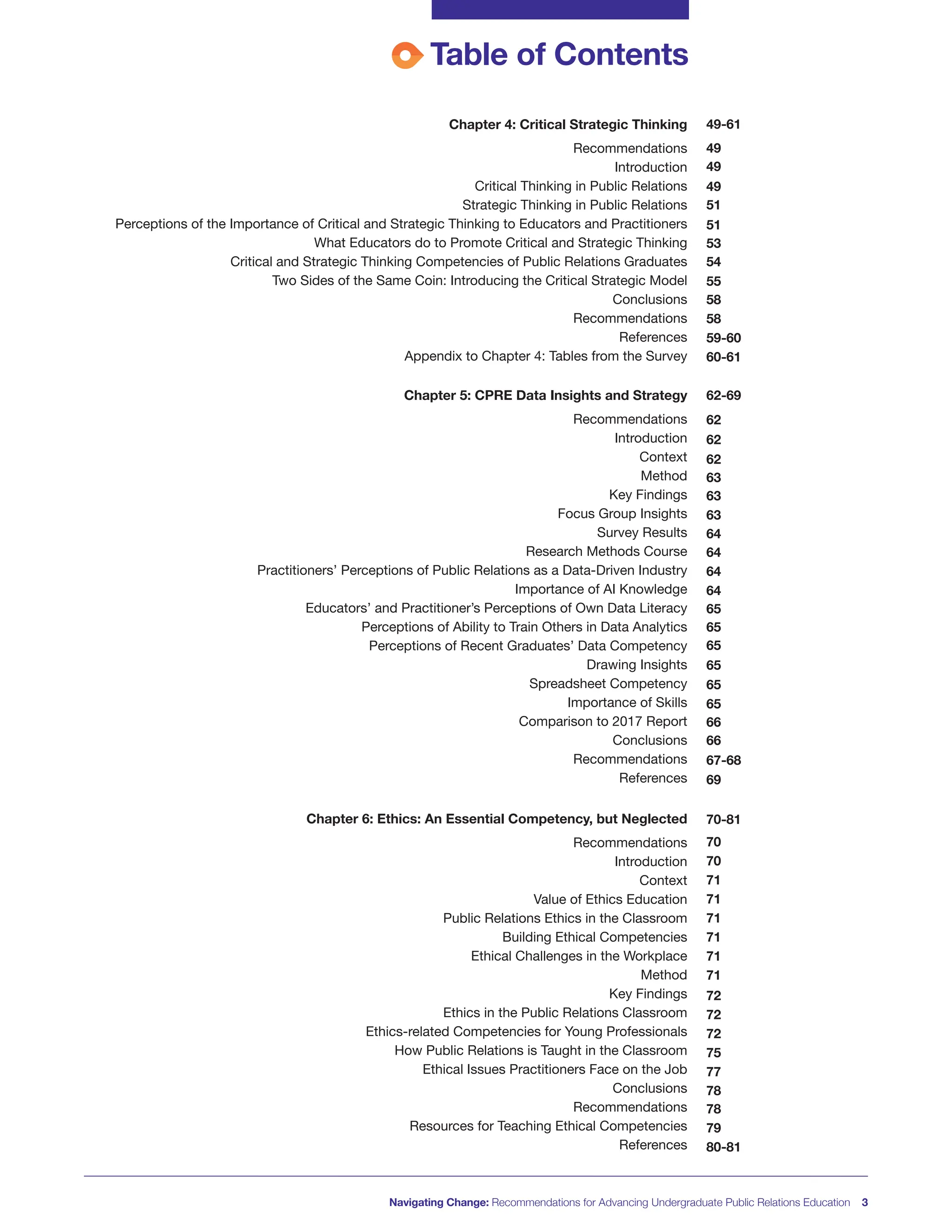
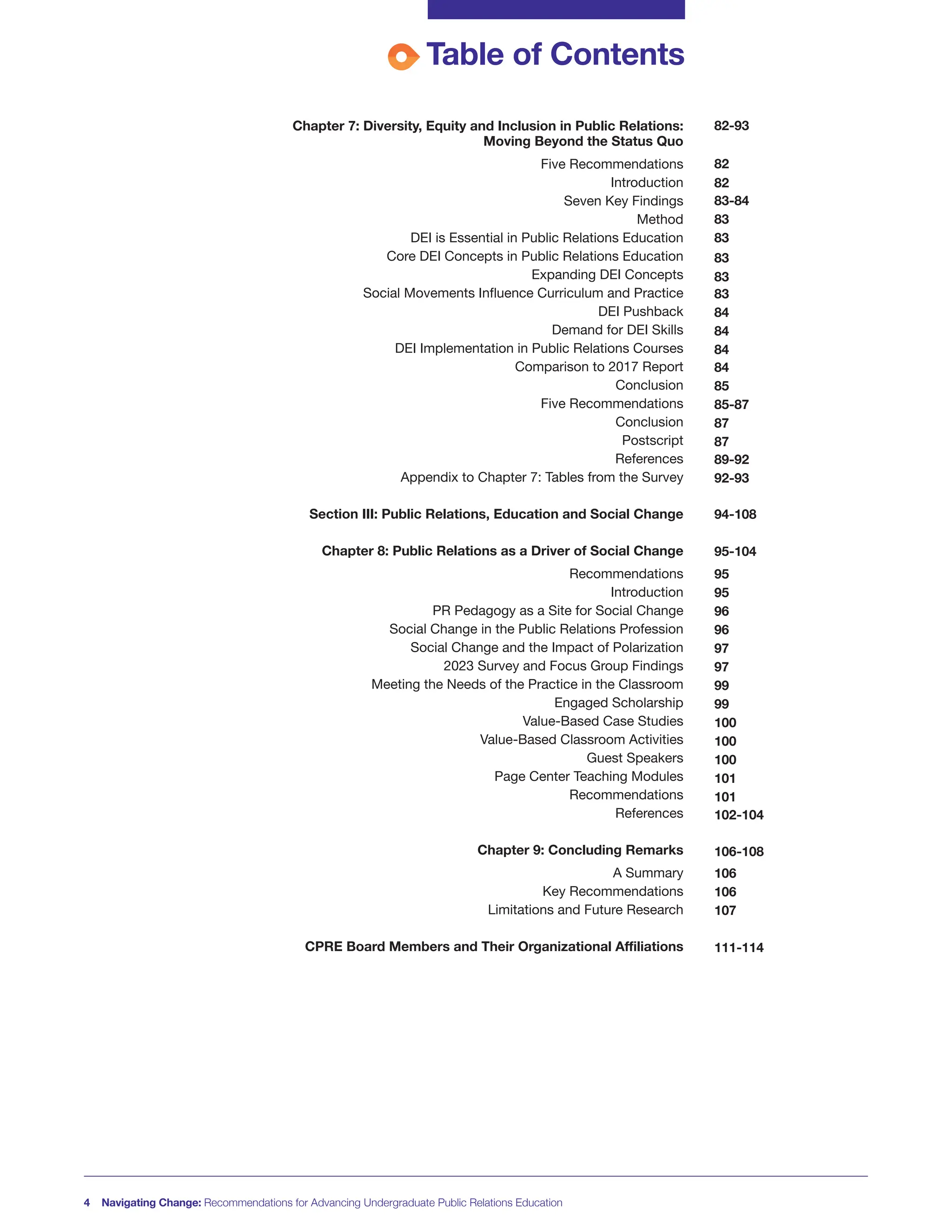

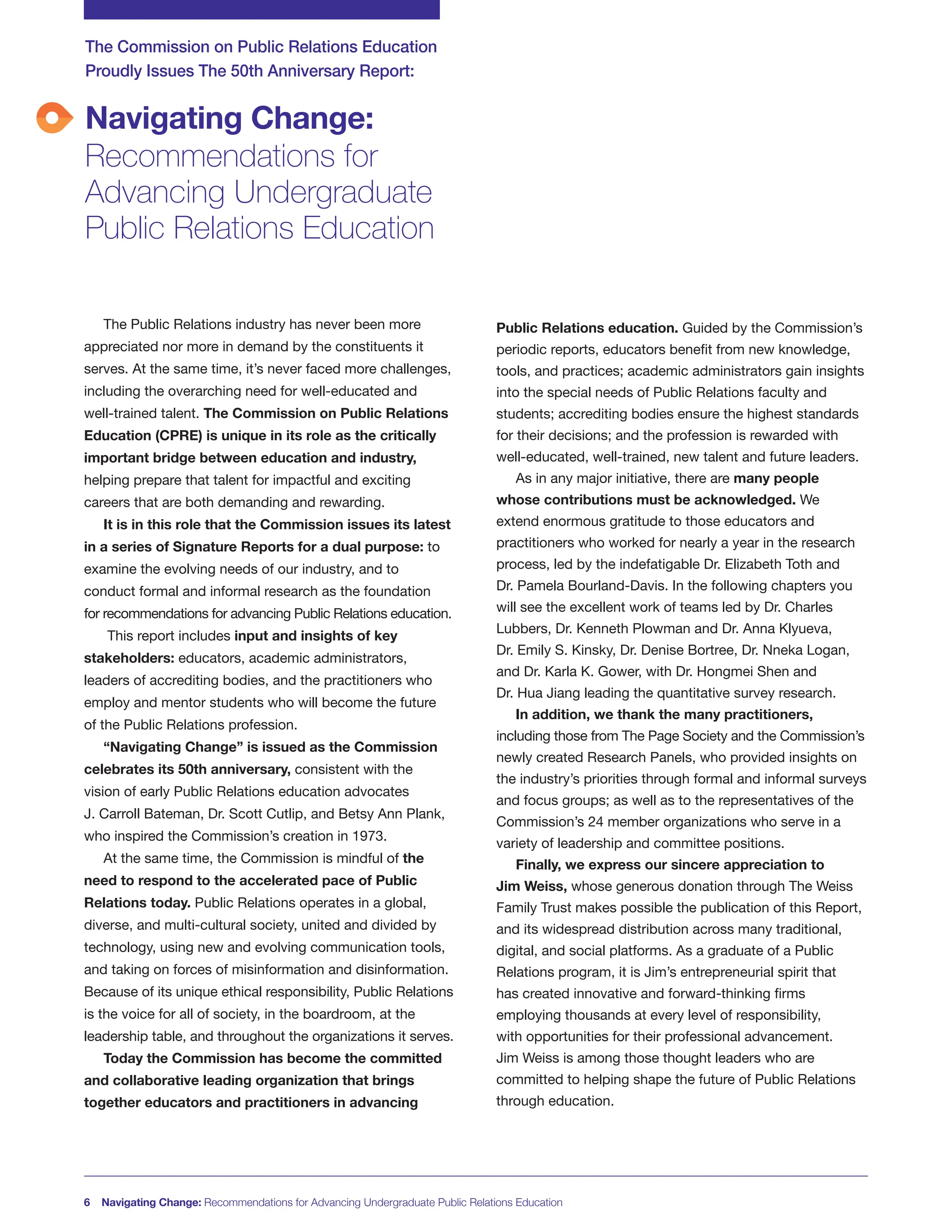
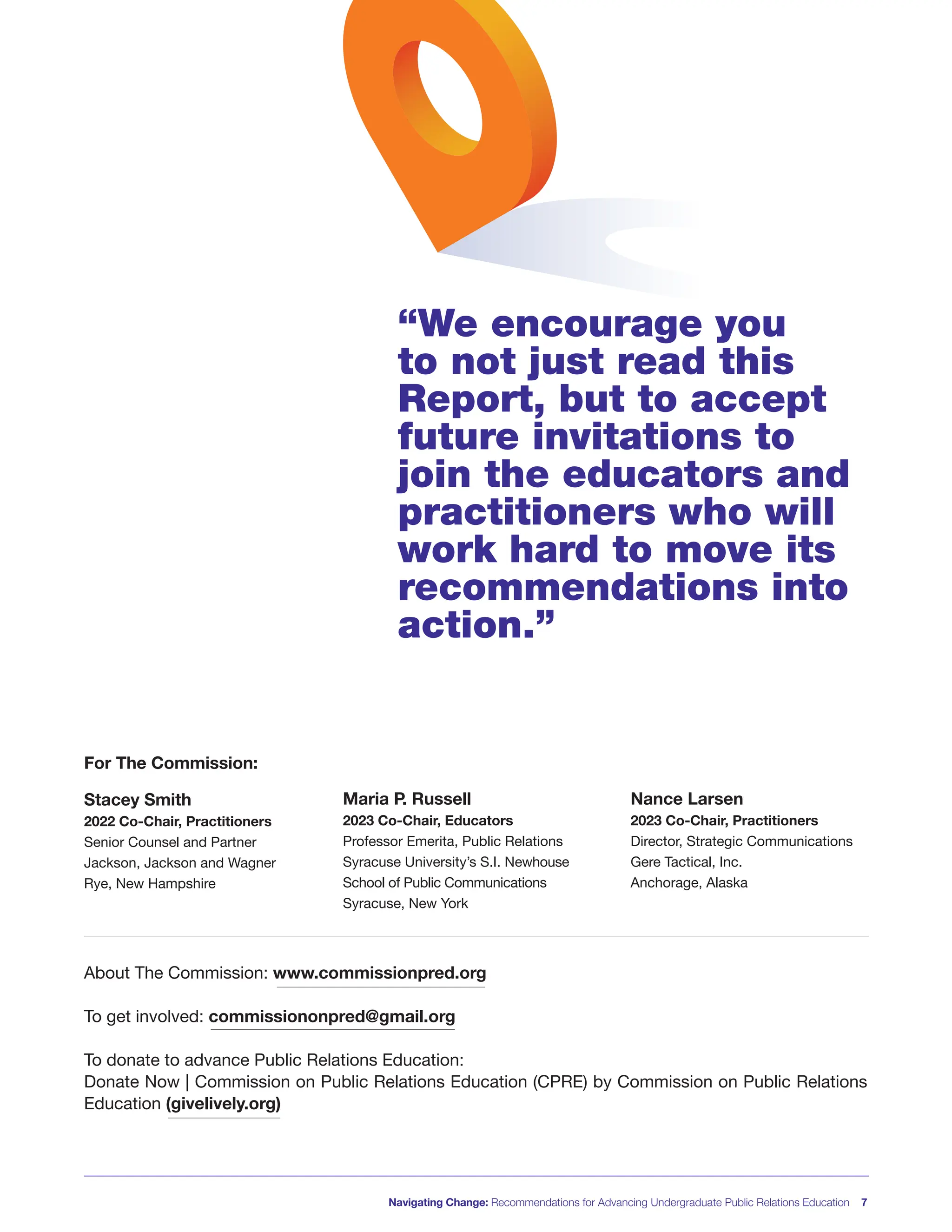
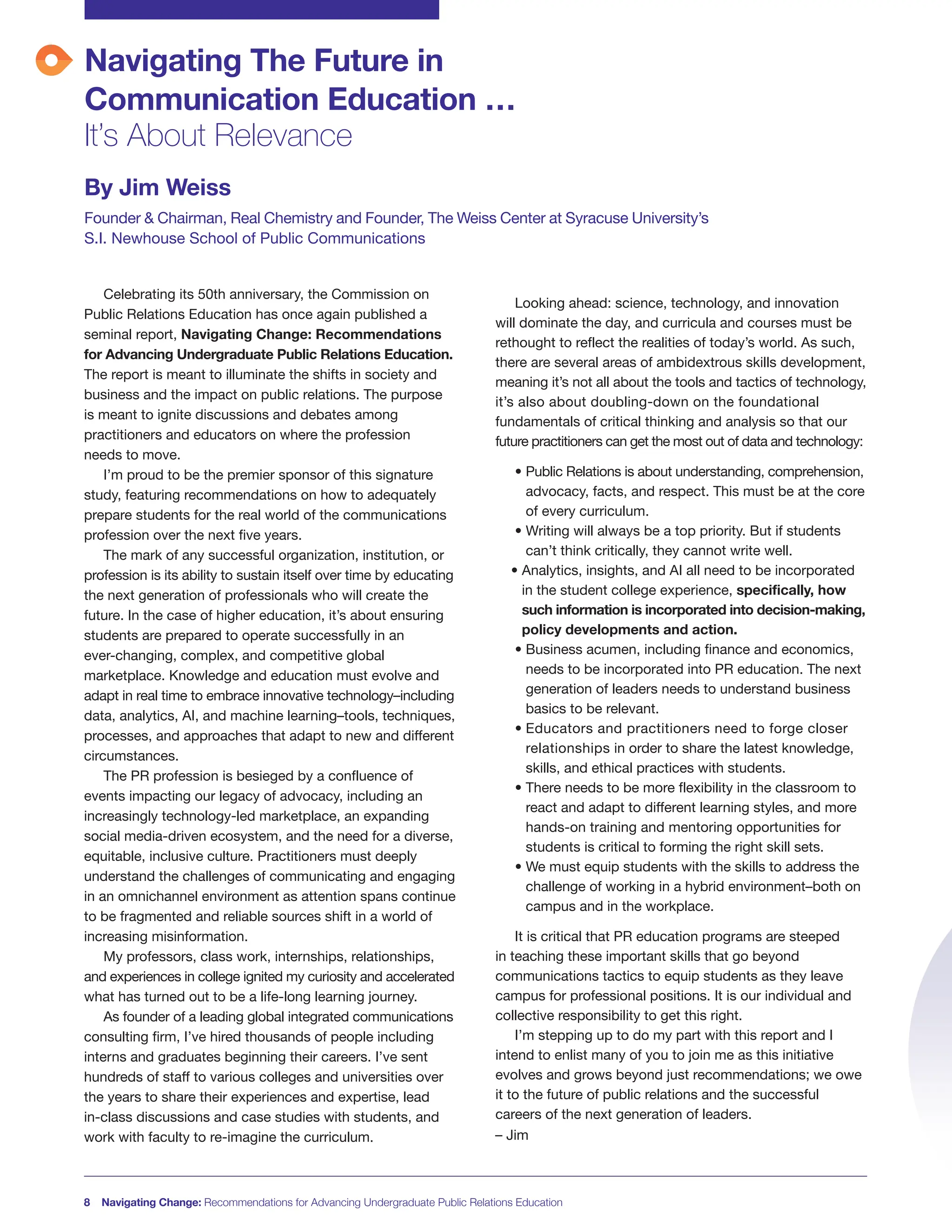
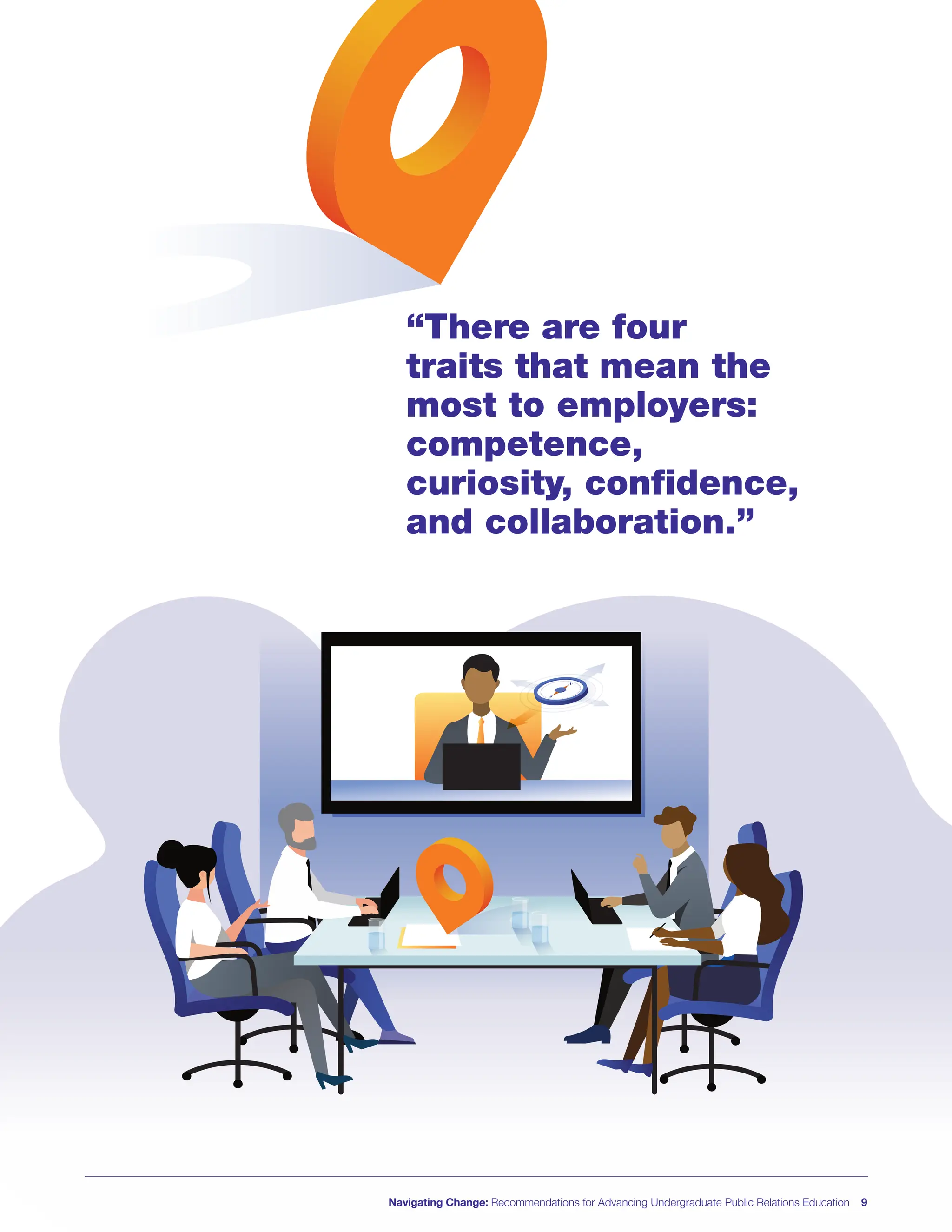

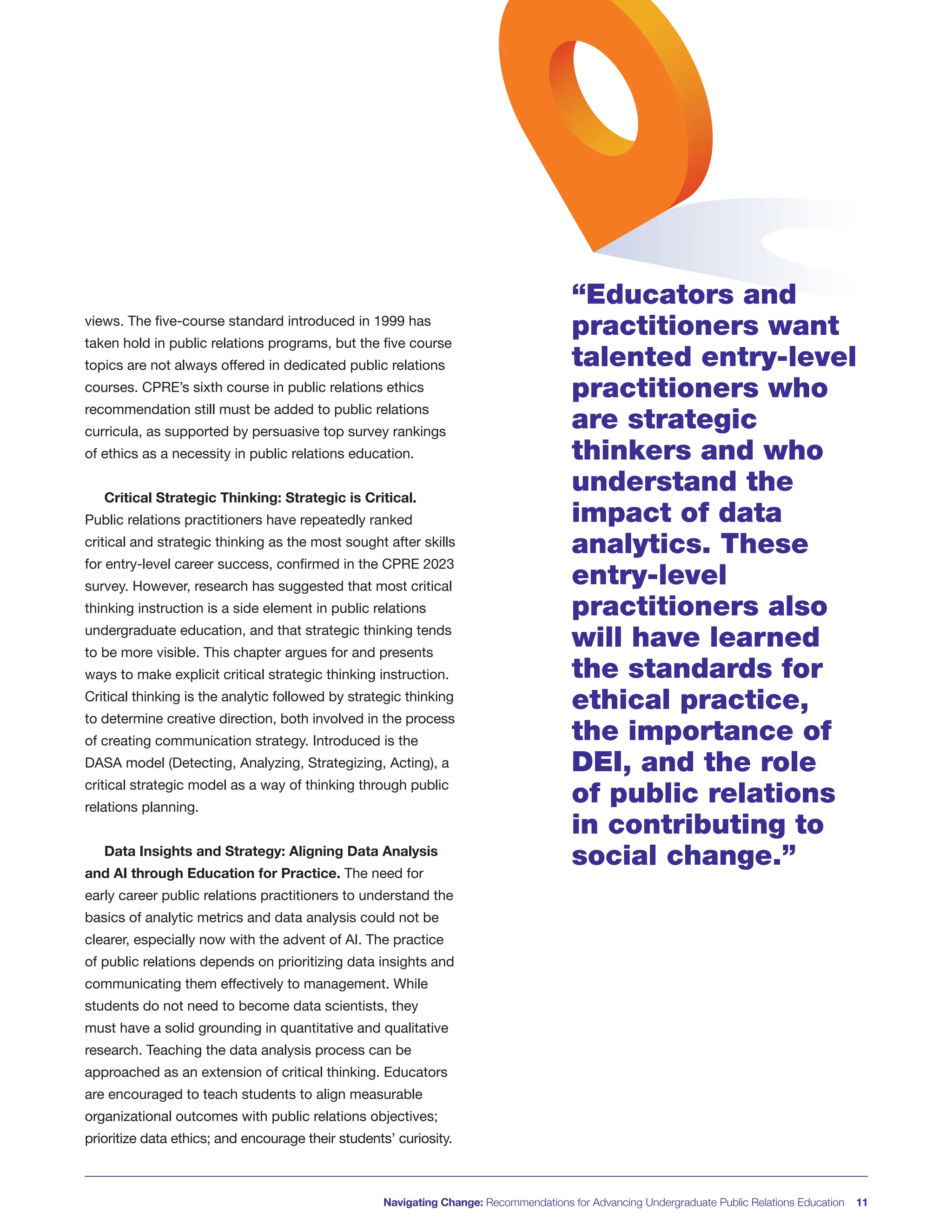
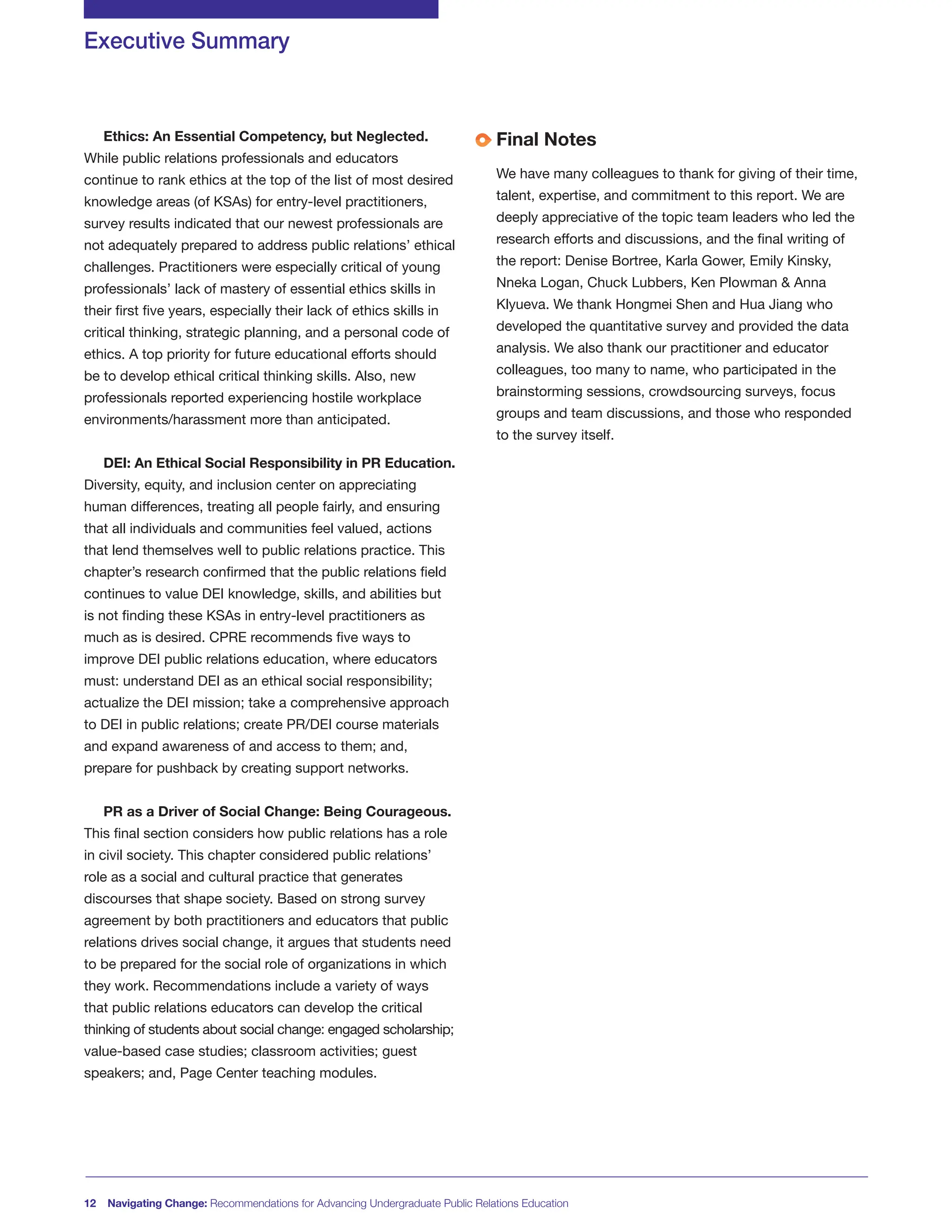
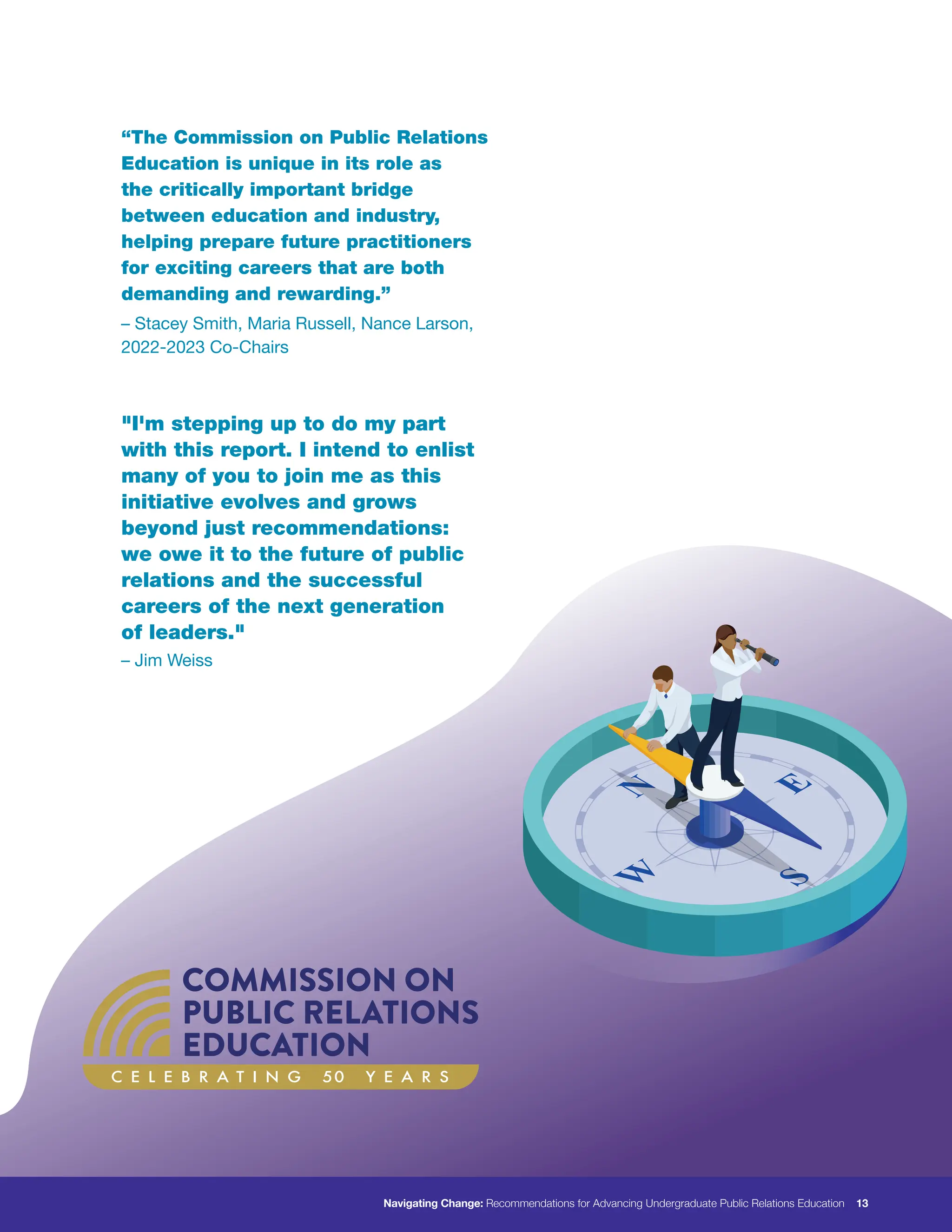
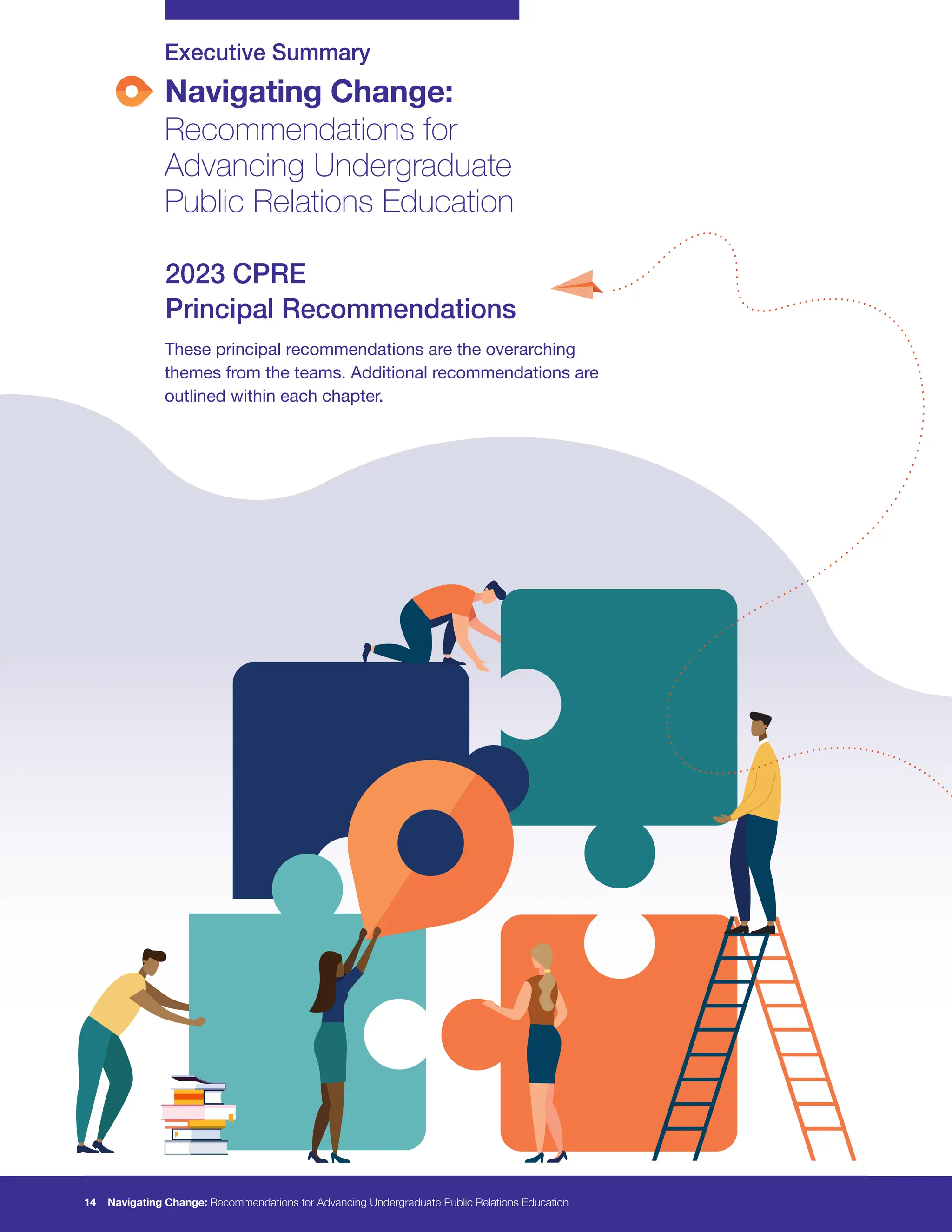
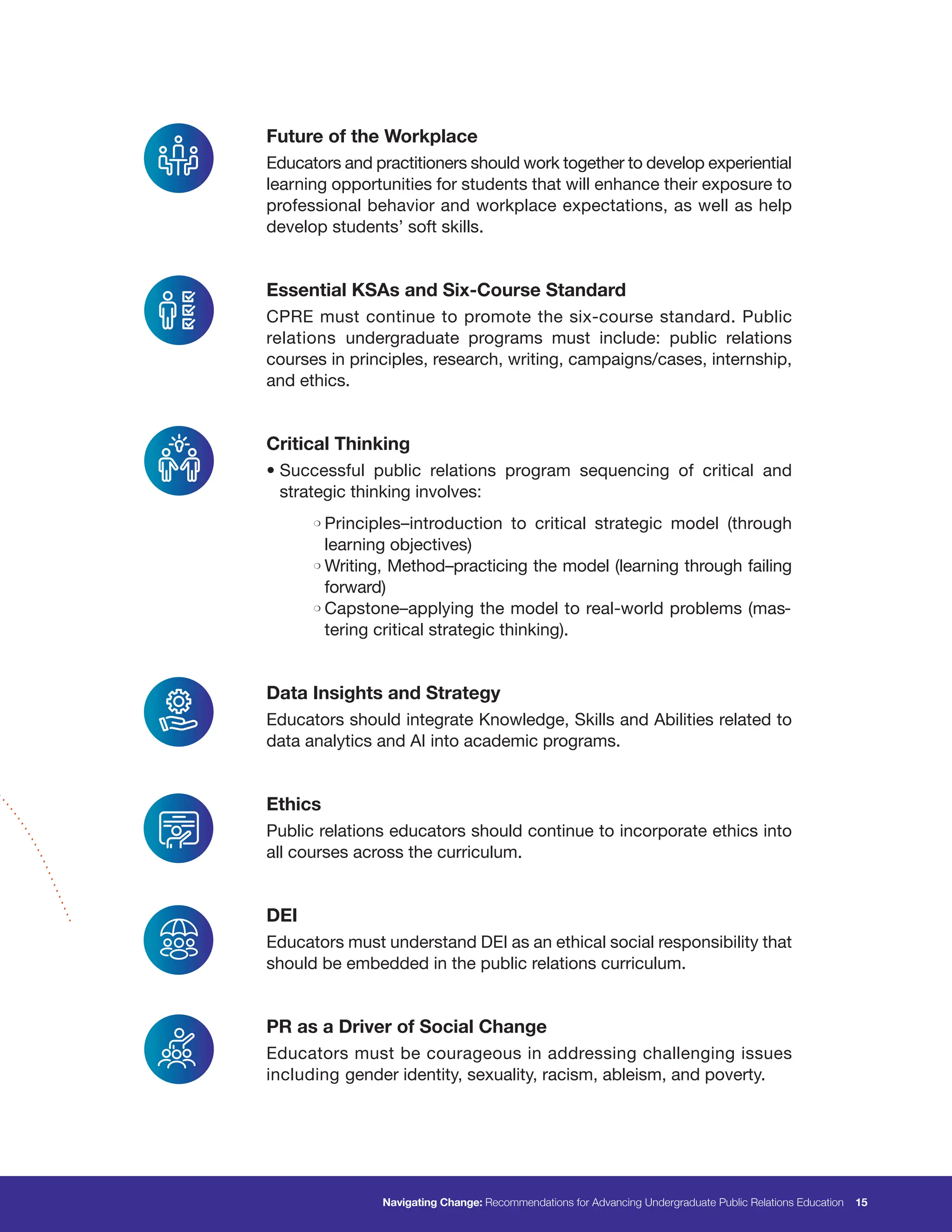
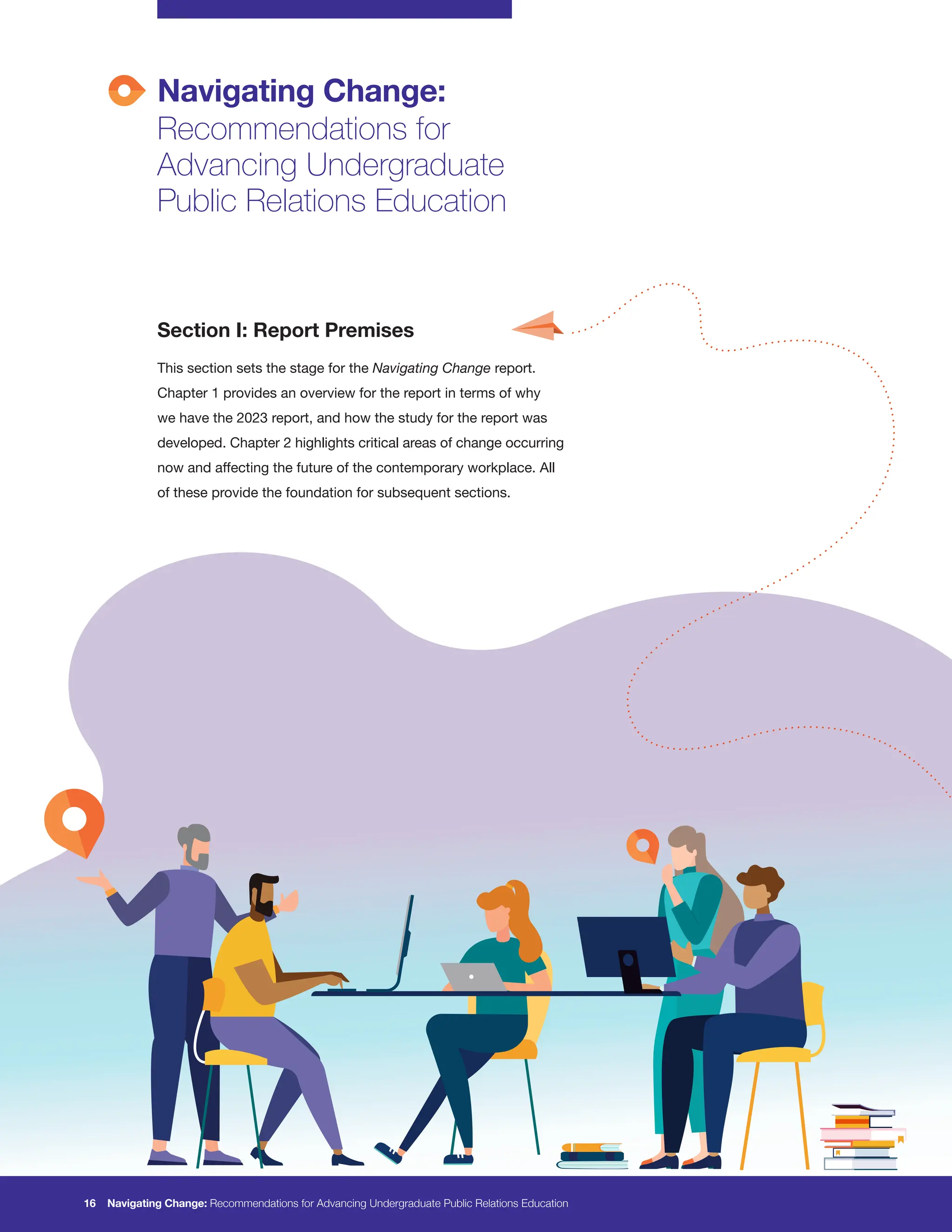
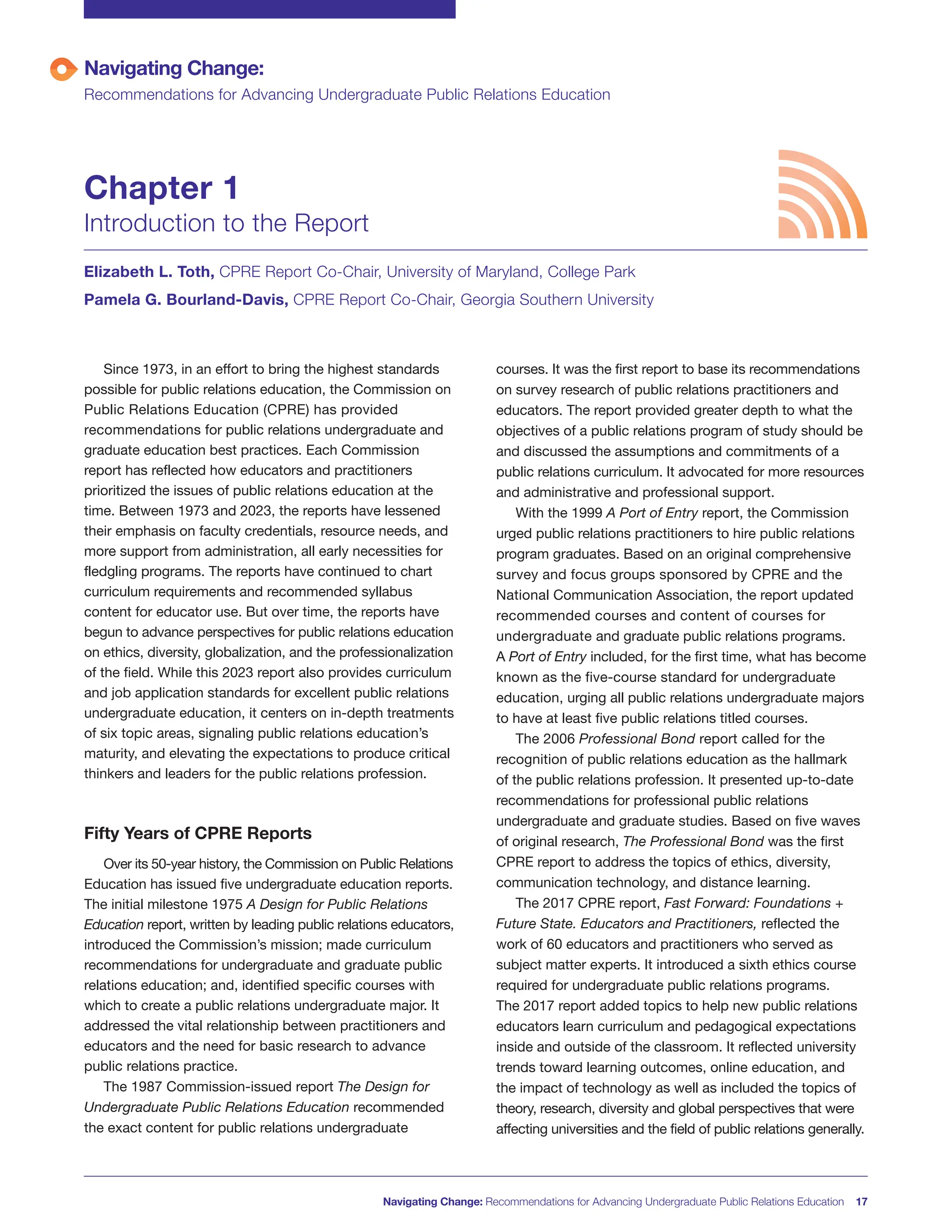
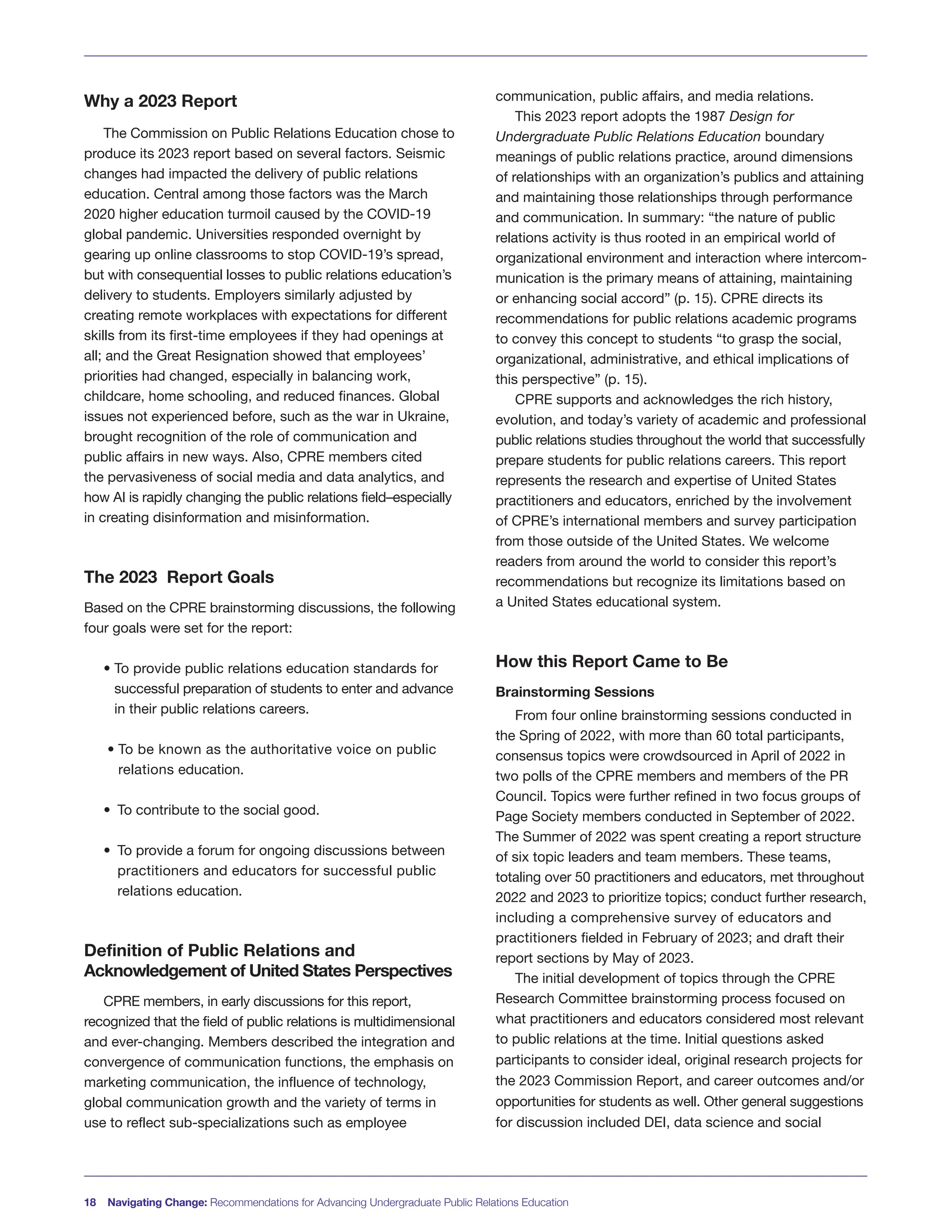

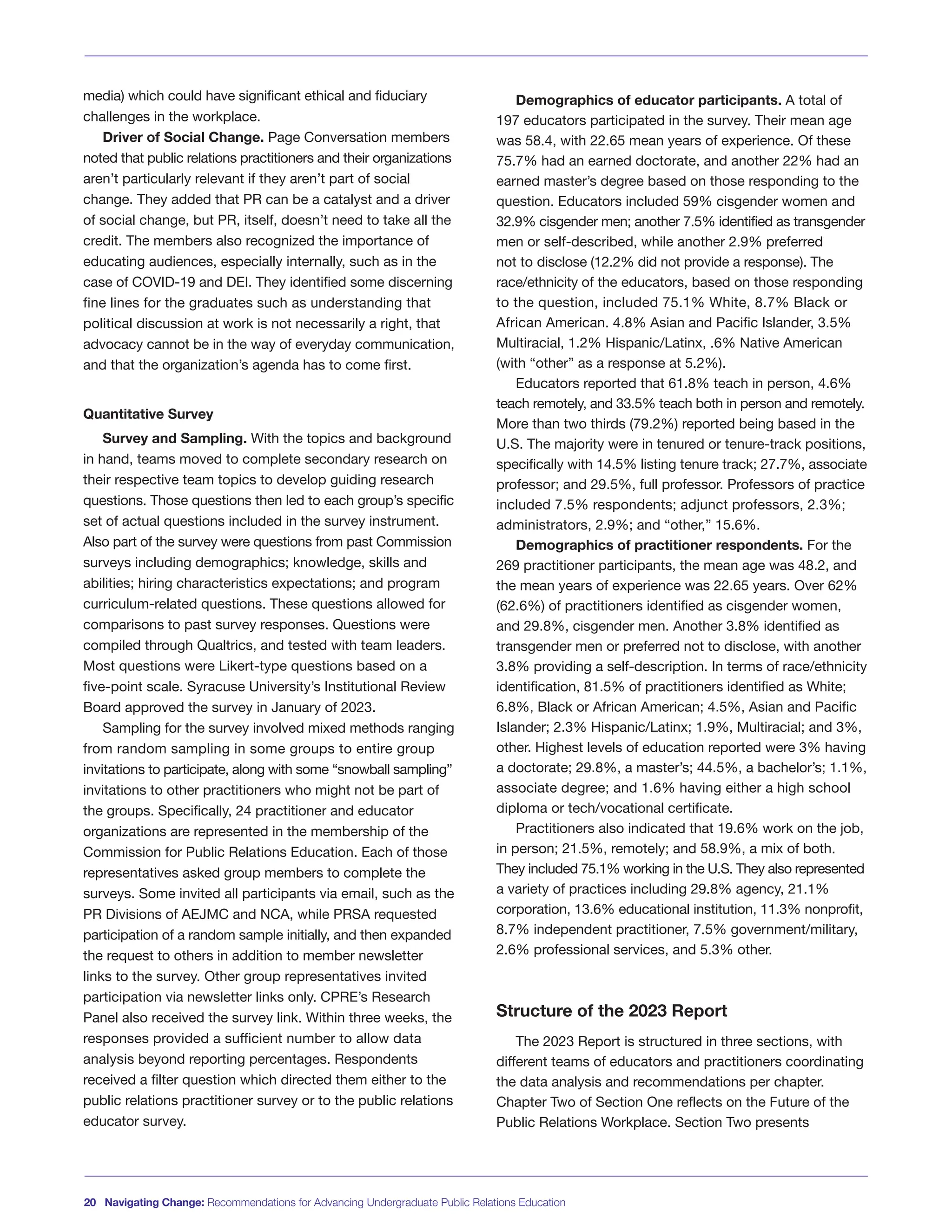

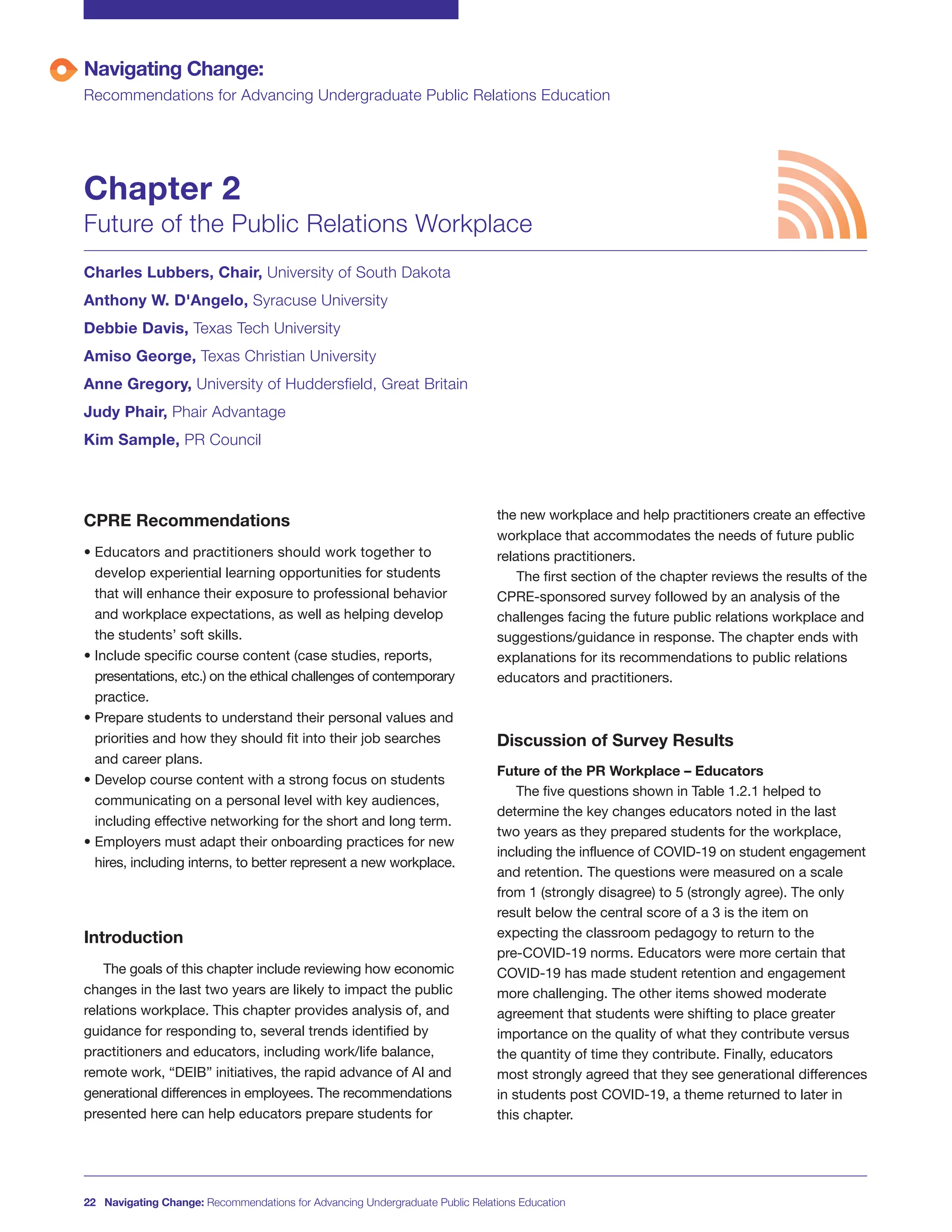


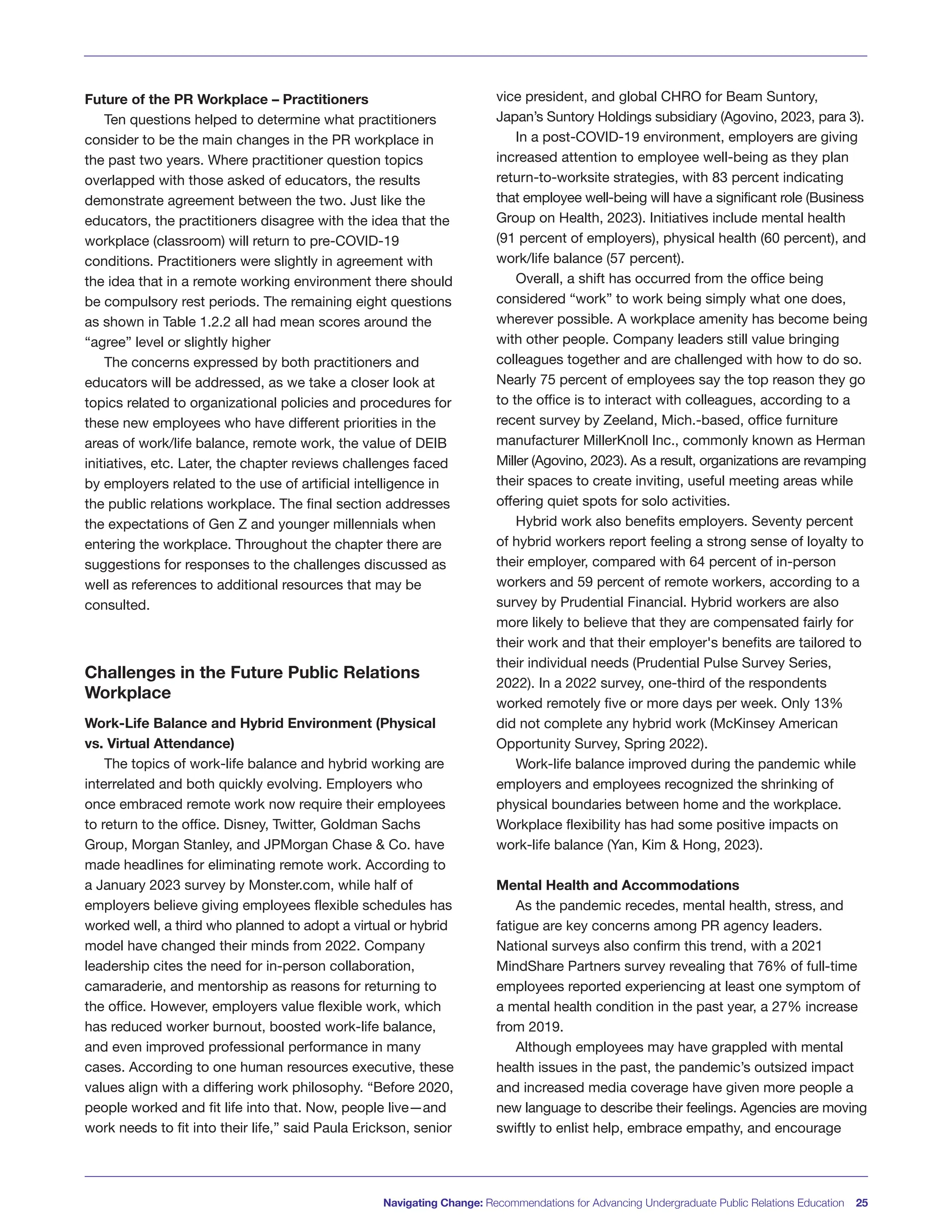
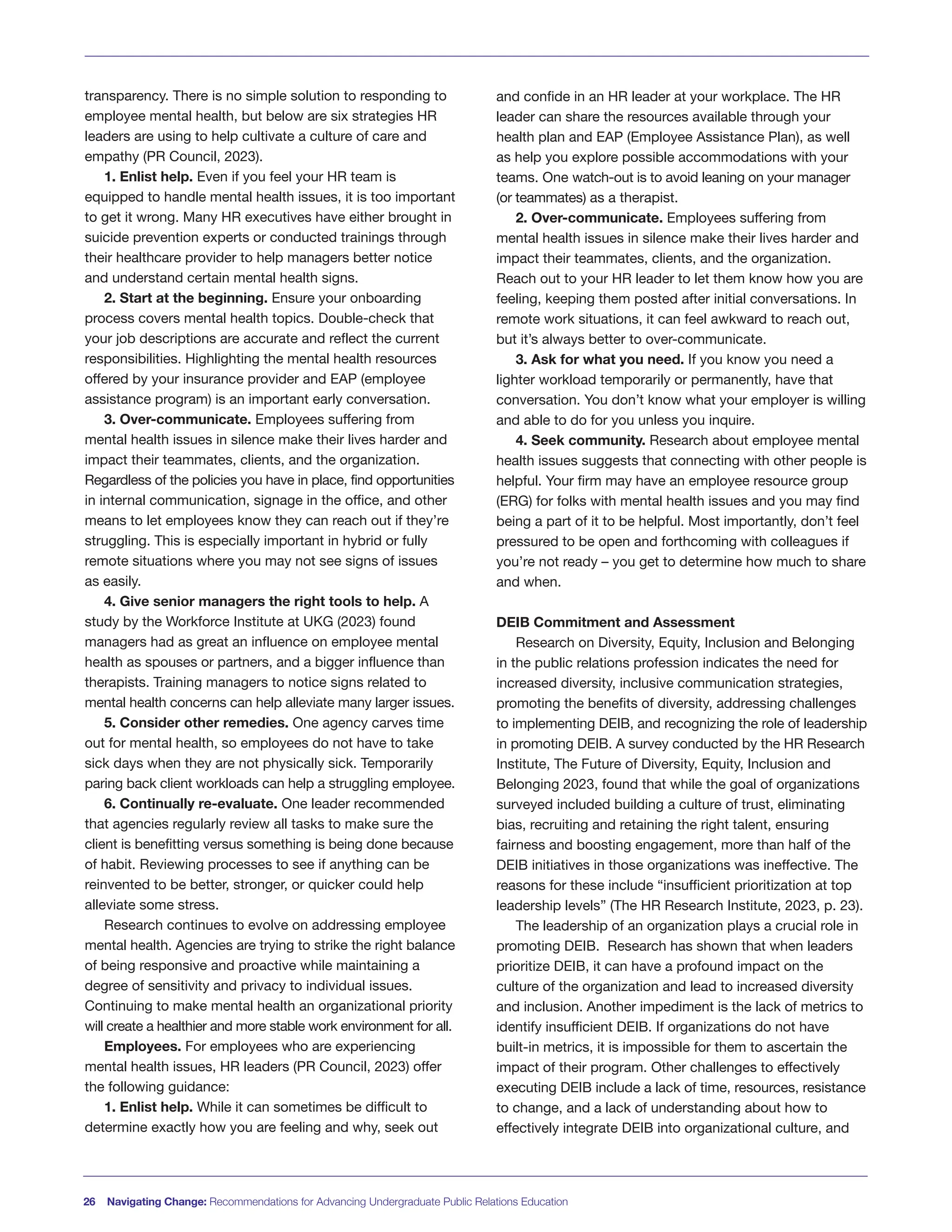



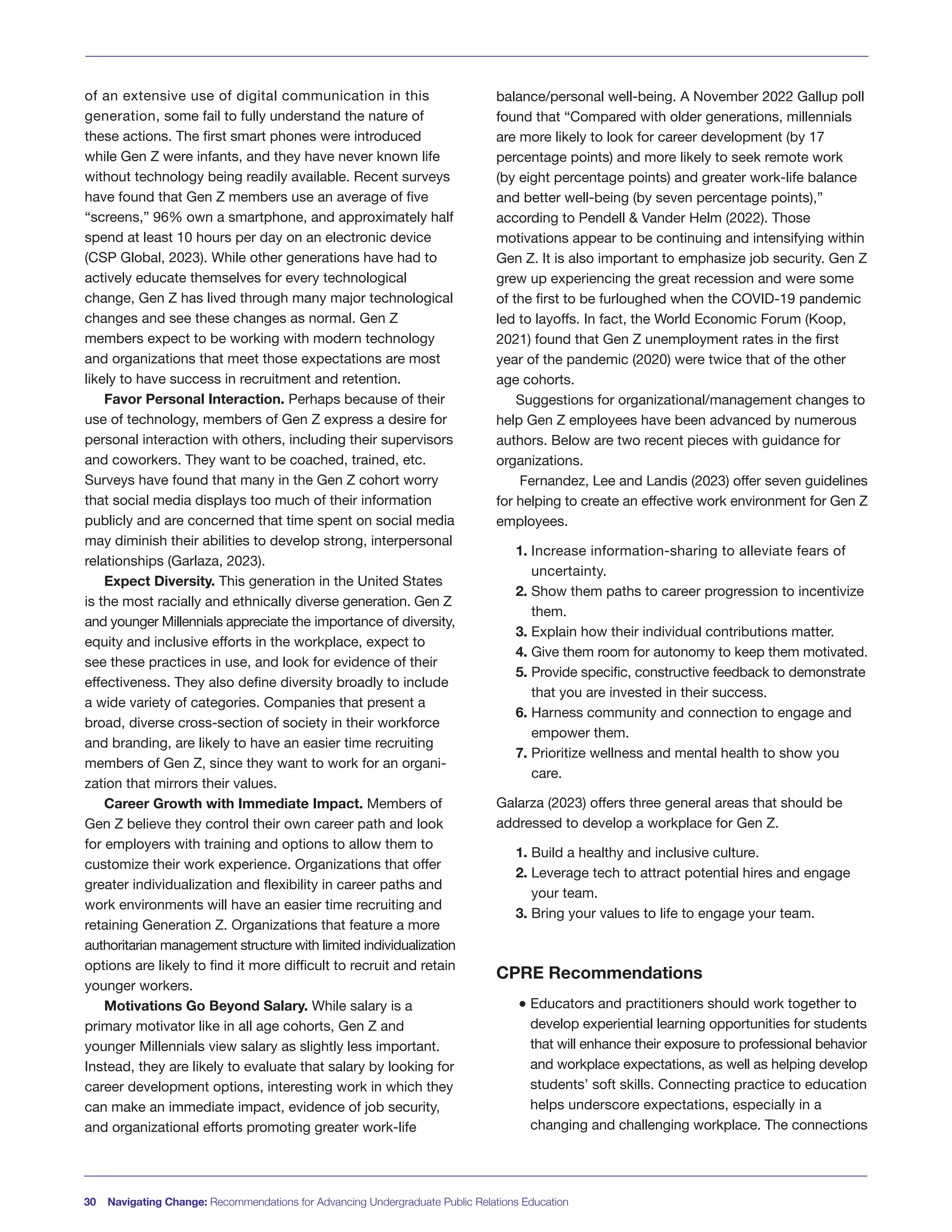
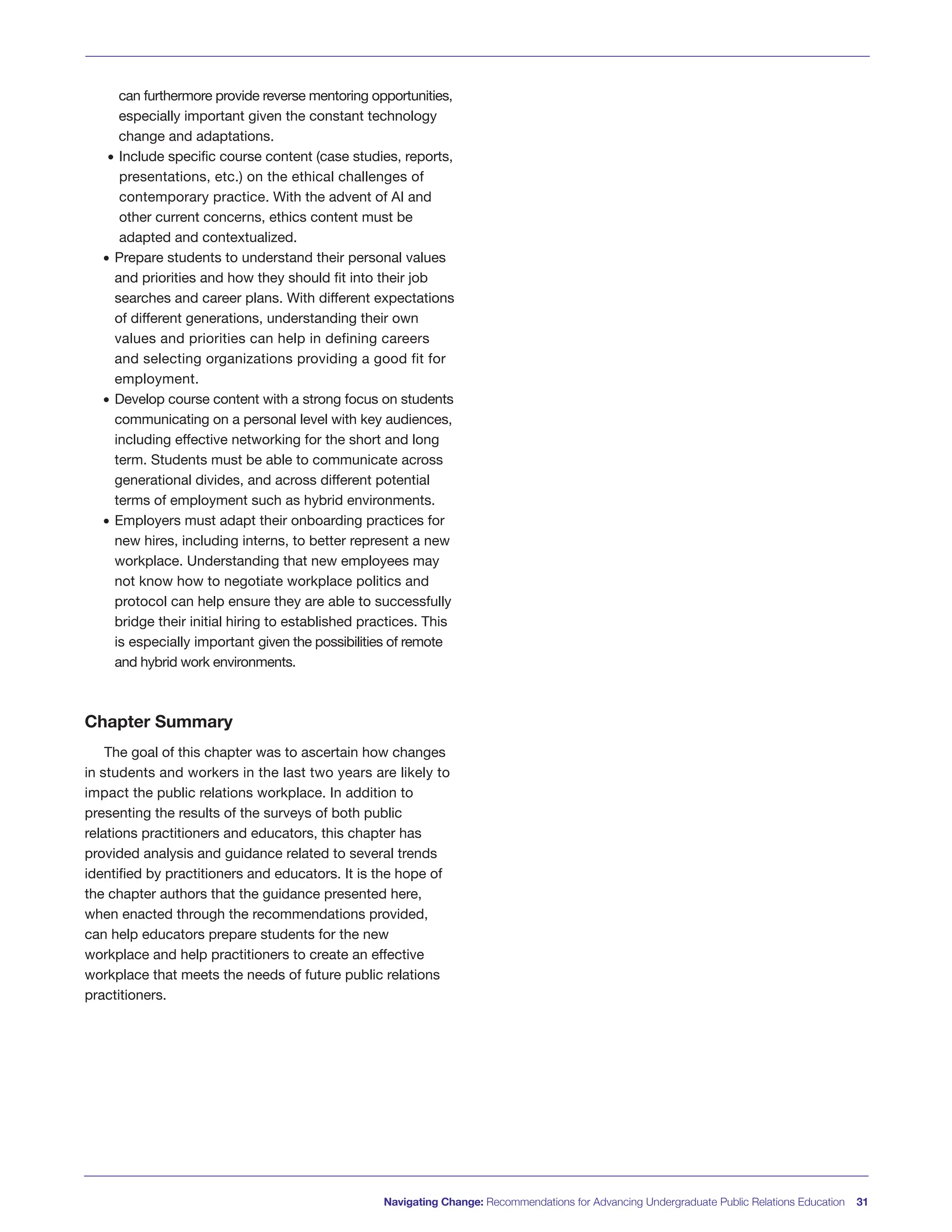
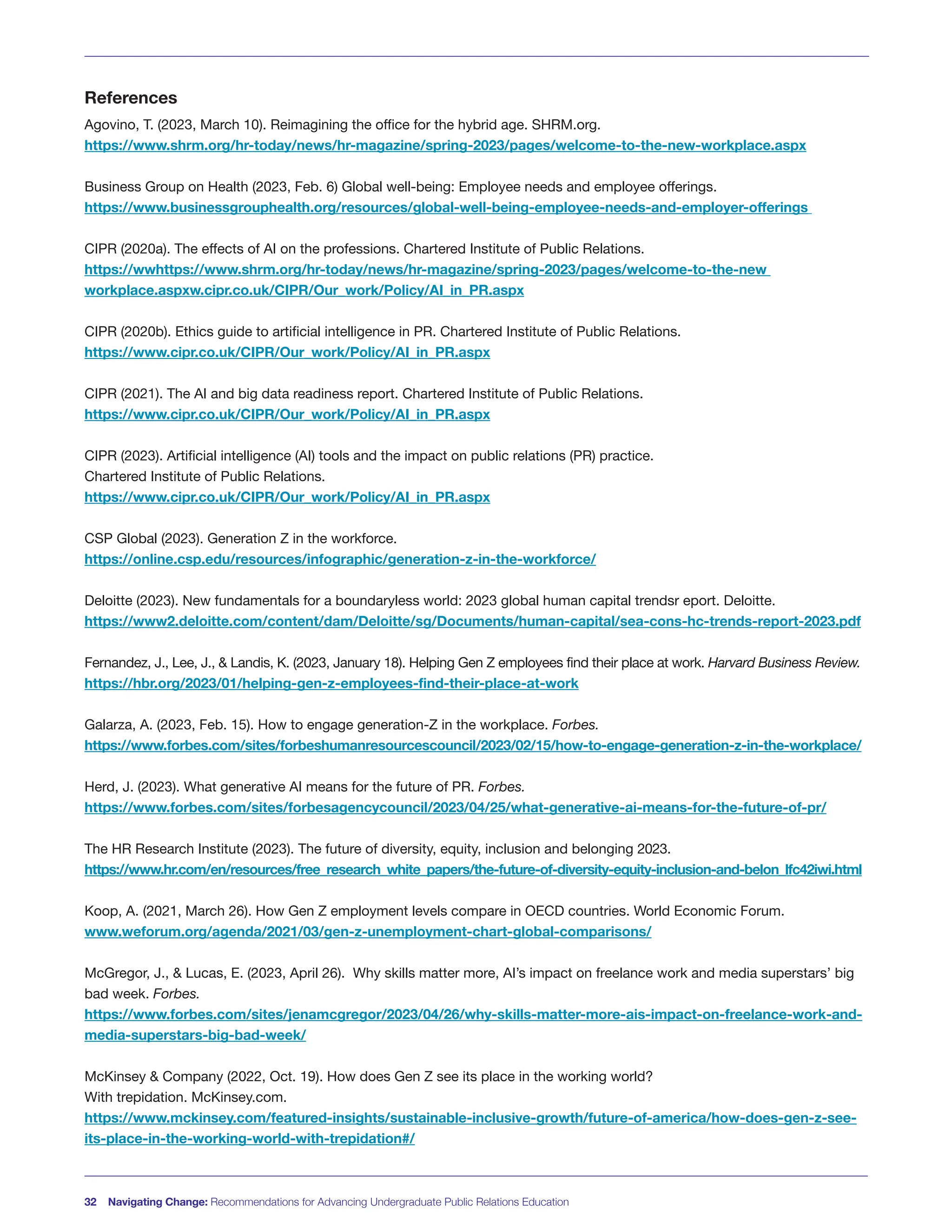



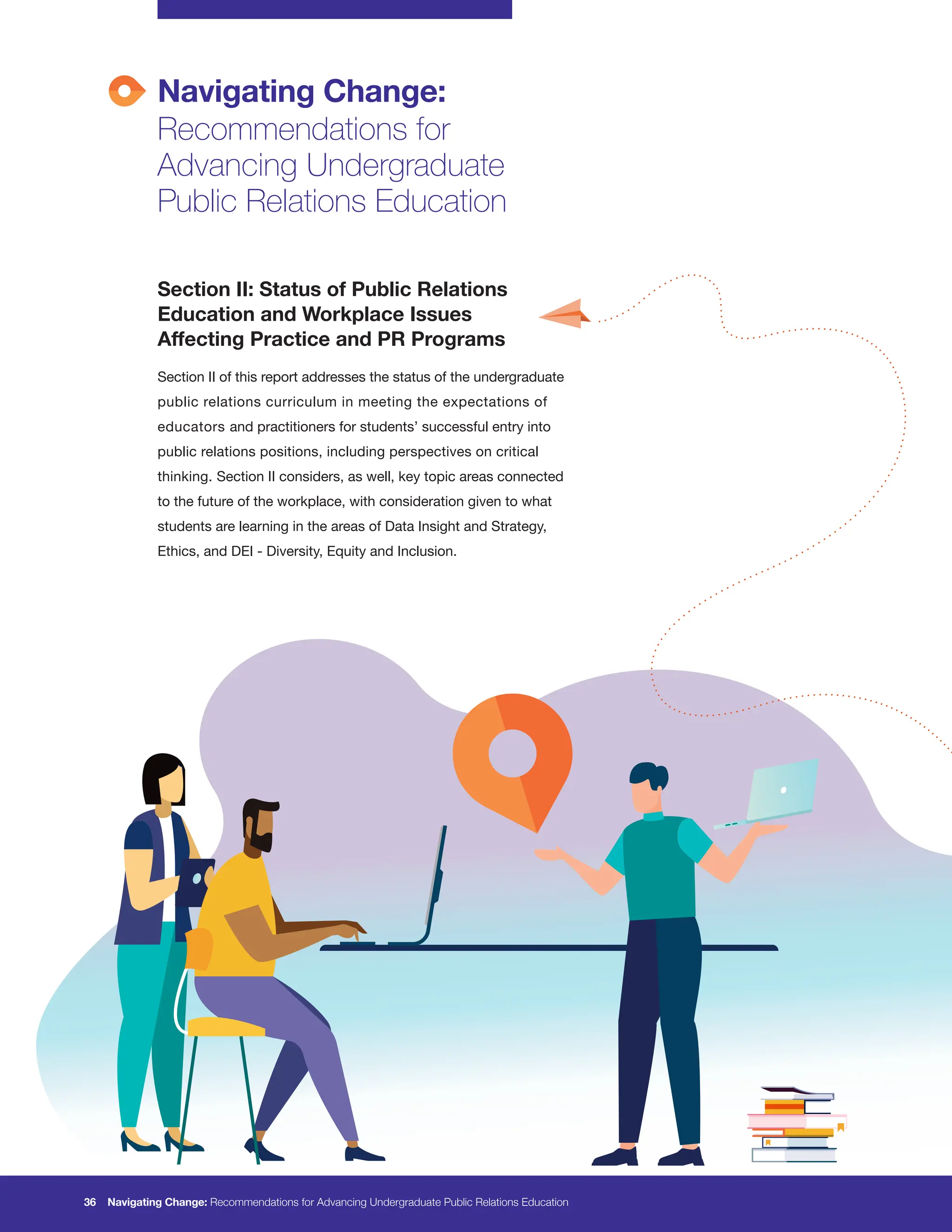

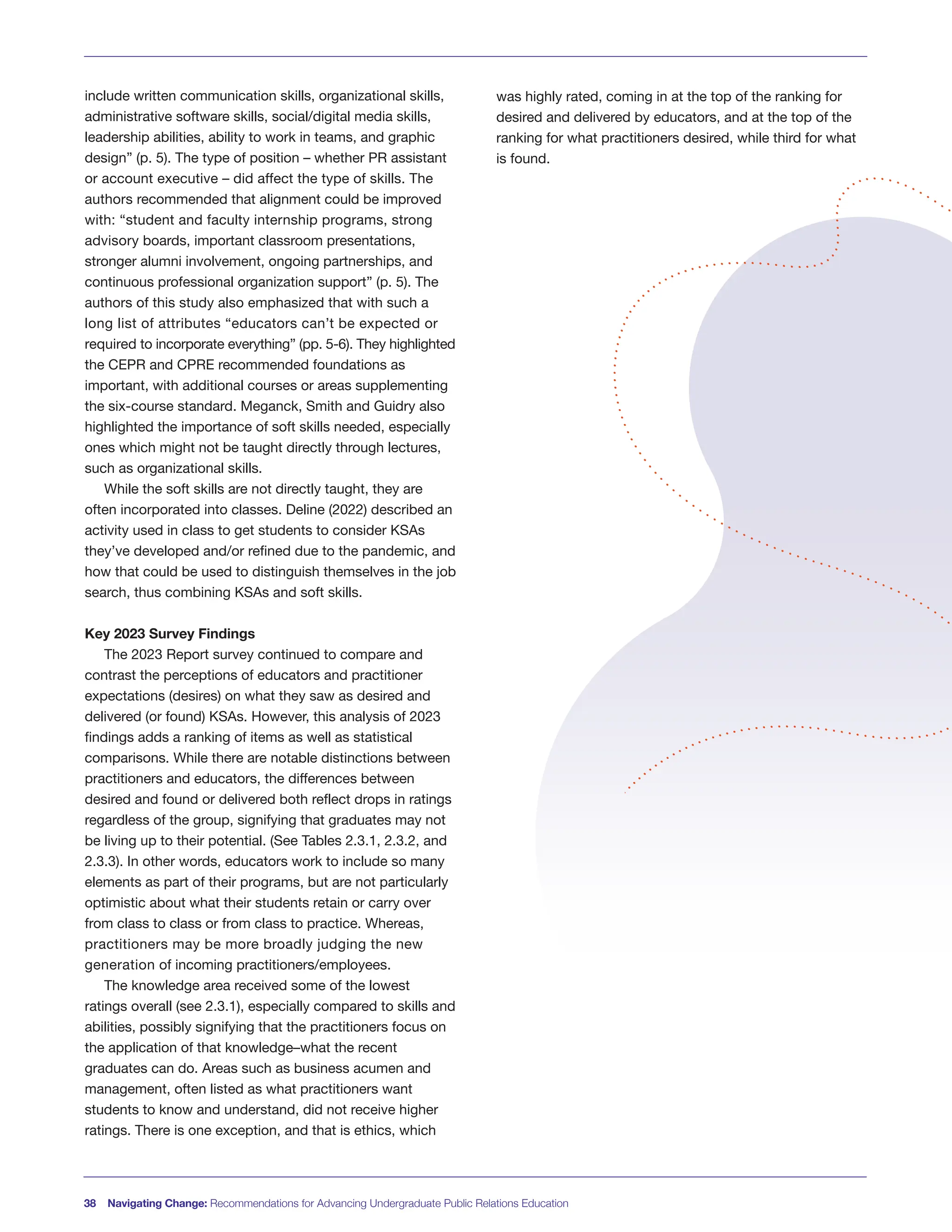
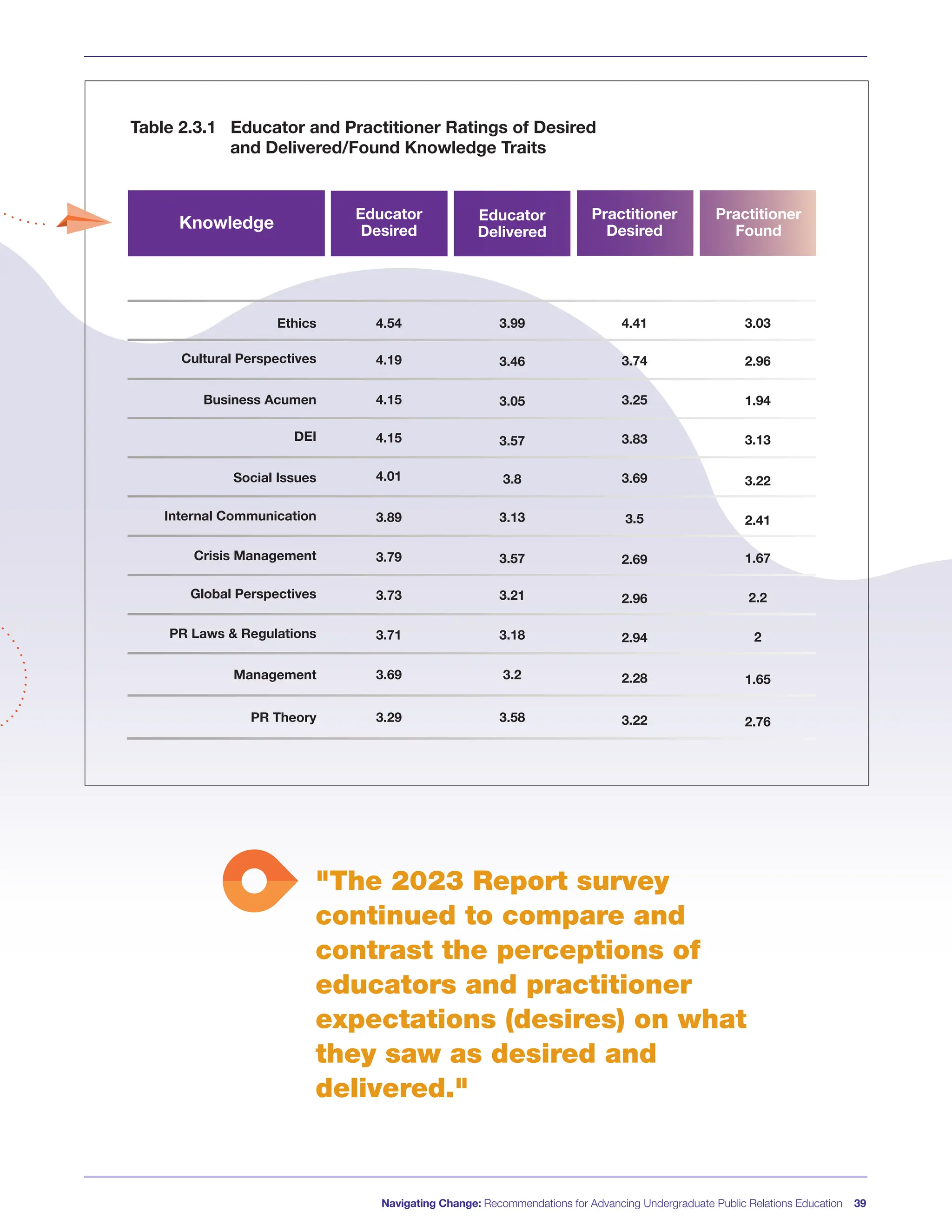
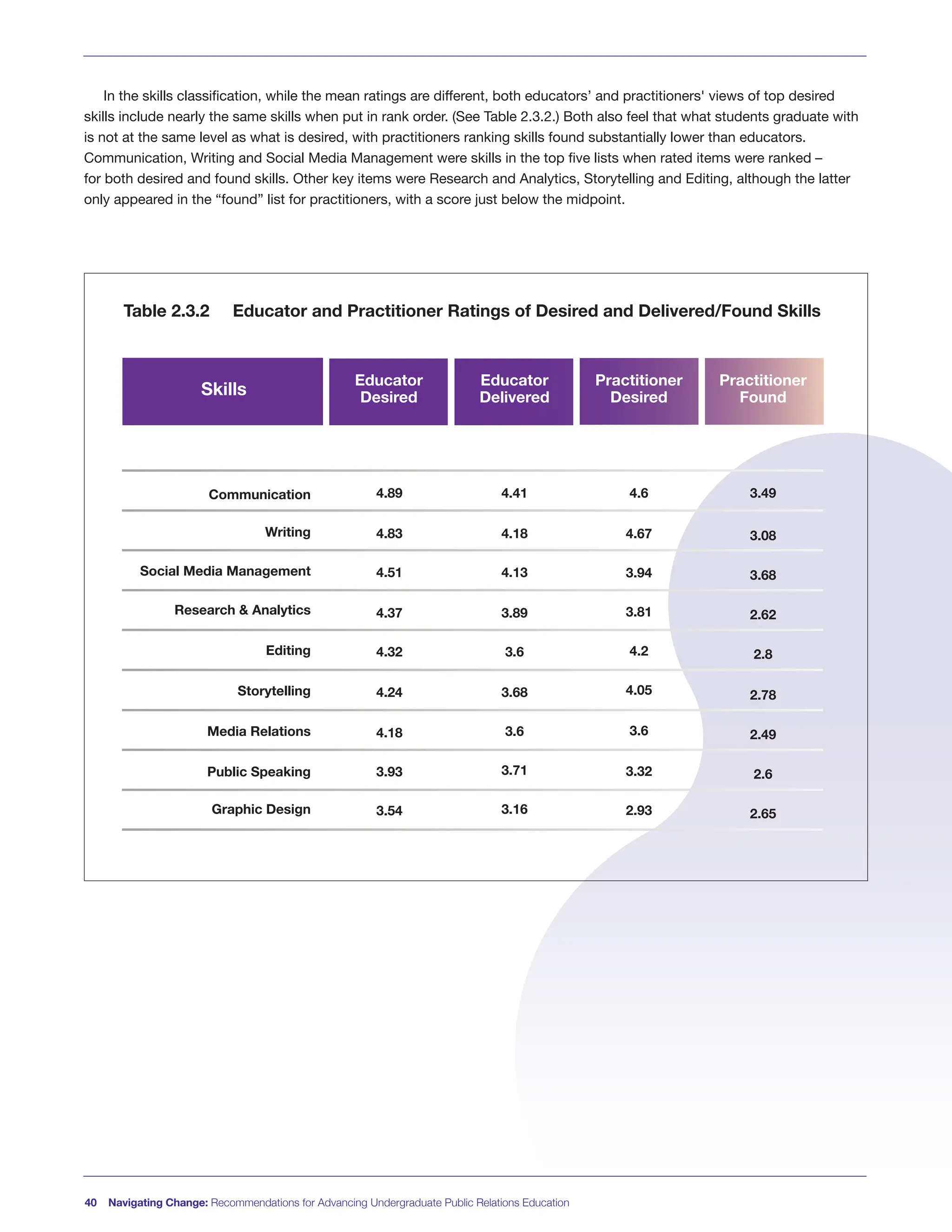
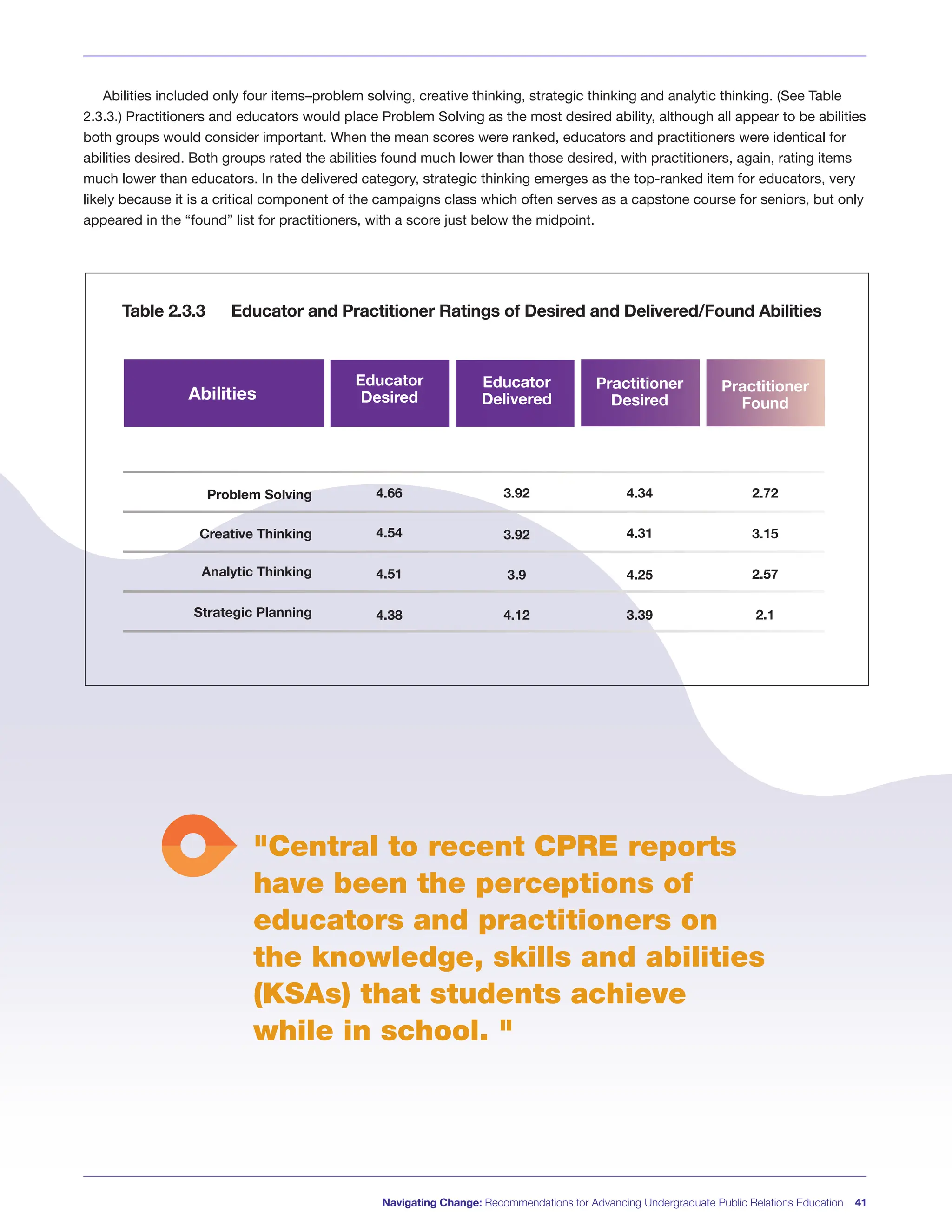
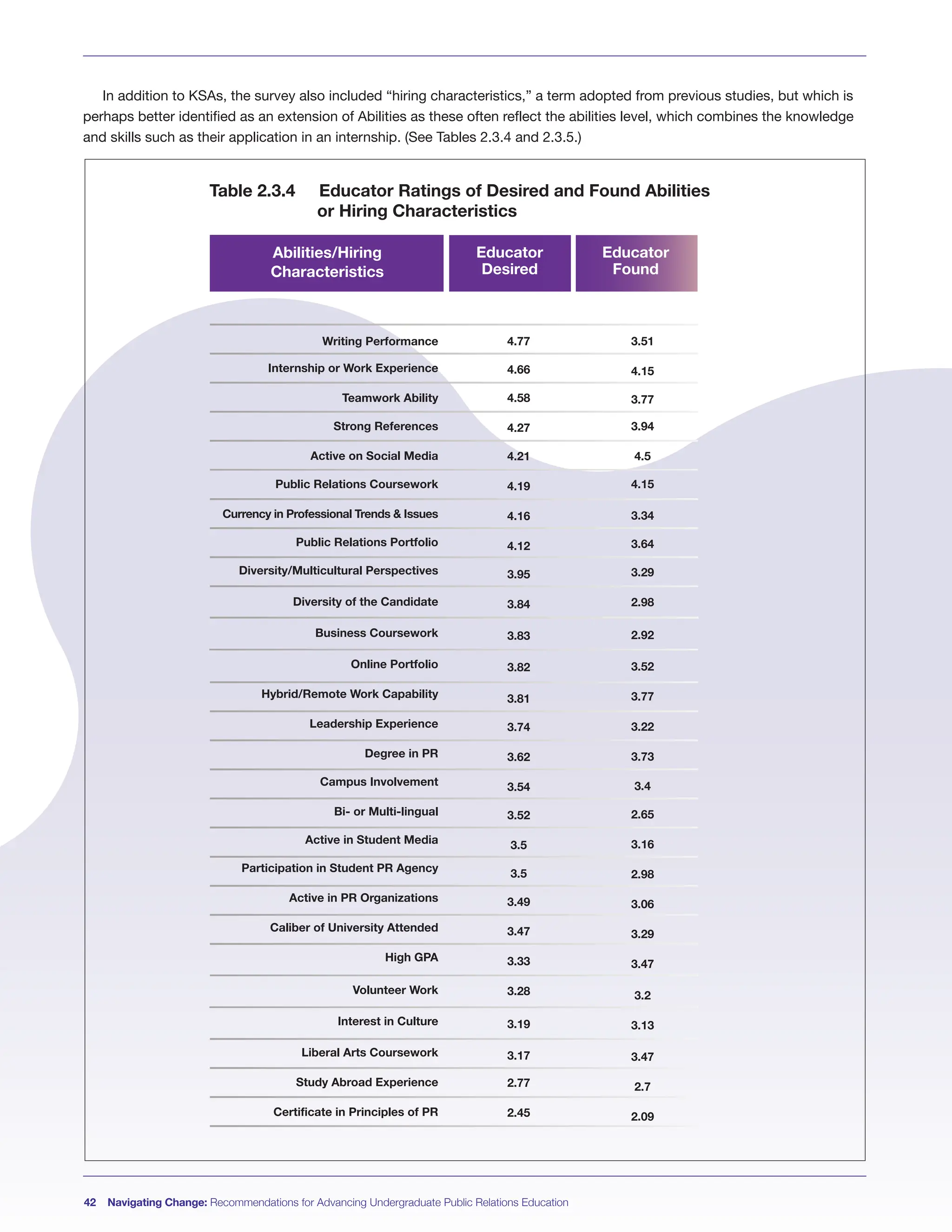

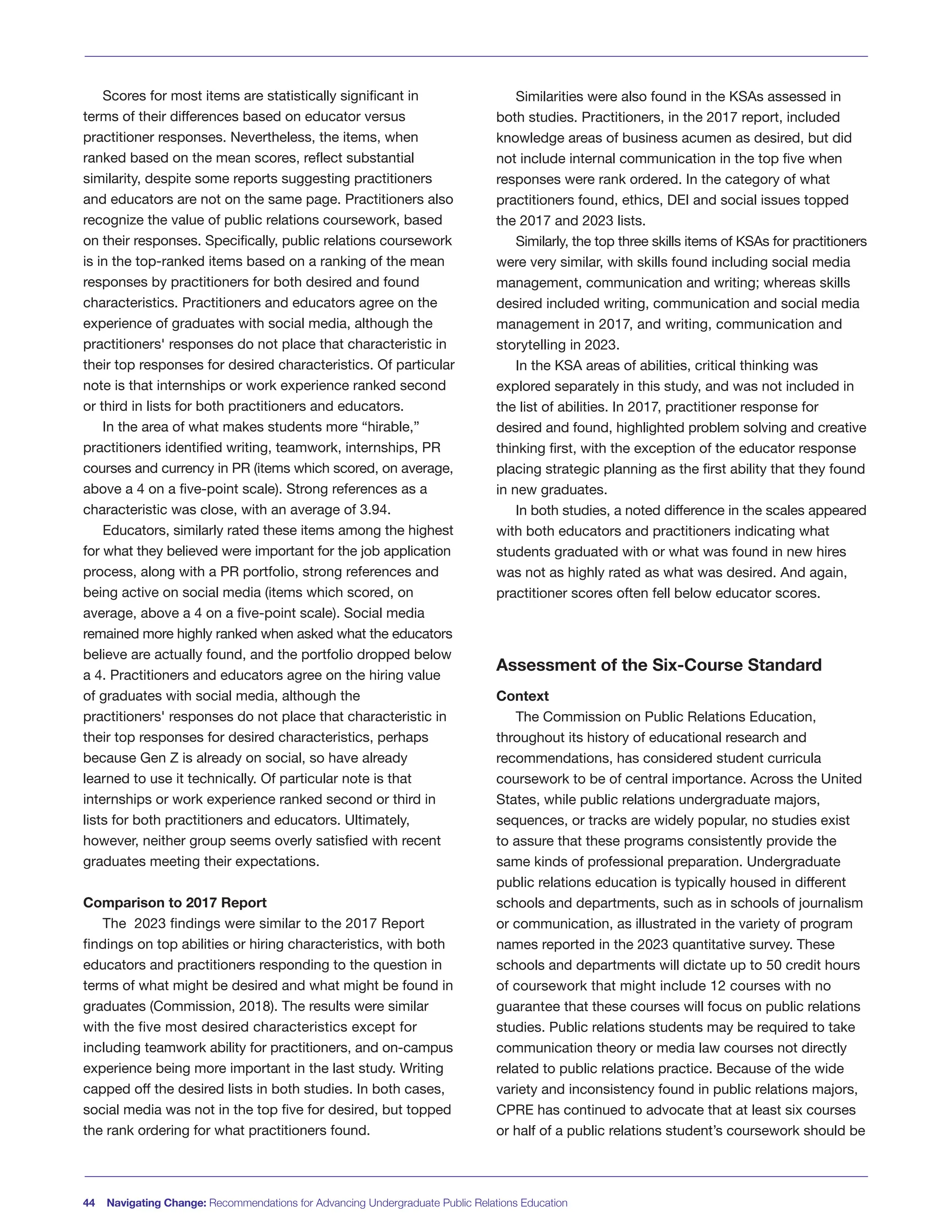
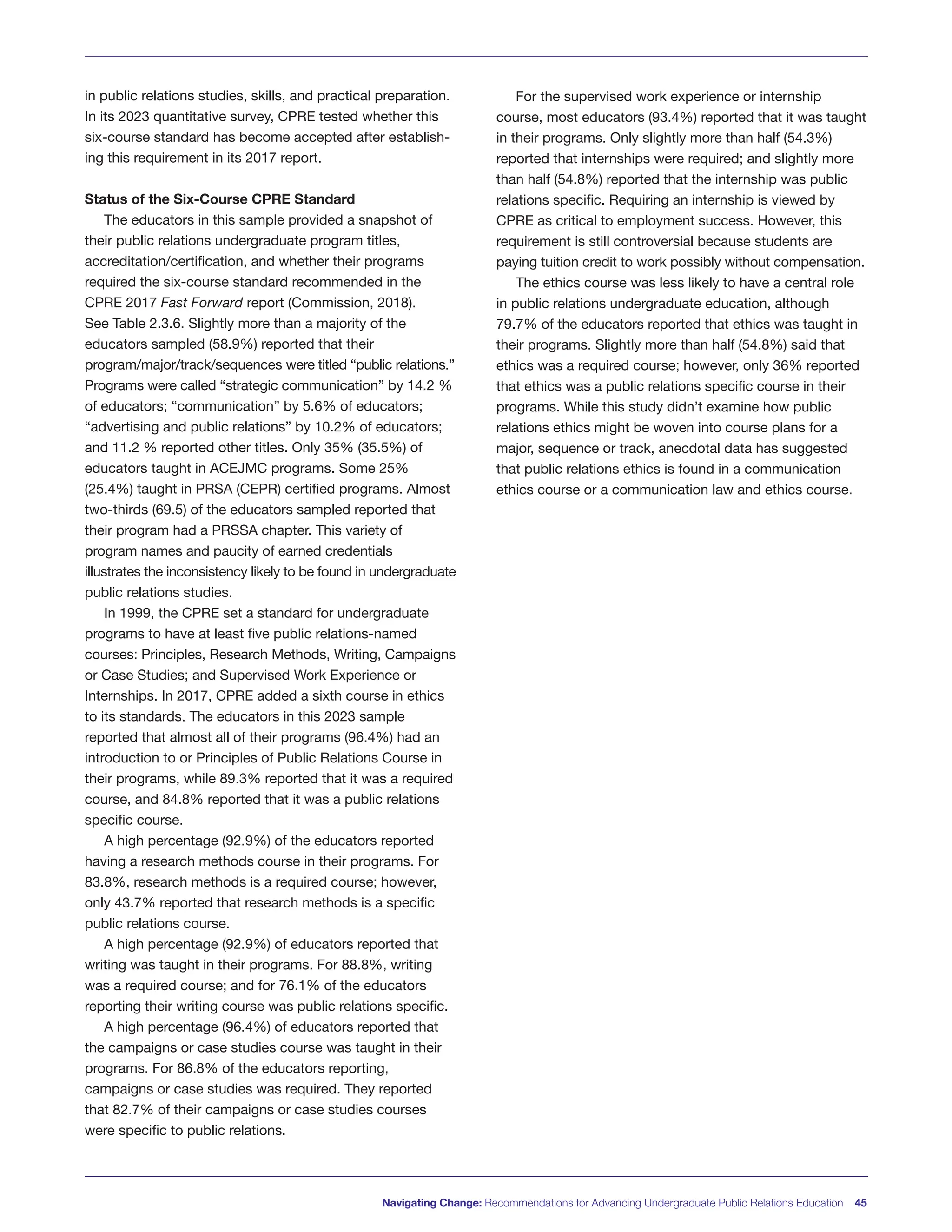

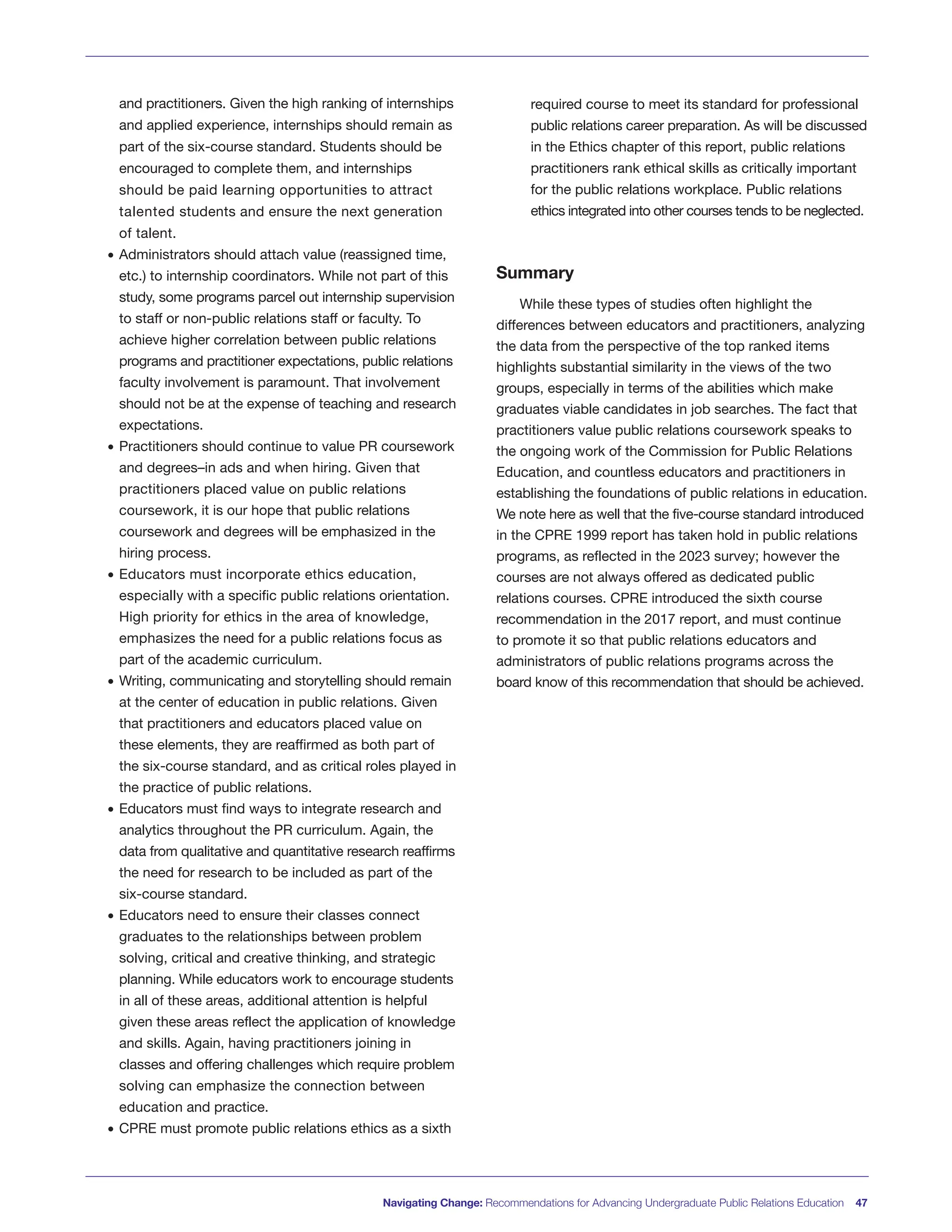

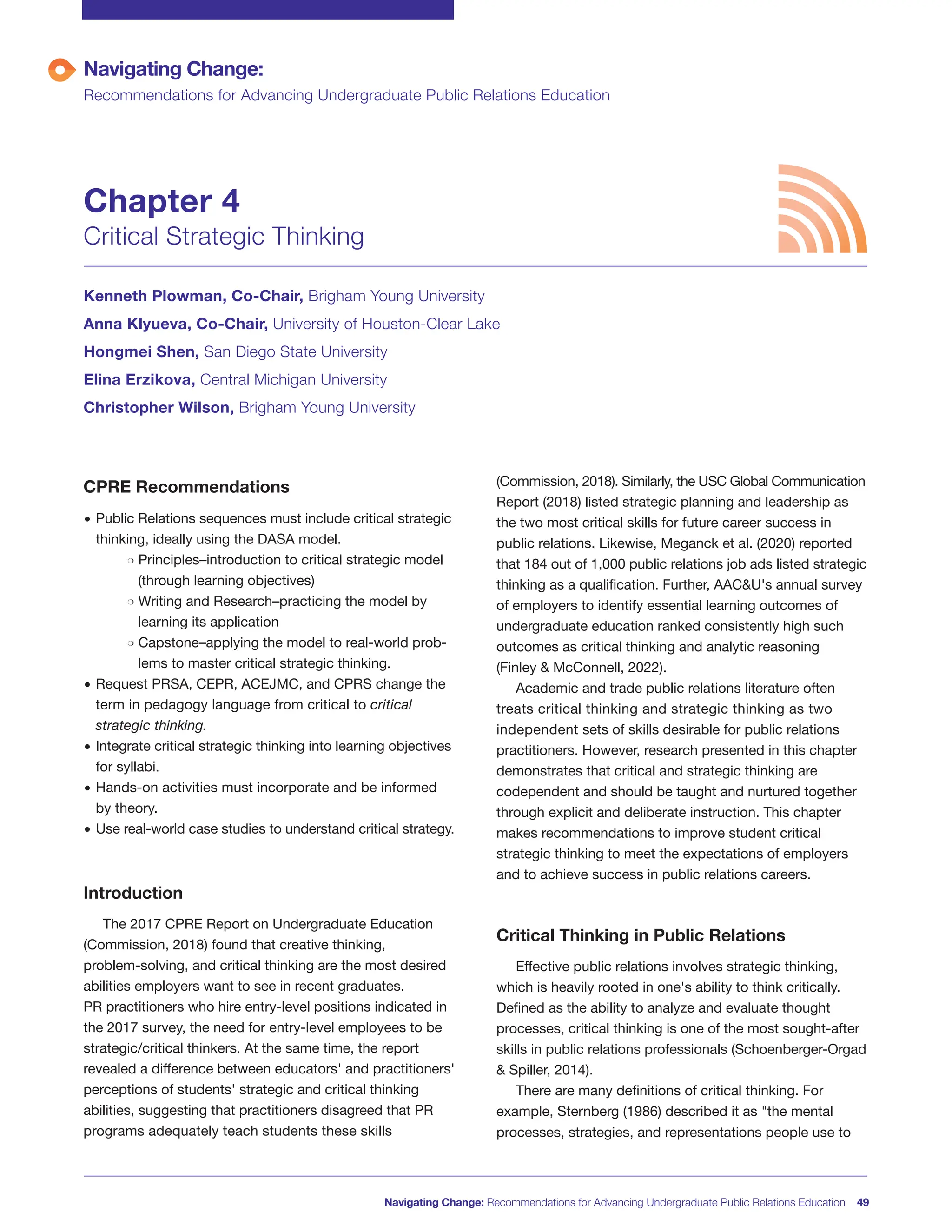

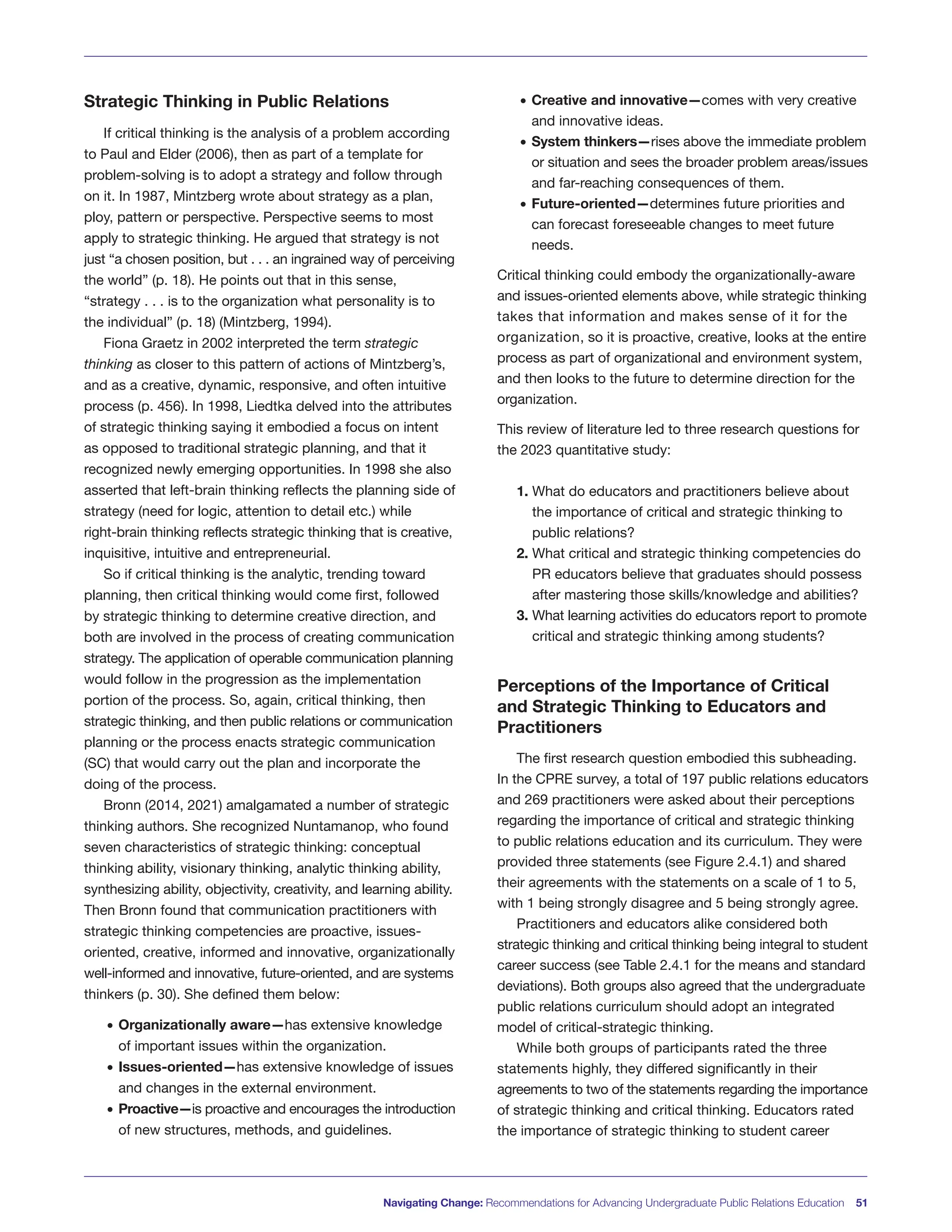


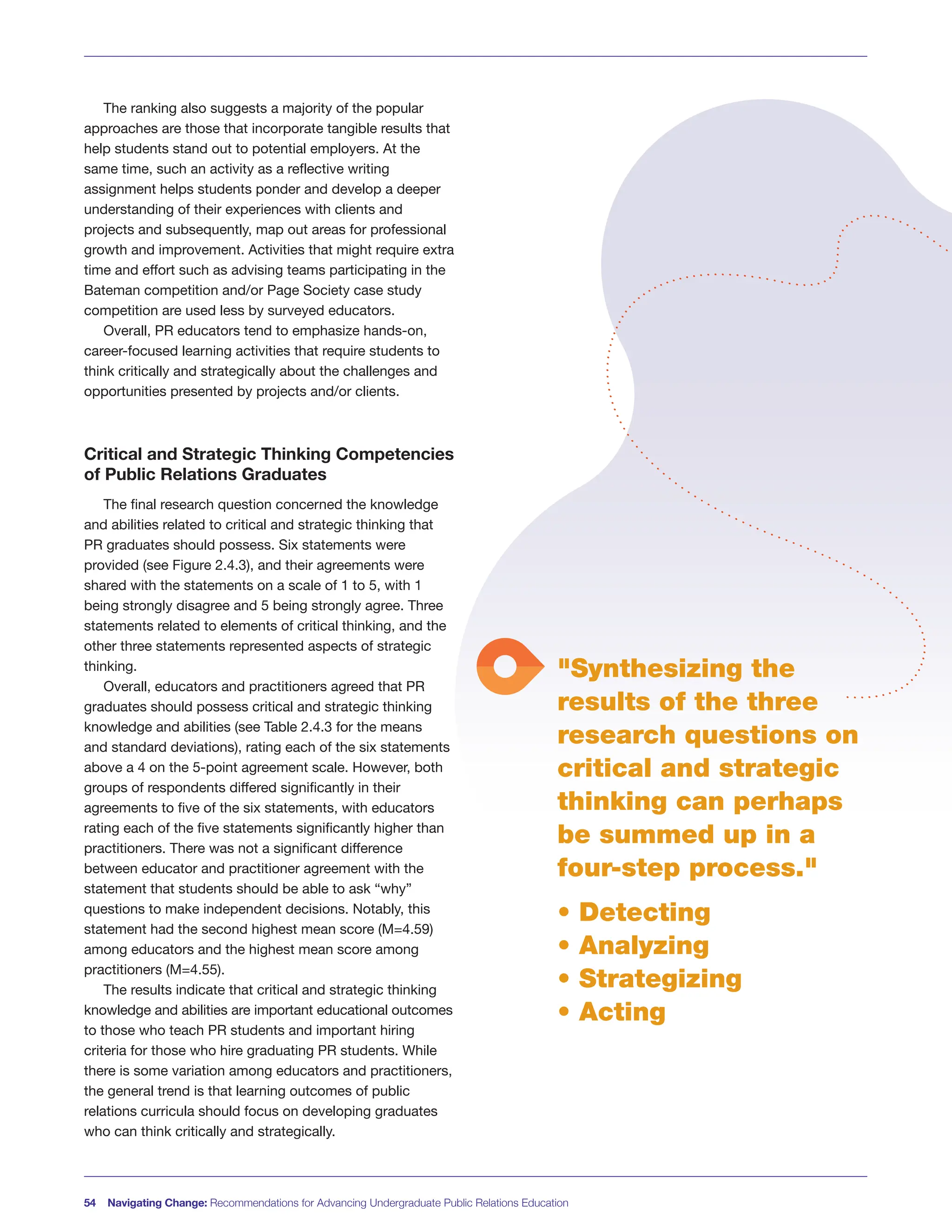
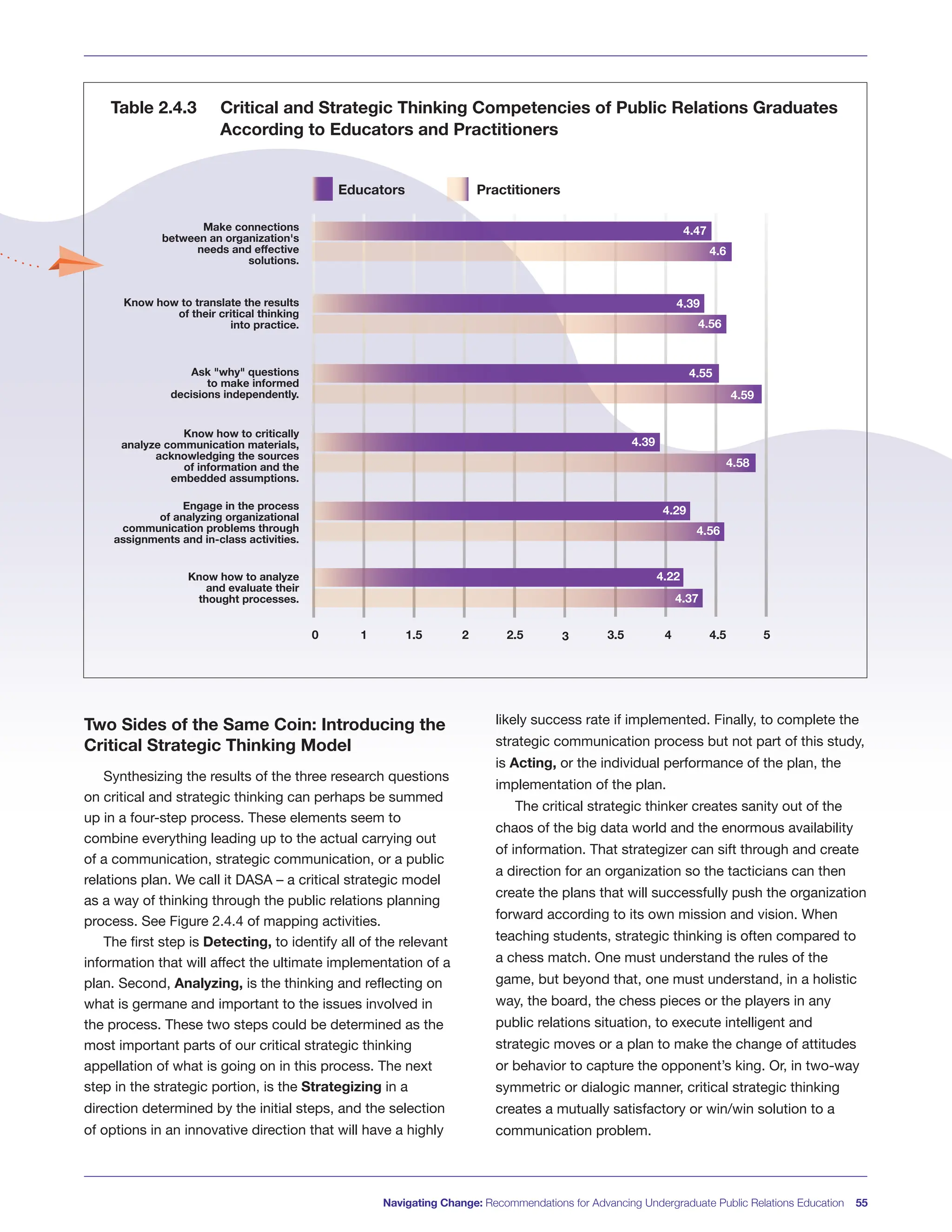

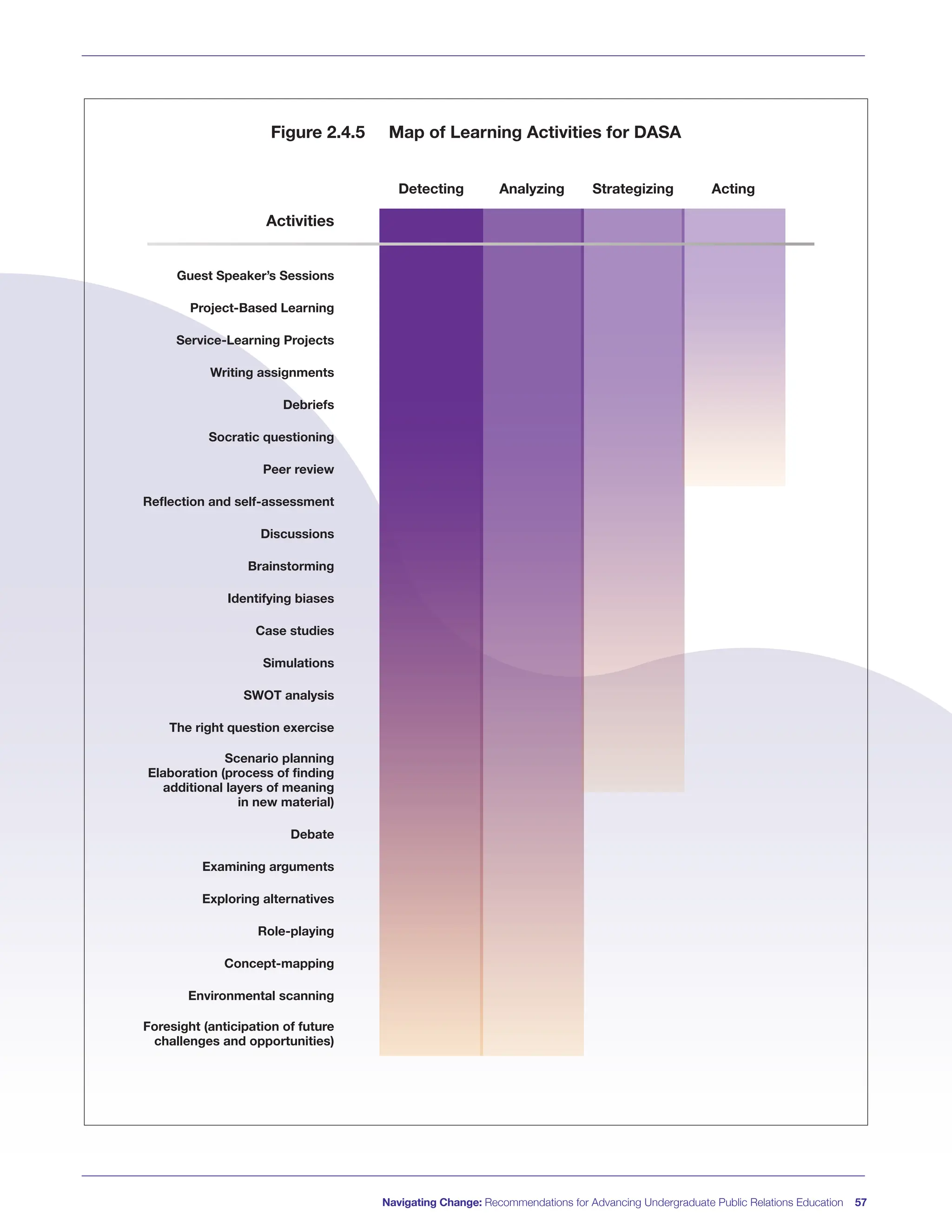

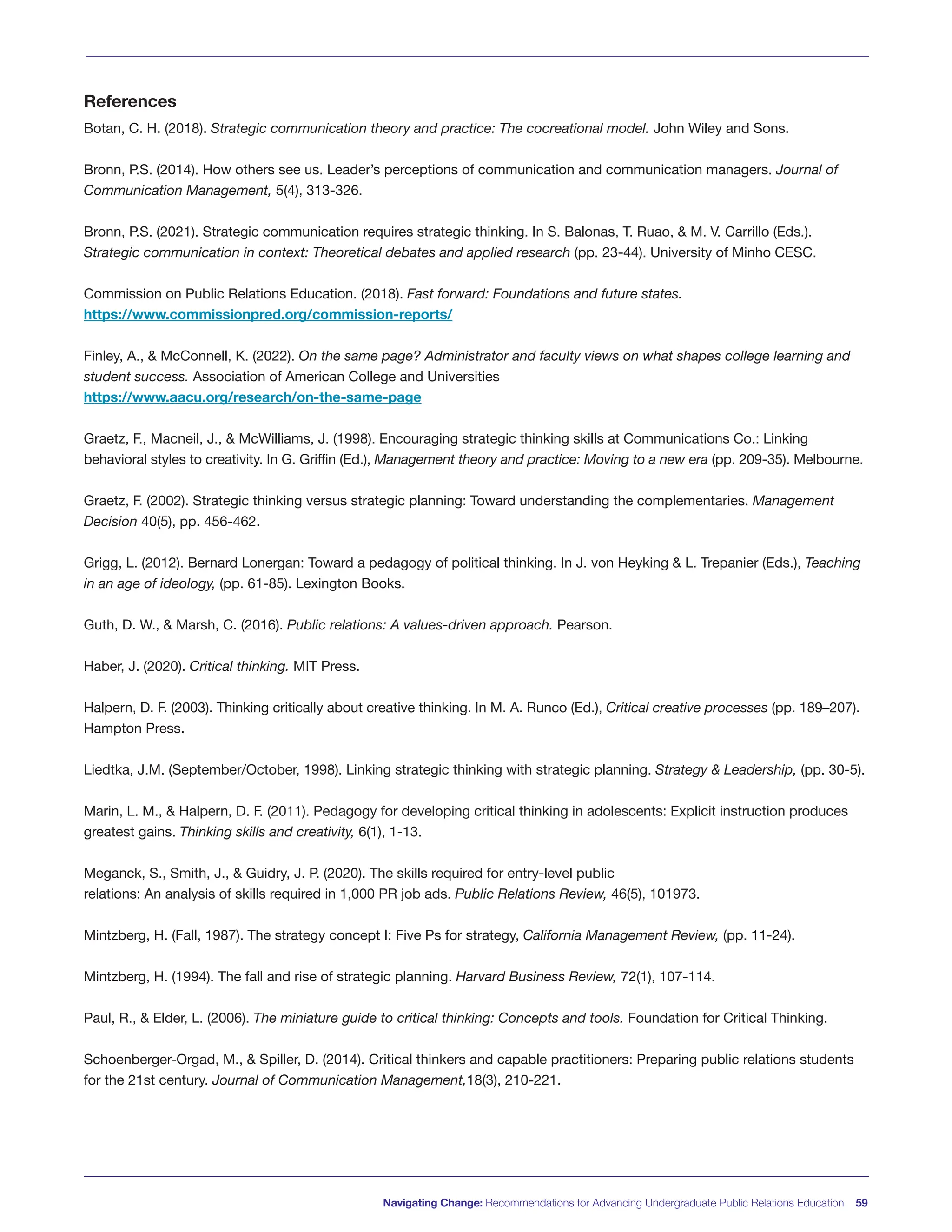

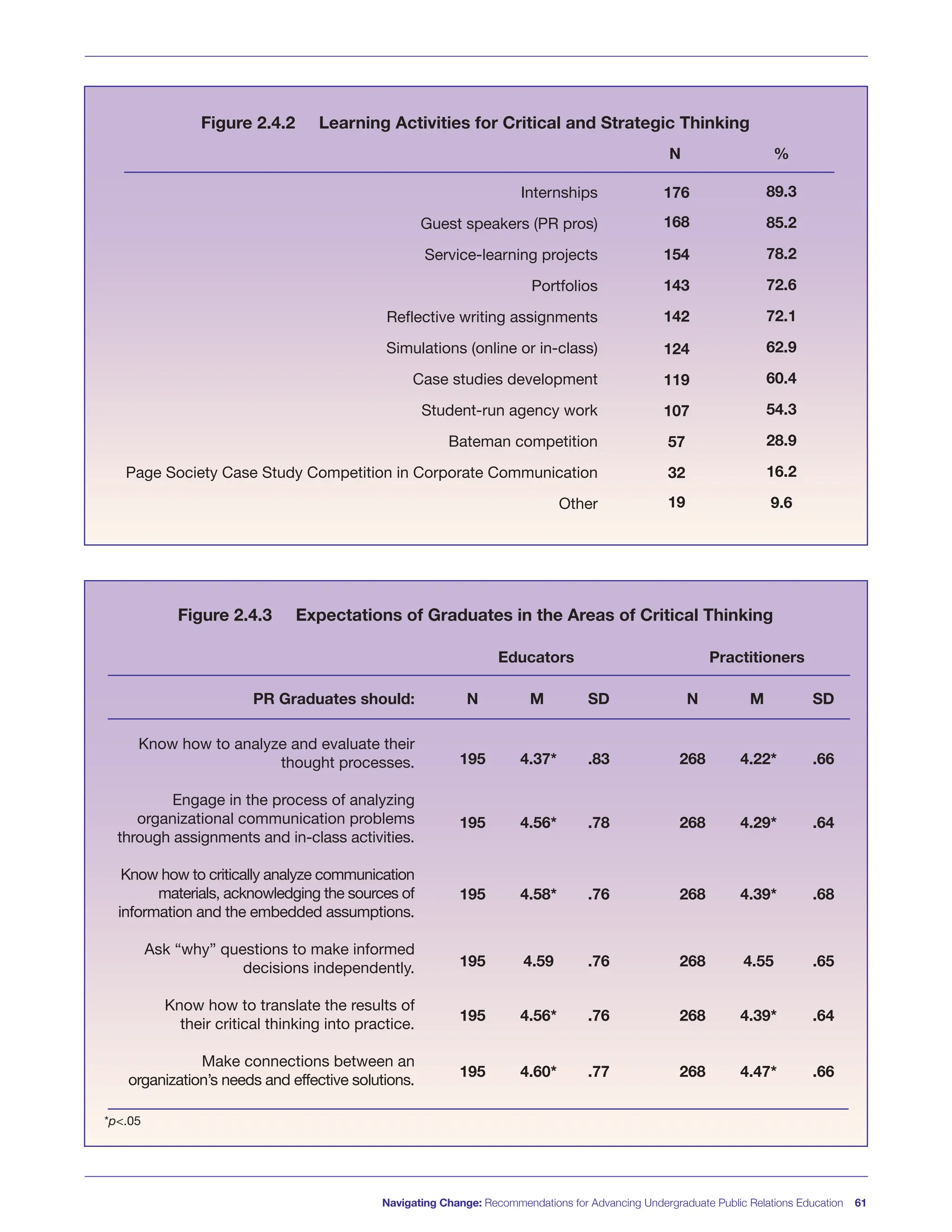


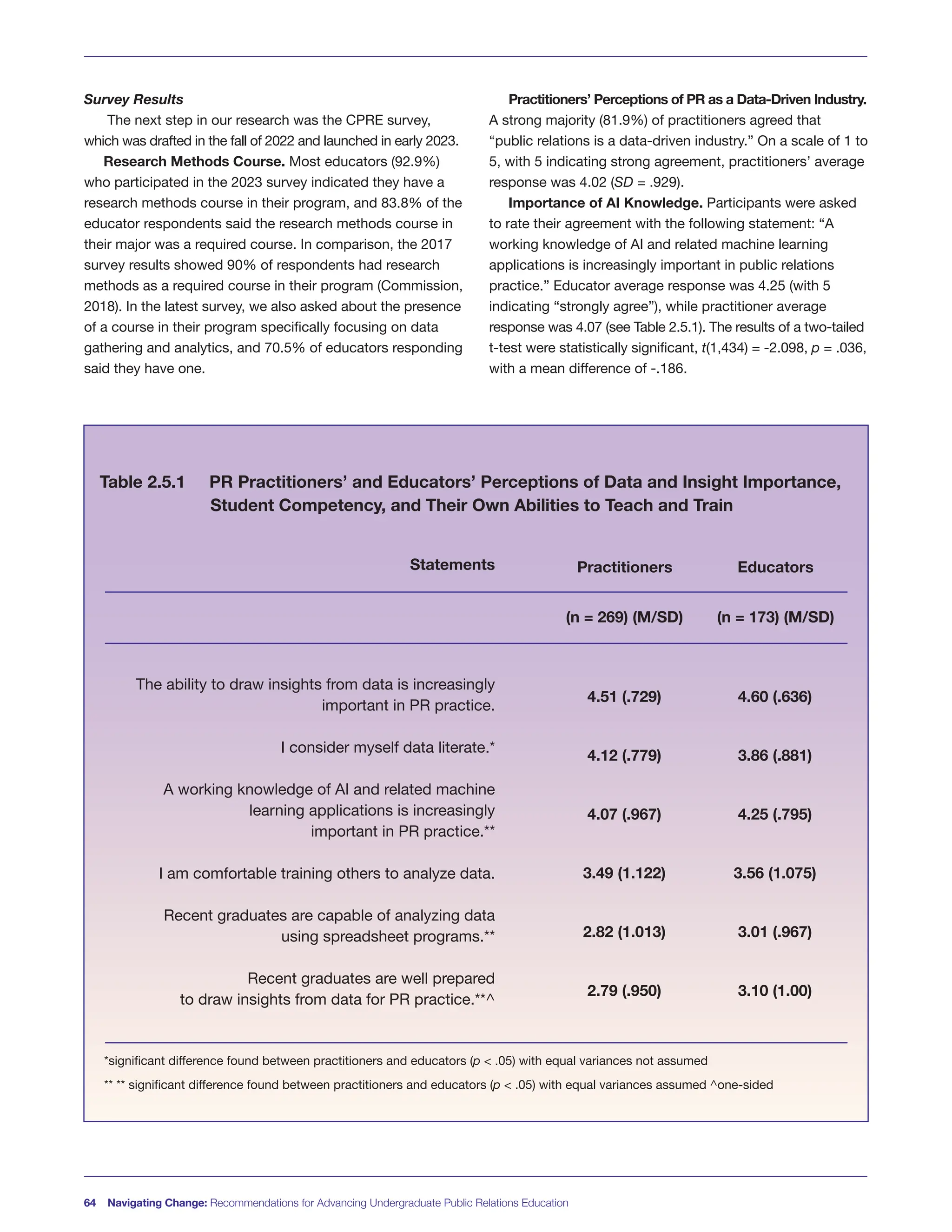


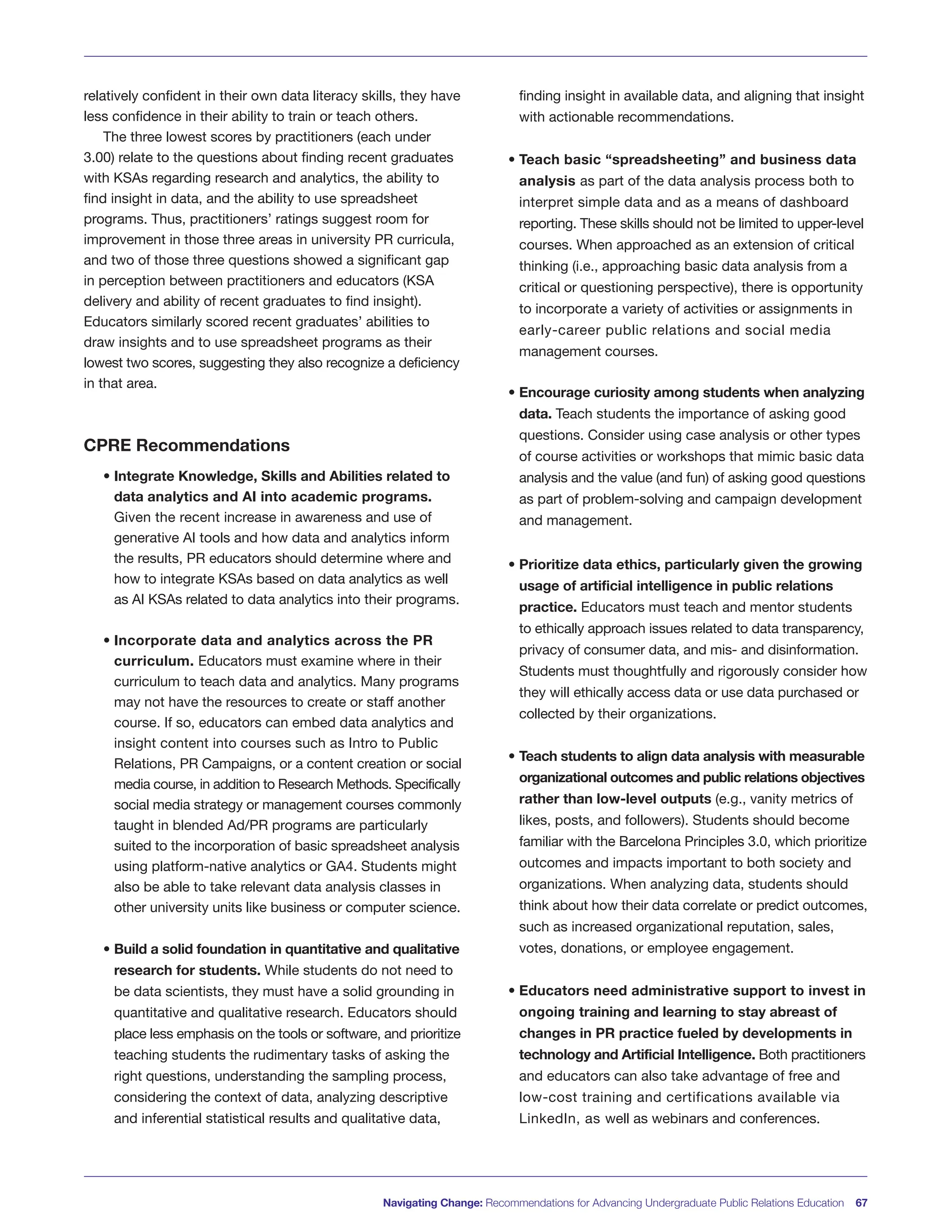
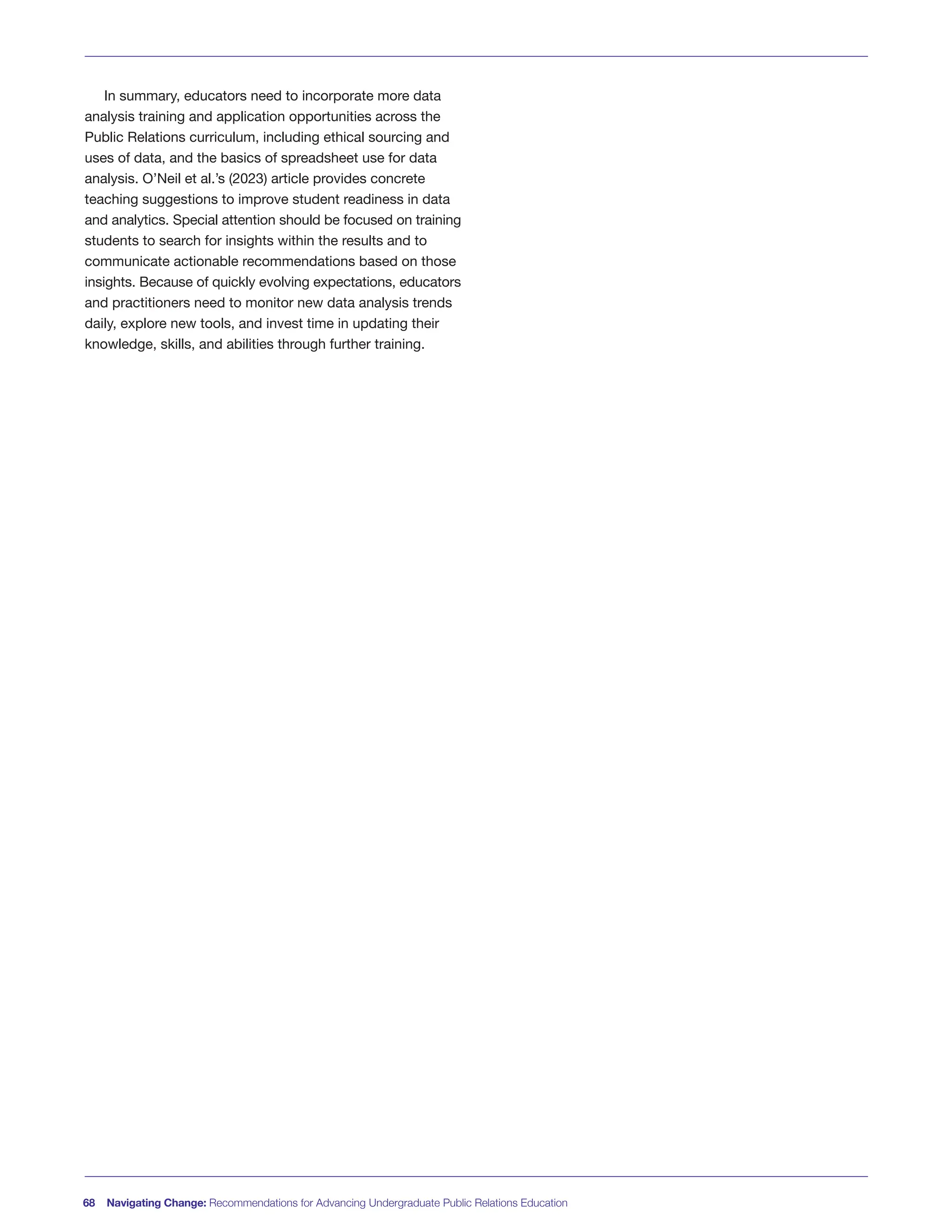
![Navigating Change: Recommendations for Advancing Undergraduate Public Relations Education 69
References
Adams, M., & Lee, N. M. (2021). Analytics in PR education: Desired skills for digital communicators. Journal of Public
Relations Education, 7(2), 44-76.
https://aejmc.us/jpre/2021/08/31/analyticsin-pr-education-desired-skills-for-digital-communicators/
AMEC. (2020). Barcelona principles 3.0.
https://amecorg.com/2020/07/barcelona-principles-3-0/
Commission on Public Relations Education. (2018). Fast forward: Foundations + Future state. Educators + practitioners.
http://www.commissionpred.org/wp-content/uploads/2018/04/report6-full.pdf
Dietrich, G. (2023, May 16). The good, the bad, and the ugly of generative AI. Spin Sucks [blog].
https://spinsucks.com/communication/generative-ai/
Ewing, M., Kim, C.M., Kinsky, E. S., Moore, S., & Freberg, K. (2018). Teaching digital and social media analytics: Exploring
best practices and future implications for public relations pedagogy. Journal of Public Relations Education, 4(2), 51-86.
Lee, J. J., Meng, J. (2021). Digital competencies in communication management: A conceptual framework of readiness for
Industry 4.0 for communication professionals in the workplace. Journal of Communication Management, 25(4), 417-436.
https://doi.org/10.1108/JCOM-10-2020-0116
Luttrell, R., Wallace, A. A., McCollough, C., & Lee, J. (2021). Public relations curriculum: A systematic examination of curricular
offerings in social media, digital media, and analytics in accredited programs. Journal of Public Relations Education, 7(2), 1-43.
https://aejmc.us/jpre/2021/09/10/public-relations-curriculum-asystematic-examination-of-curricular-offerings-in-so-
cial-mediadigital-media-and-analytics-in-accredited-programs
Neill, M. S., & Schauster, E. (2015). Gaps in advertising and public relations education: Perspectives of agency leaders.
Journal of Advertising Education, 19(2), 5–17.
https://doi.org/10.1177/109804821501900203
O’Neil, J., Kinsky, E. S., Ewing, M. E., & Russell, M. (2023). You don’t have to become a data scientist”: Practitioner
recommendations for cultivating PR student data competency. Journal of Public Relations Education, 9(1), 2-34.
Stansberry, K. (2016). Taming the social media data deluge: Using social media research methods in the public relations
classroom. In H. S. Noor Al-Deen (Ed.), Social Media in the Classroom (pp. 75-92). Peter Lang.
Waxman, M. (2023). Generative AI for Digital Marketers [LinkedIn Learning course].
https://www.linkedin.com/learning/generative-ai-for-digital-marketers
Weiner, M. (2021). PR technology, data and insights: Igniting a positive return on your communications investment.
Kogan Page Limited.
Wiencierz, C., & Röttger, U. (2019). Big data in public relations: A conceptual framework. Public Relations Journal, 12(3),1-15.
Xie, Q., Schauster, E., & Neill, M. S. (2018). Expectations for advertising and public relations education from agency executives:
A comparative study between China and the United States. Journal of Current Issues & Research in Advertising, 39(3), 289-307.
https://doi.org/10.1080/10641734.2018.1490358](https://image.slidesharecdn.com/cpre50thanniversaryreportfinal-231113221518-5a26693a/75/Navigating-Change-Report-71-2048.jpg)

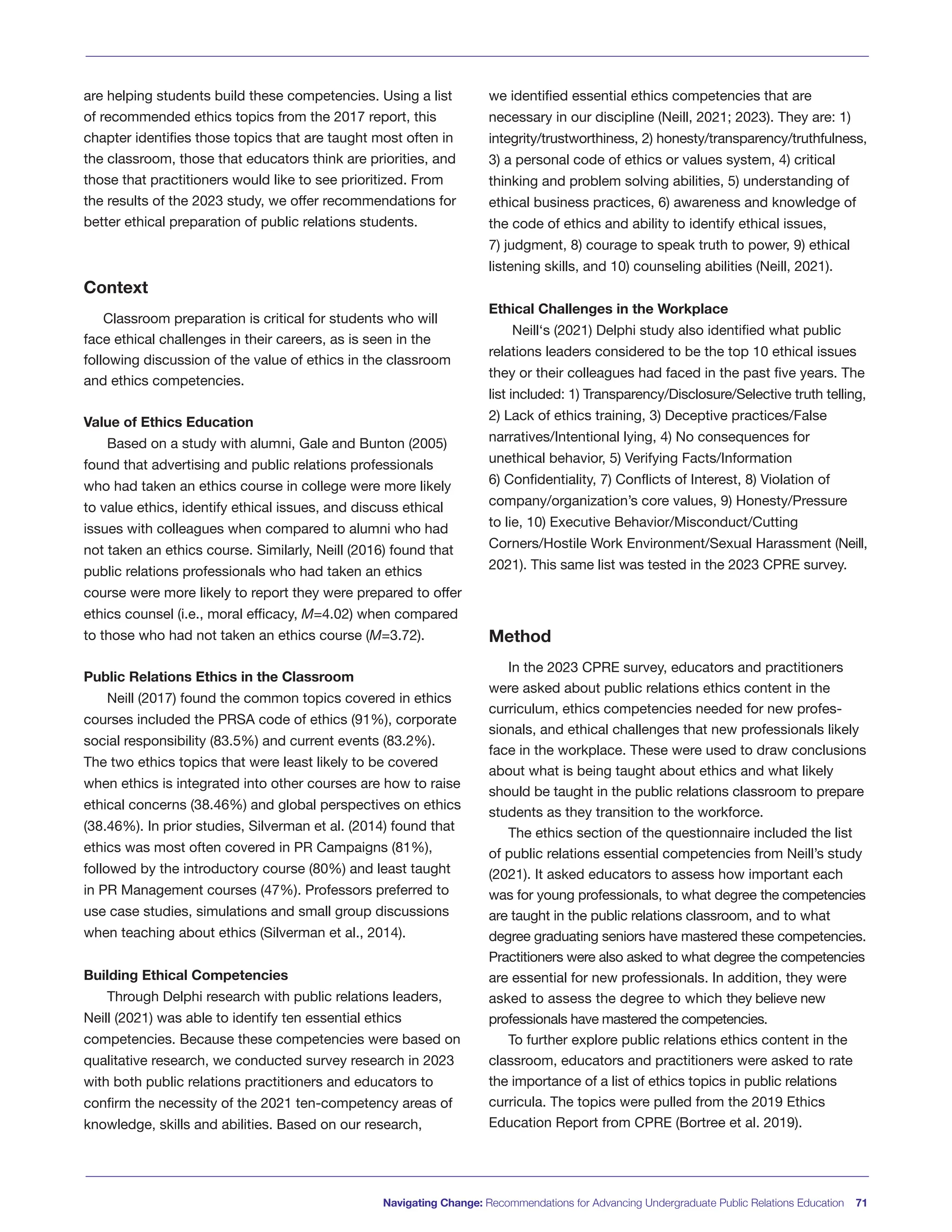
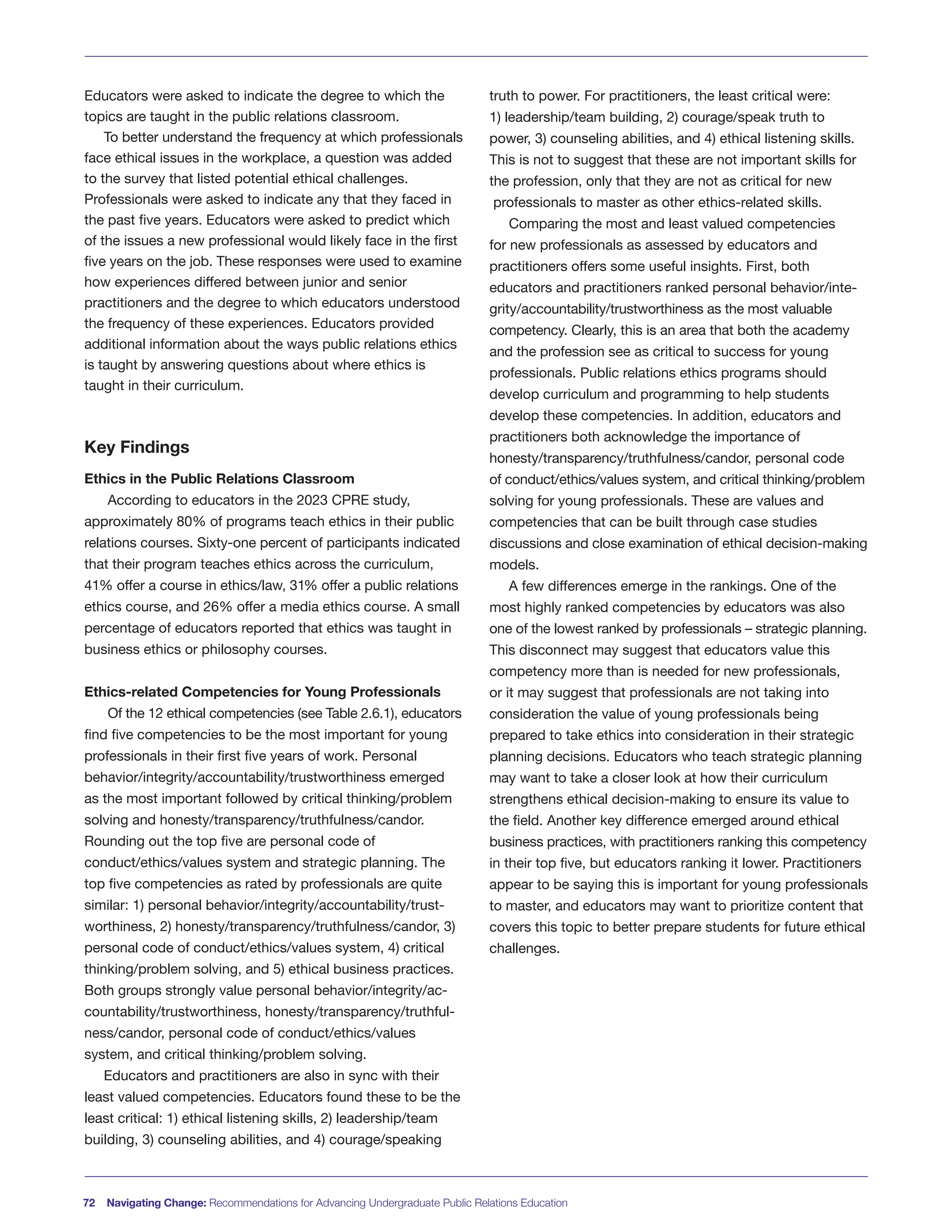



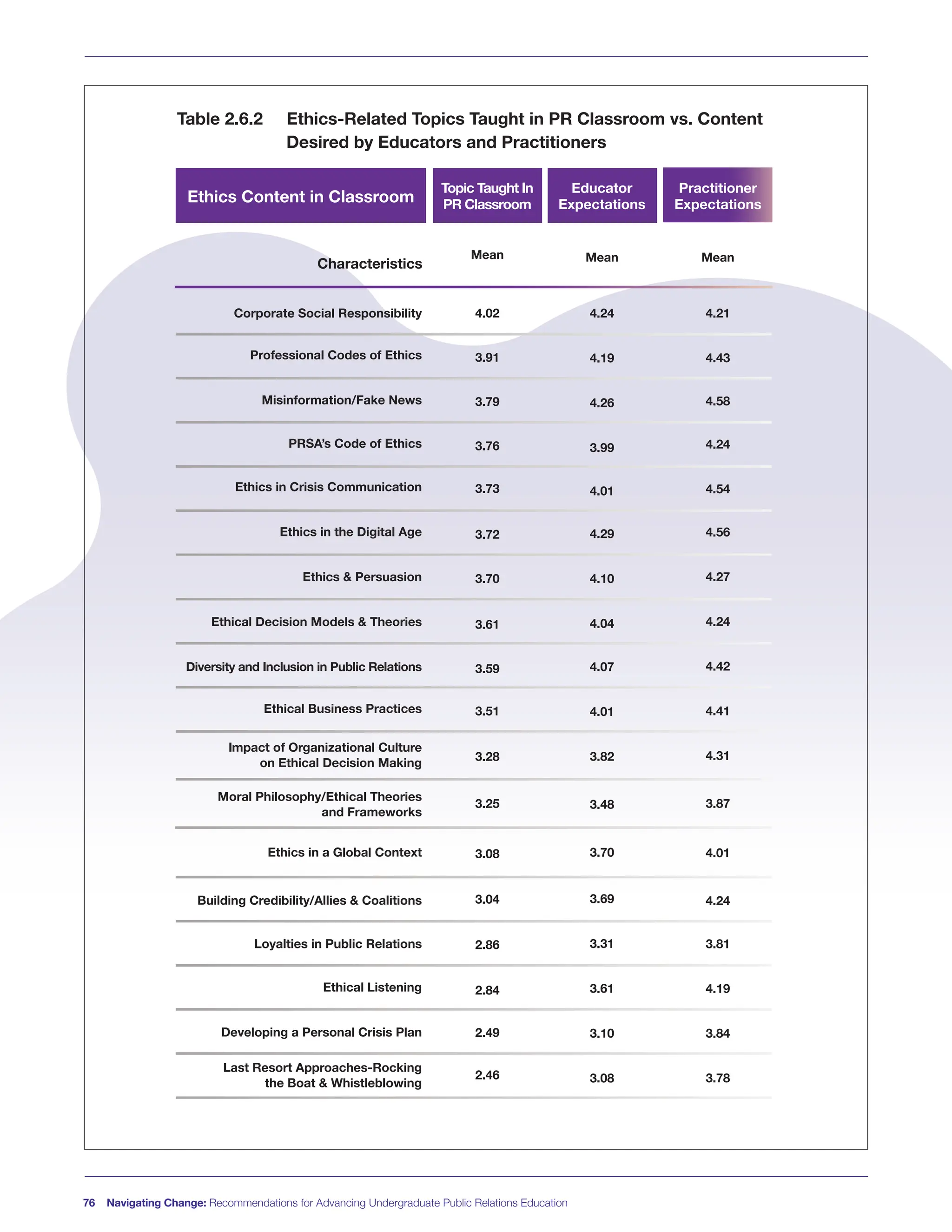


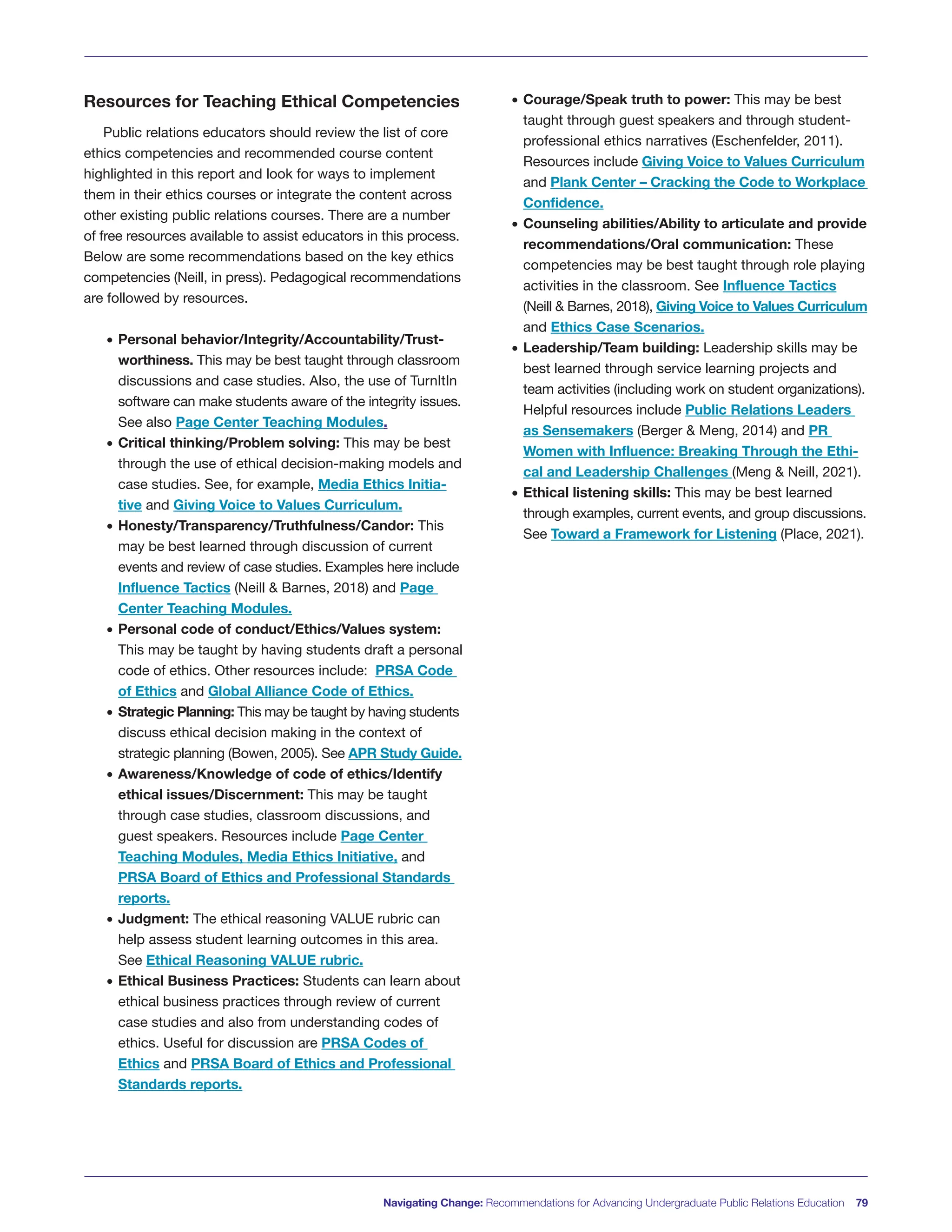
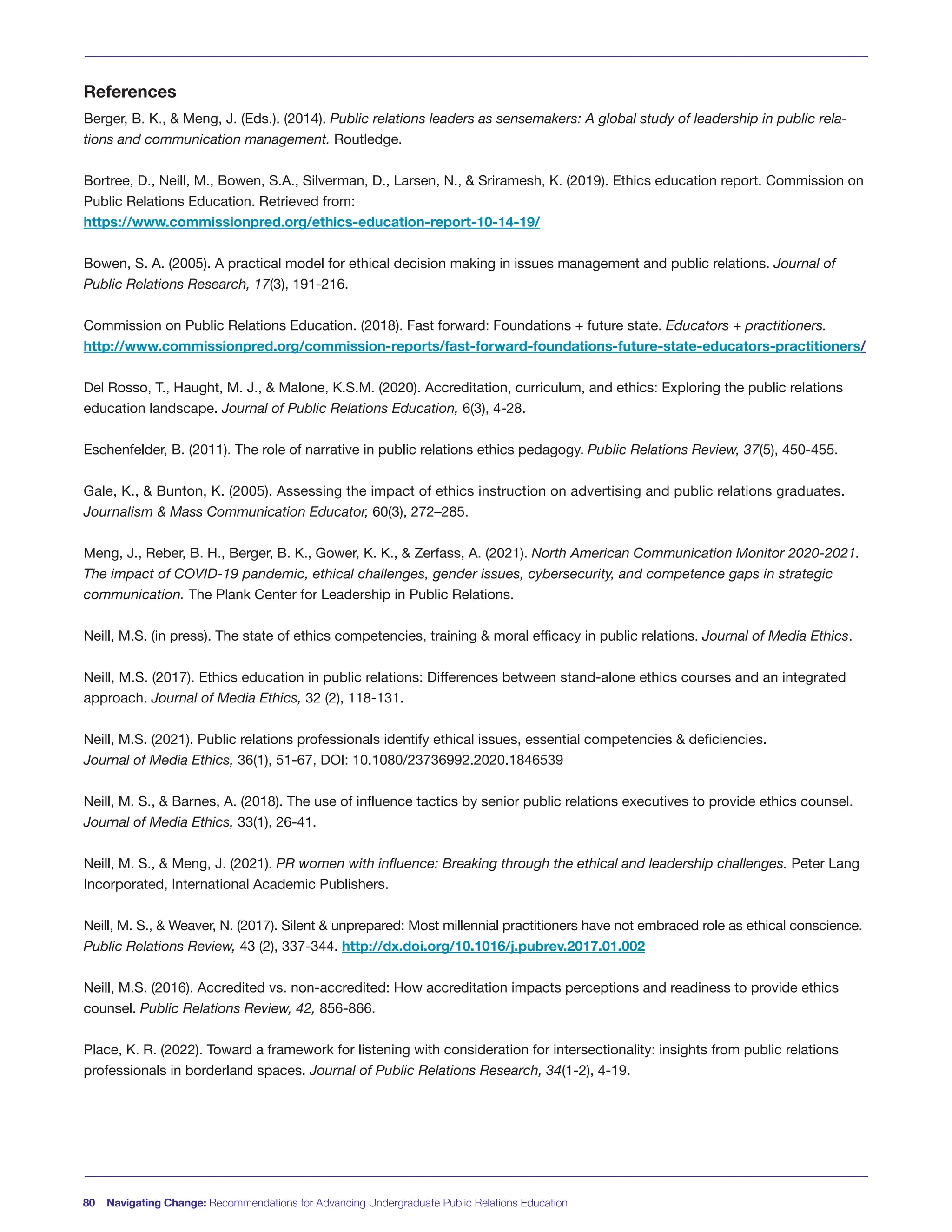
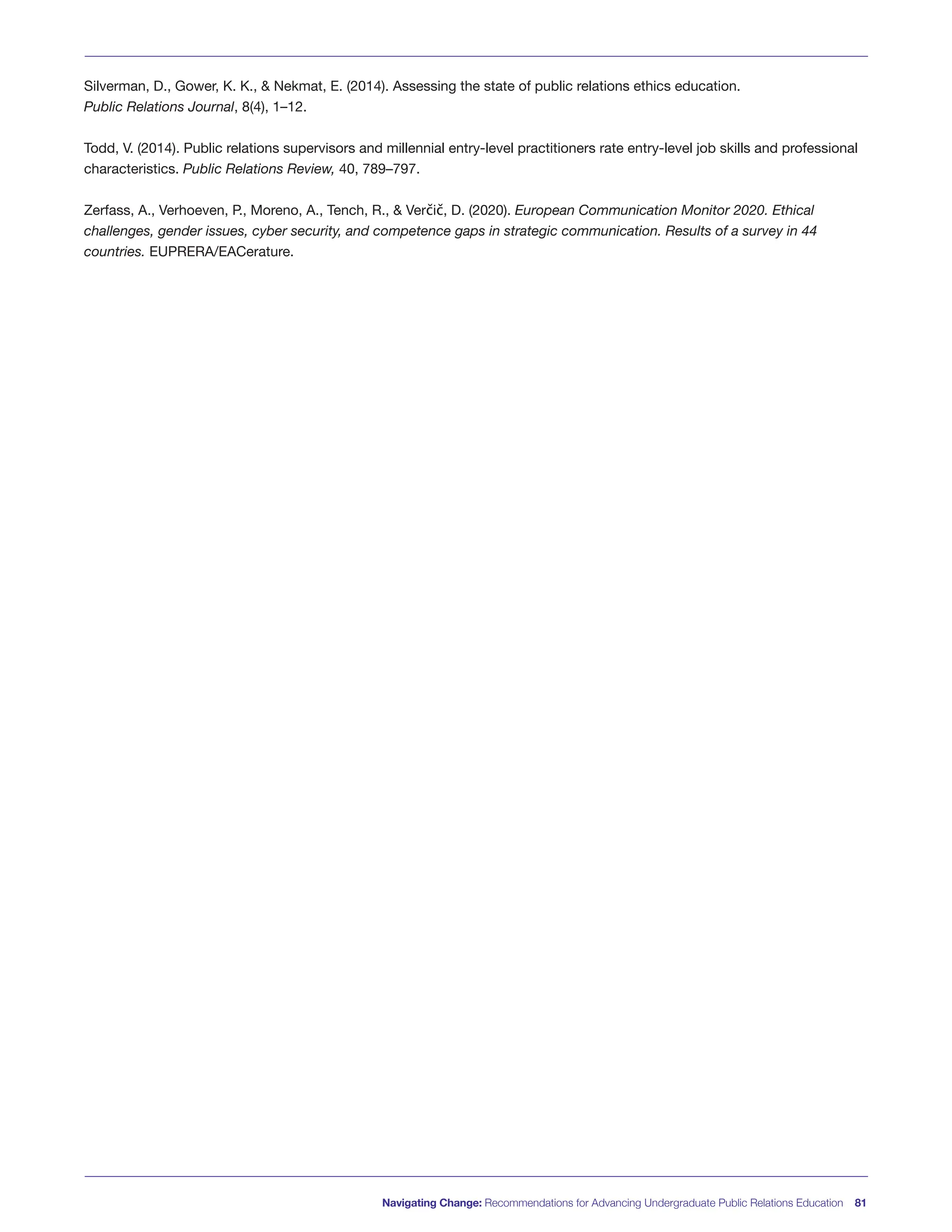

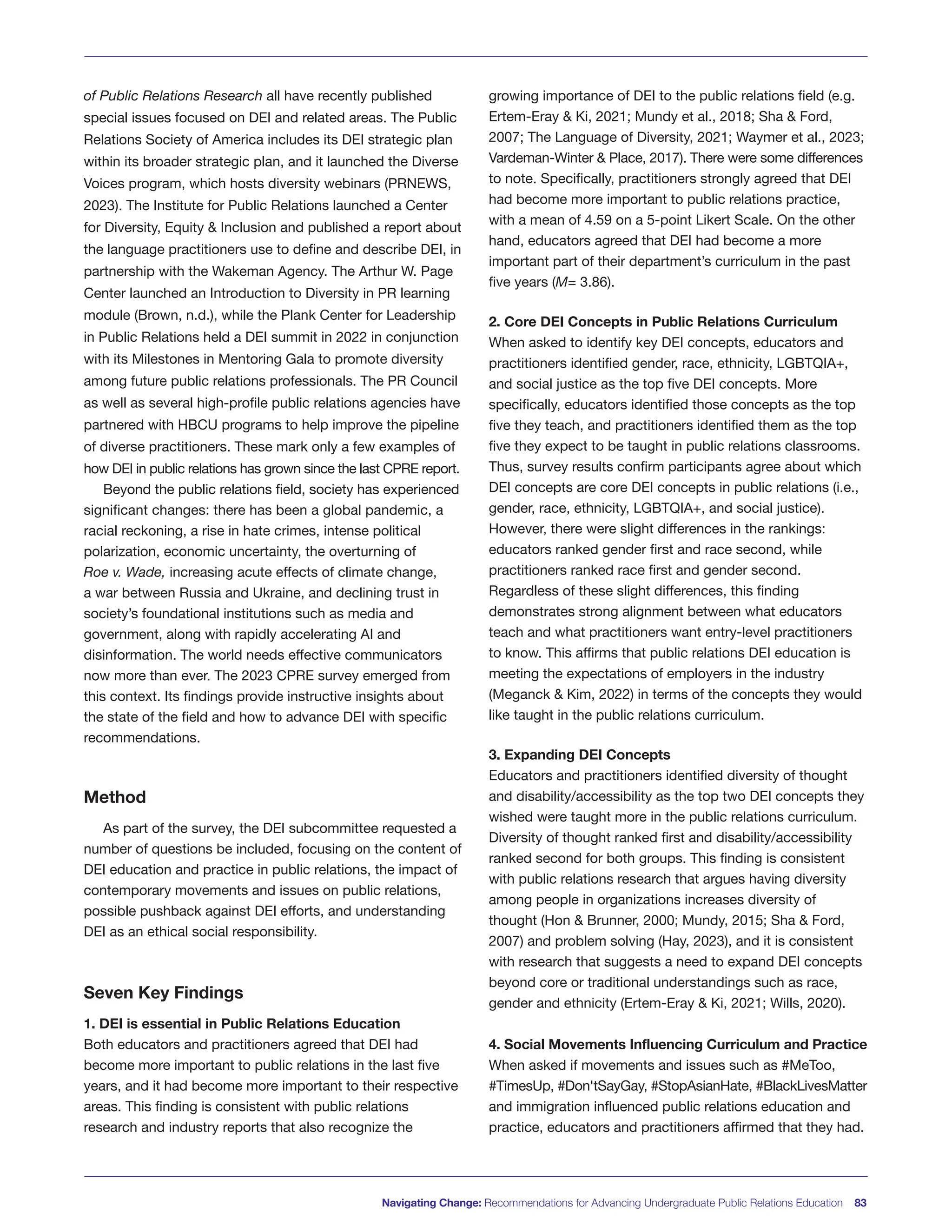

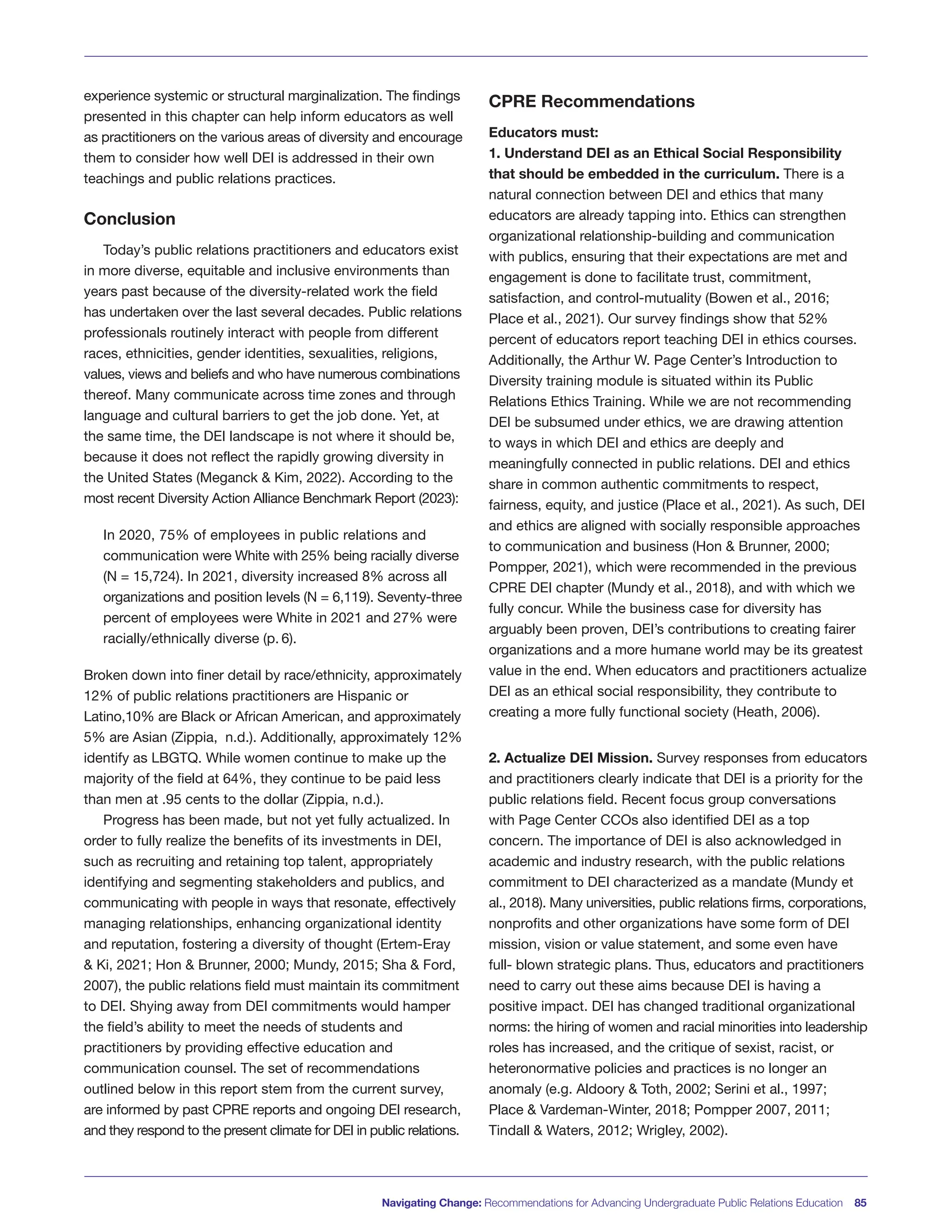



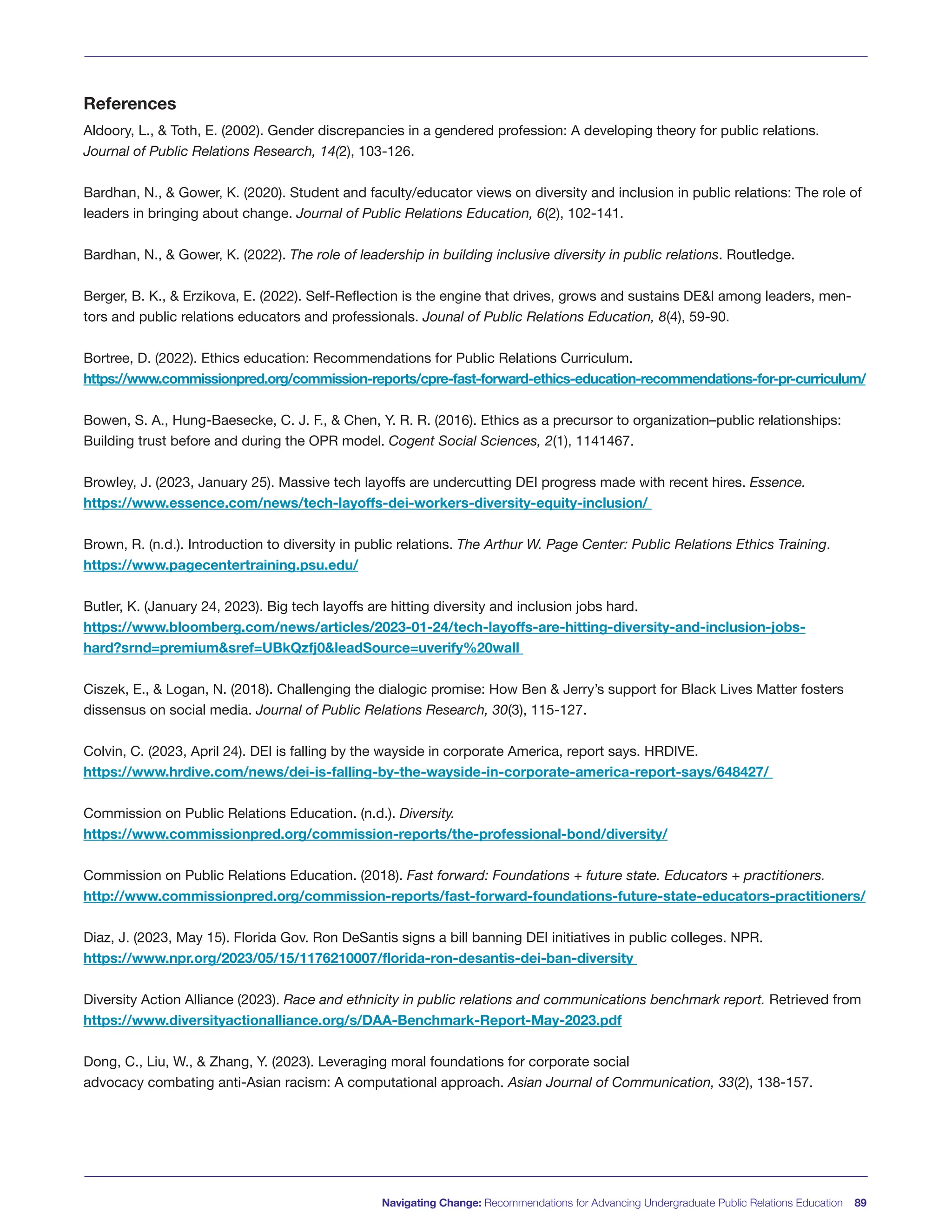

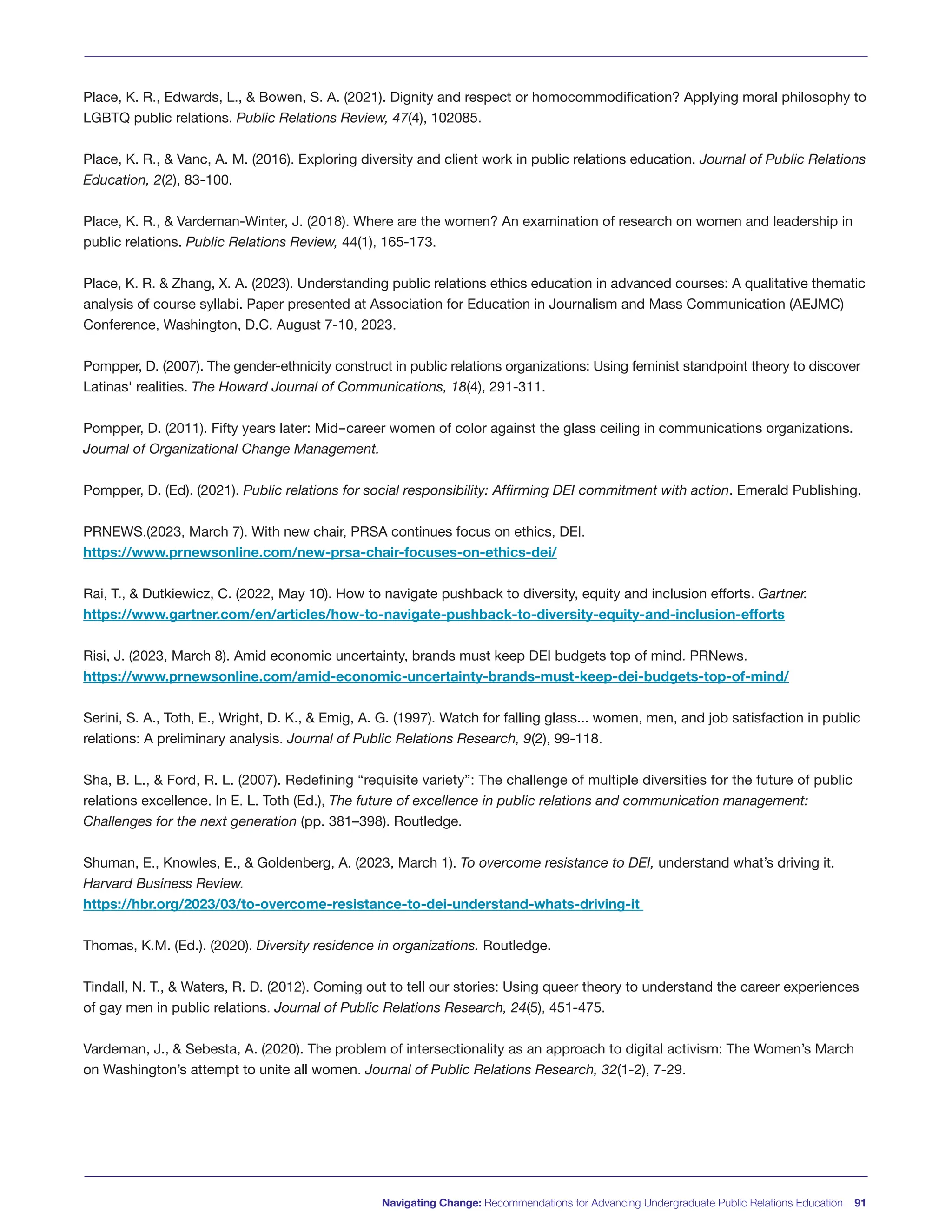

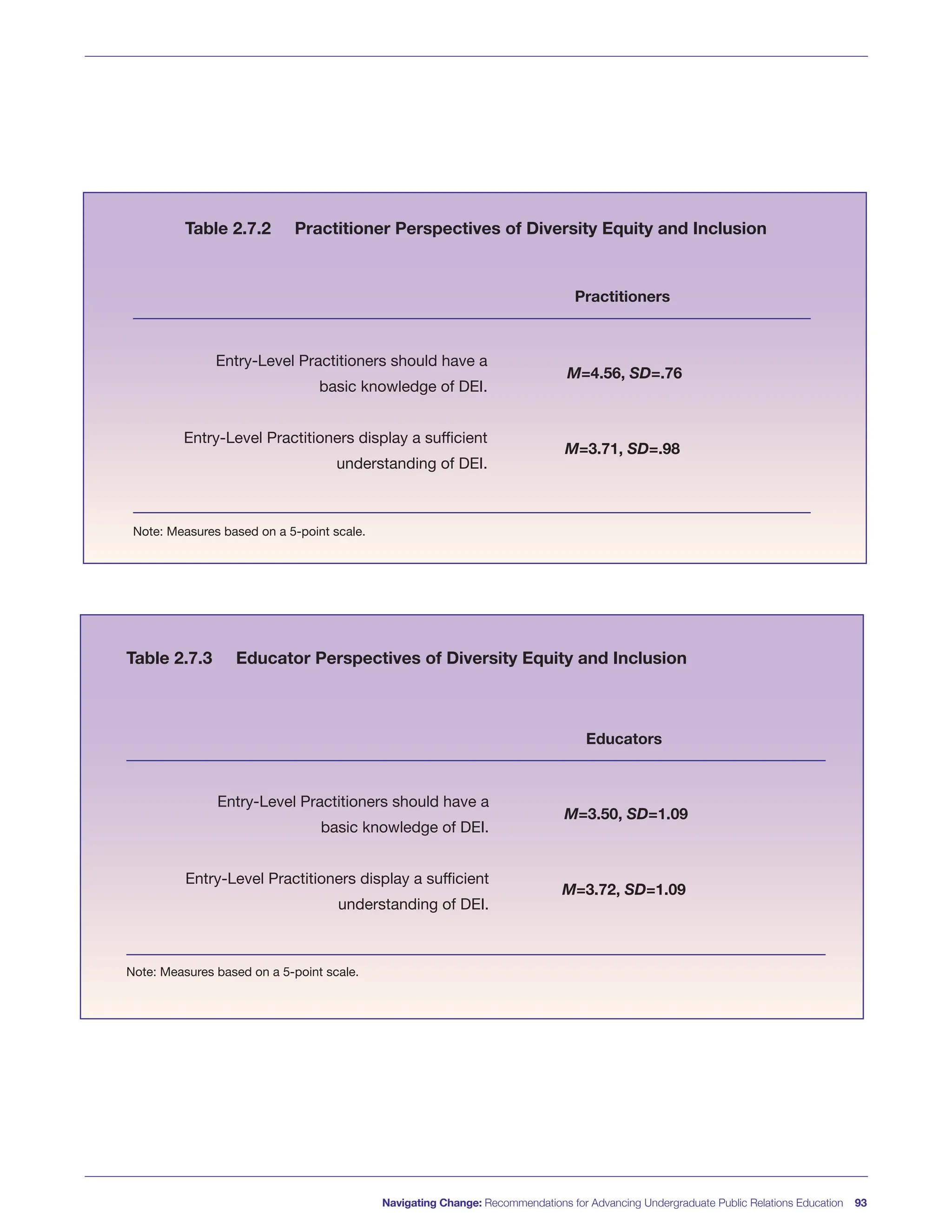
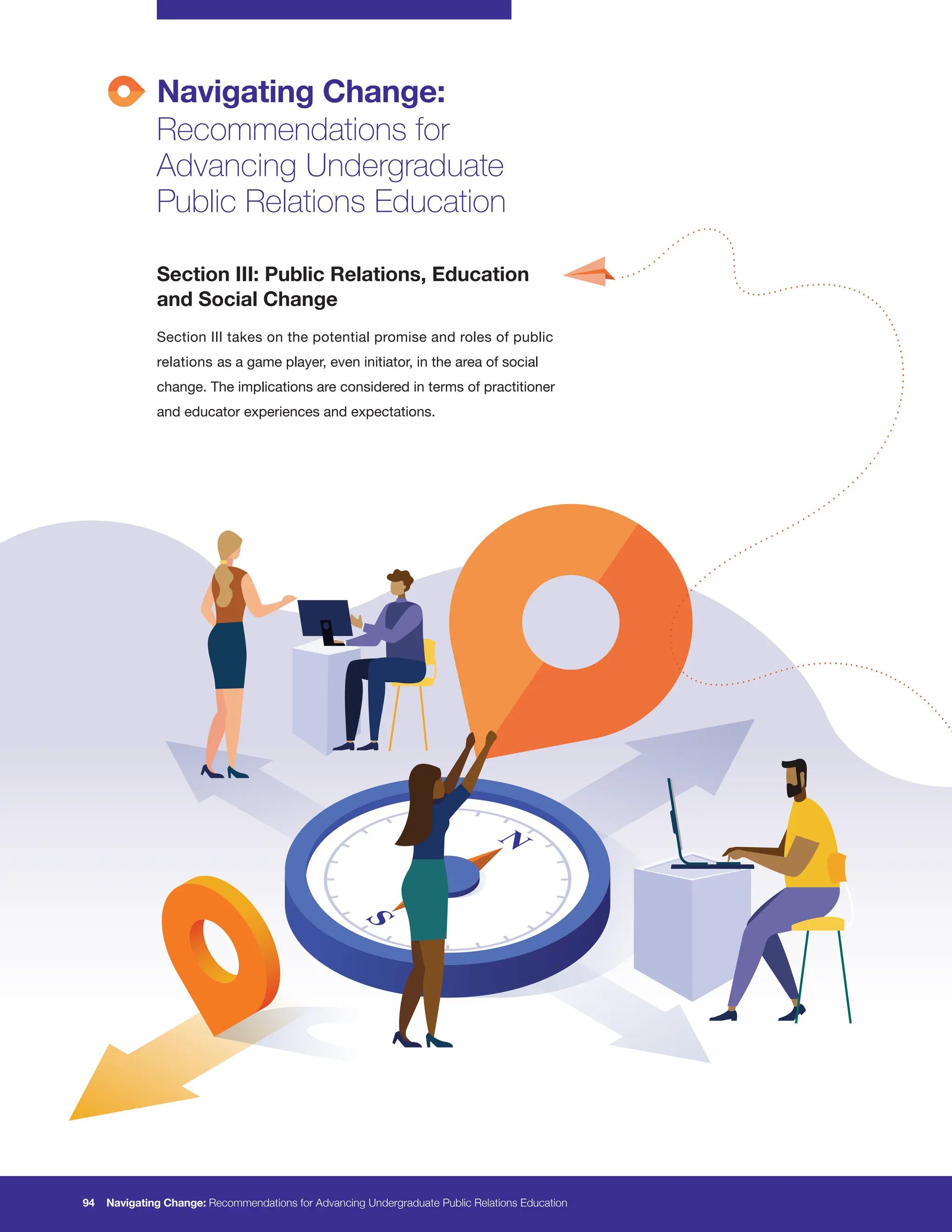



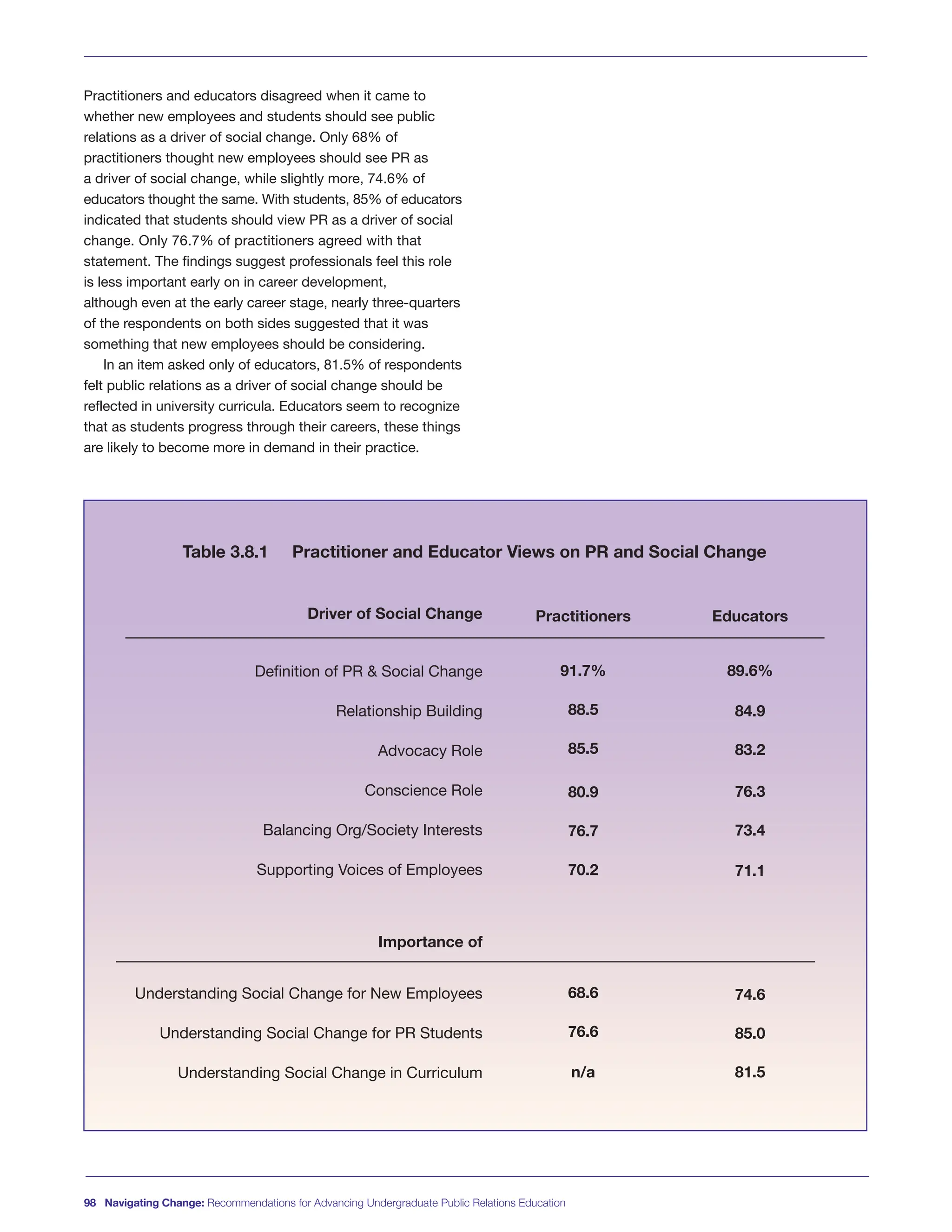
![Two focus groups of senior public relations leaders were
conducted in September 2022 as the Page Conversations.
The 13 participating practitioners were asked for their
thoughts on the idea of public relations as a driver of social
change and how they saw it in their communication practice
currently and expect it to be moving forward. The following
themes emerged from the discussions:
Relevance: Practitioners recognized the importance of driving
social change today. As one practitioner put it, “One thing
we are seeing a lot, in the world we live in, in the social and
digital environment, is relevance. If you aren’t a driver of social
change, you are not relevant, or less relevant.”
Advocacy: Driving social change is part of a practitioner’s
role as an advocate. A practitioner said, “Students need to
be aware of and cognizant of our role as advocate, driving
social change and being on the right side of history. It is
important to ingrain that early.”
Education: Some saw themselves as playing the role of
educator to both internal and external audiences. One
noted, “Helping your organization, your stakeholders,
understand an important issue—why diversity is important—
by doing that you are affecting social change.”
But at the same time, some of the practitioners recommended
that caution be applied. Being the driver of social change
had its drawbacks. One saw it as a distraction. “We need to
avoid these [issues] from being distractions and get the work
of the organization done.” Another noted that it raises the
issue of “who decides,” or in other words, “social change for
whom?” The practitioner said, “Driver of social change can
be seen as a PR person applying their own biases, so we’re
trying to avoid that with some of the new aggressive talent
coming out. They need to put their organization’s agenda
ahead of their own.”
Despite the concerns of some, the similarity in the results
from both the survey and the focus groups suggests that
integrating social change into understandings of how PR
operates is important and widely accepted. The question
then become how best to integrate more social change-oriented
content into the classroom?
Meeting the Needs of the Practice in the
Classroom
Social change often entails taking action, mobilizing
resources, and offering support in order to catalyze societal
transformation (Dumitraşcu, 2014). Over the past several
years we have seen an increase in brands and organizations
taking a stance on issues such as political alliances,
LGBTQ+ rights, race relations, and gender equity, among
others (Dimock & Wike, 2020; Barbala, 2022). What’s more,
organizations are increasingly expected to take a stand on
hot-button social, political, moral, and cultural issues by
stakeholders, including customers, employees and investors
(Maks-Solomon & Drewry, 2021). To answer this call,
organizations are responding in a variety of ways, including
through corporate advertisements that connect to key social
causes, or by issuing public statements, press releases, or
open letters explaining their stance (Sterbenk et al., 2022).
In fact, we’ve seen such actions with brands such as Ben &
Jerry’s, Nike, Disney, Airbnb, and Patagonia, among others
(Ciszek & Logan, 2018). This calls for stronger connections
between the PR classroom and the profession into which
public relations students are graduating. PR educators can
strengthen connections between the public relations classroom
and the practice where social activism is readily pursued
through a variety of mechanisms, including engaged
scholarship, values-based case studies and classroom
activities, guest speakers, and Arthur W. Page Center
teaching modules.
Engaged Scholarship
Engaged scholarship involves the generation, transmission,
and application of knowledge for the direct benefit of external
audiences in ways that align with the course or programmatic
objectives and even university values (Doberneck et al.,
2010). In engaged scholarship, faculty work directly with
the public in order to address social issues and community
needs. Providing students with hands-on experience and an
opportunity to apply their skills and knowledge in real-world
settings, engaged scholarship is a way to facilitate collaborative
projects or internships with organizations and brands that
are involved in social activism. Engaged scholarship
includes three distinguishing characteristics (Glass & Fitzgerald,
2010):
1. Engagement is scholarly: a scholarship-based
model of engagement involves both the act of
engaging–bringing universities and communities
together–and the product of engaging–spreading
discipline-generated, evidence-based practices
throughout communities.
Navigating Change: Recommendations for Advancing Undergraduate Public Relations Education 99](https://image.slidesharecdn.com/cpre50thanniversaryreportfinal-231113221518-5a26693a/75/Navigating-Change-Report-101-2048.jpg)
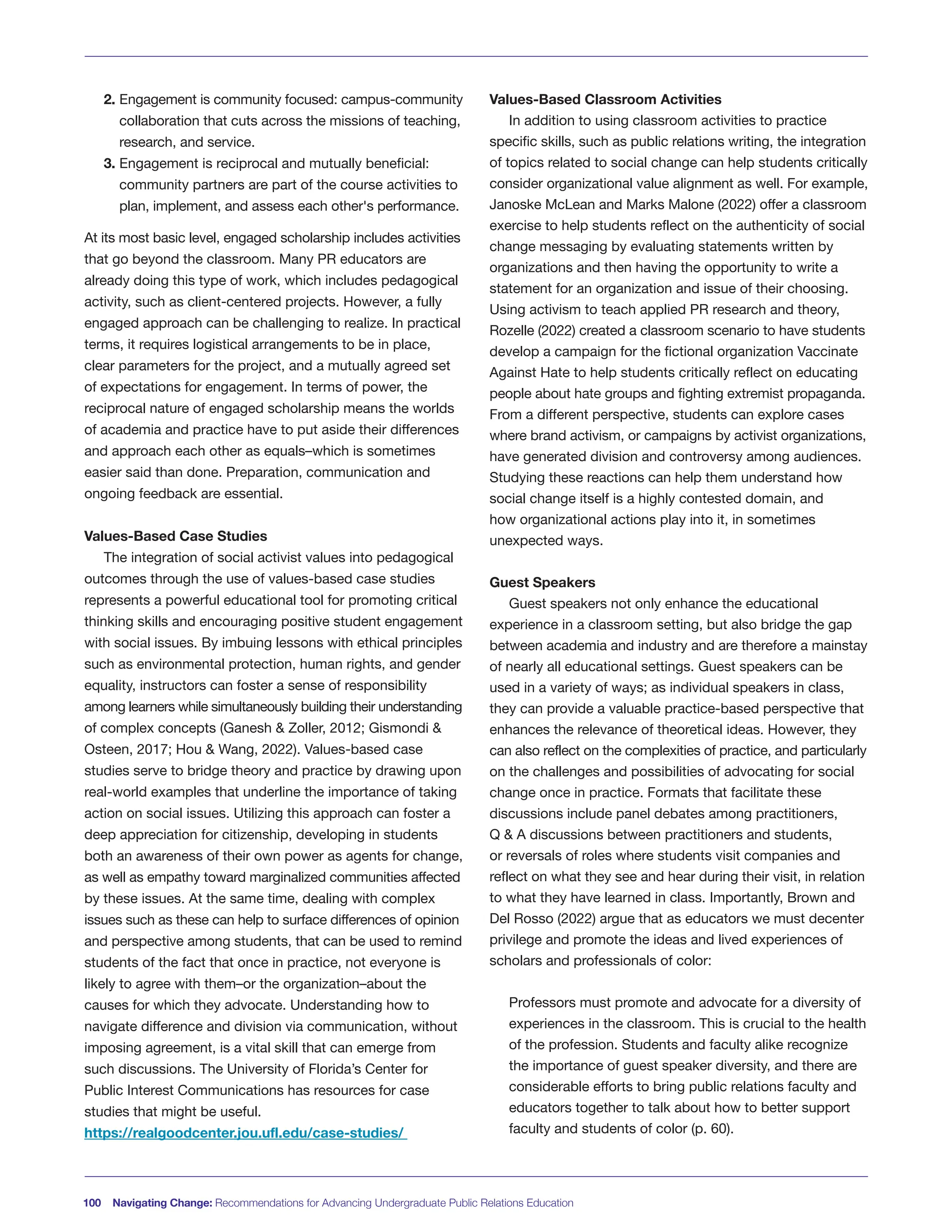
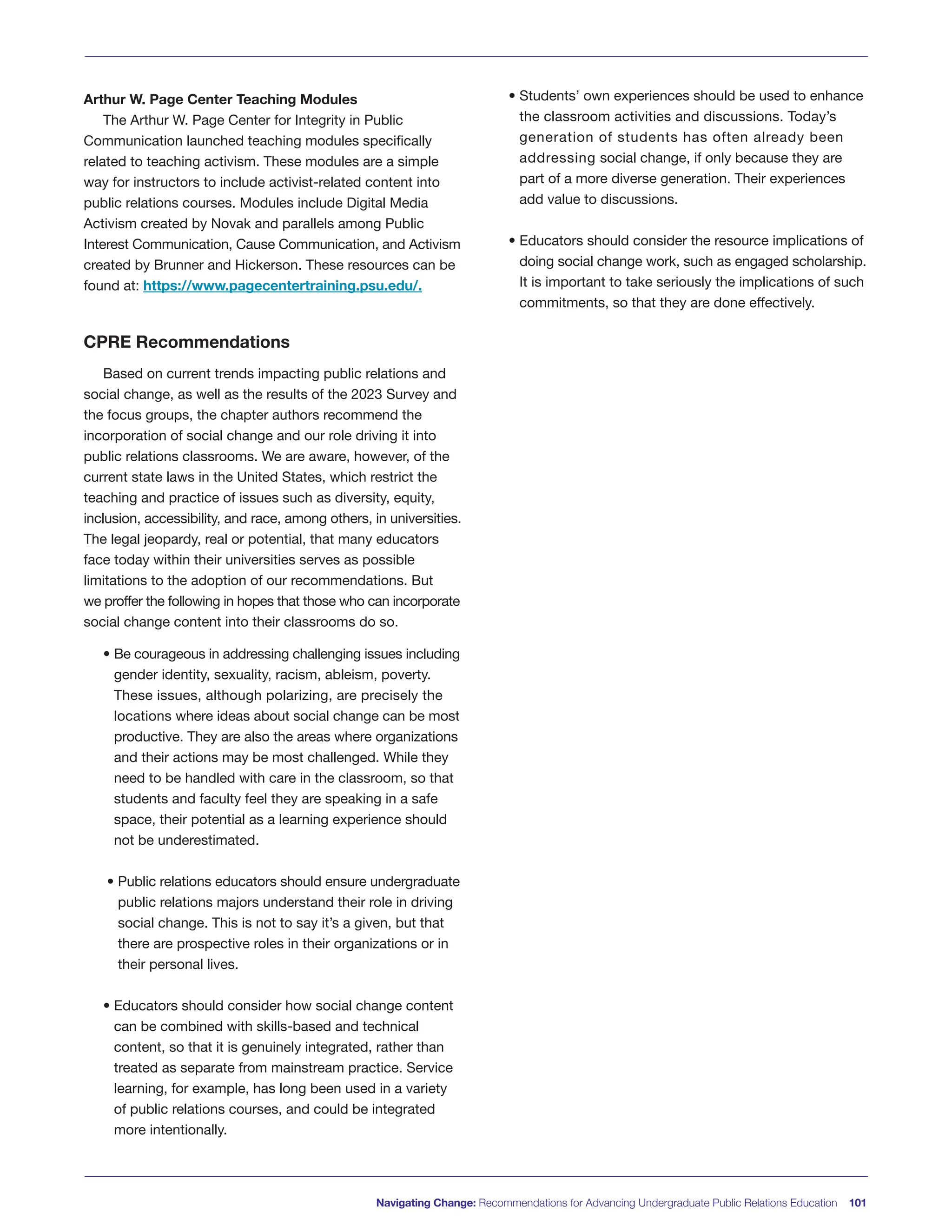


![104 Navigating Change: Recommendations for Advancing Undergraduate Public Relations Education
Somerville, I., Purcell, A., & Morrison, F. (2011). Public relations education in a divided society: PR, terrorism, and critical ped-
agogy in post-conflict Northern Ireland. Public Relations Review, 37(5), 548–555.
https://doi.org/10.1016/j.pubrev.2011.09.008.
Sterbenk, Y.M., Ward, J., Luttrell, R. and Shelton, S. (2022). Silence has no place: a framing analysis of corporate statements
about racial inequity, immigration policy and LGBTQ rights. Corporate Communications: An International Journal, 27(2), 404-421.
Shor, I. (1993). Education is politics. Paulo Freire’s critical pedagogy. In P. McLaren & P. Leonard. Paulo Freire.
A critical encounter. Routledge.
Tokita, C. K., Guess, A. M., Tarnita, C. E. (2021). Polarized information ecosystems can reorganize social networks via information
cascades. Proceedings of the National Academy of Sciences (PNAS).
Wallace, A.A., Luttrell, R., McCollough, C. (2023, May 29). Exploring feminist pedagogy: Cultivating authentic communications
curricula in project-based courses [paper presentation]. International Communication Conference (ICA). Toronto, Canada.
Waymer, D., Dyson, O. (2011). The journey into an unfamiliar and uncomfortable territory: Exploring the role and approaches
of race in PR education. Journal of Public Relations Research, 23 (4), 458-477.
https://doi.org/10.1080/1062726X.2011.605971
Wright, D.K. (1976). Social responsibility in public relations: A multi-step theory. Public Relations Review, 2(3), 24-36.
https://doi.org/10.1016/S0363-8111(76)80031-8
Wright, D.K. (1979). Professionalism and social responsibility in public relations. Public Relations Review, 5(3), 20-33.
https://doi.org/10.1016/S0363-8111(79)80025-9](https://image.slidesharecdn.com/cpre50thanniversaryreportfinal-231113221518-5a26693a/75/Navigating-Change-Report-106-2048.jpg)




